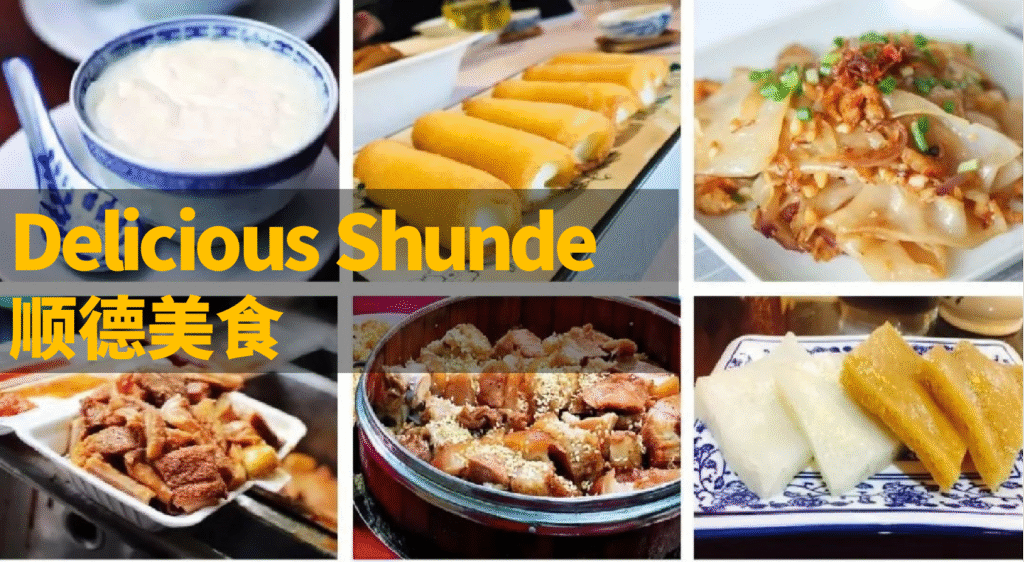A Food Lover’s Guide to Shunde
Your ultimate culinary and cultural journey through the UNESCO City of Gastronomy. Prepare to eat your way through a food lover’s paradise!
Foreword: A Culinary Pilgrimage
Welcome, fellow food adventurer! Your trusted guide to Guangdong’s culinary treasures is back, and this time, we’re diving deep into a place where food is not just sustenance, but an art form: Shunde.
If you picture China’s gastronomic map, Guangdong province stands out as a highland of flavor. Within this region, Shunde is the undisputed pinnacle, the very tip of the pyramid. It’s a place officially recognized by UNESCO as a “City of Gastronomy,” a title it wears with pride. Here, restaurants line every street, legendary chefs are born, and the local cuisine is celebrated far and wide. Many travelers come to Shunde not for its sights, but purely for the unforgettable taste experiences it offers.
As the old saying goes, “Eat in Guangzhou,” but the full phrase continues, “Cook in Fengcheng (an old name for Shunde).” This reveals a profound truth: Shunde is the cradle of Cantonese culinary excellence. Get ready to explore it.
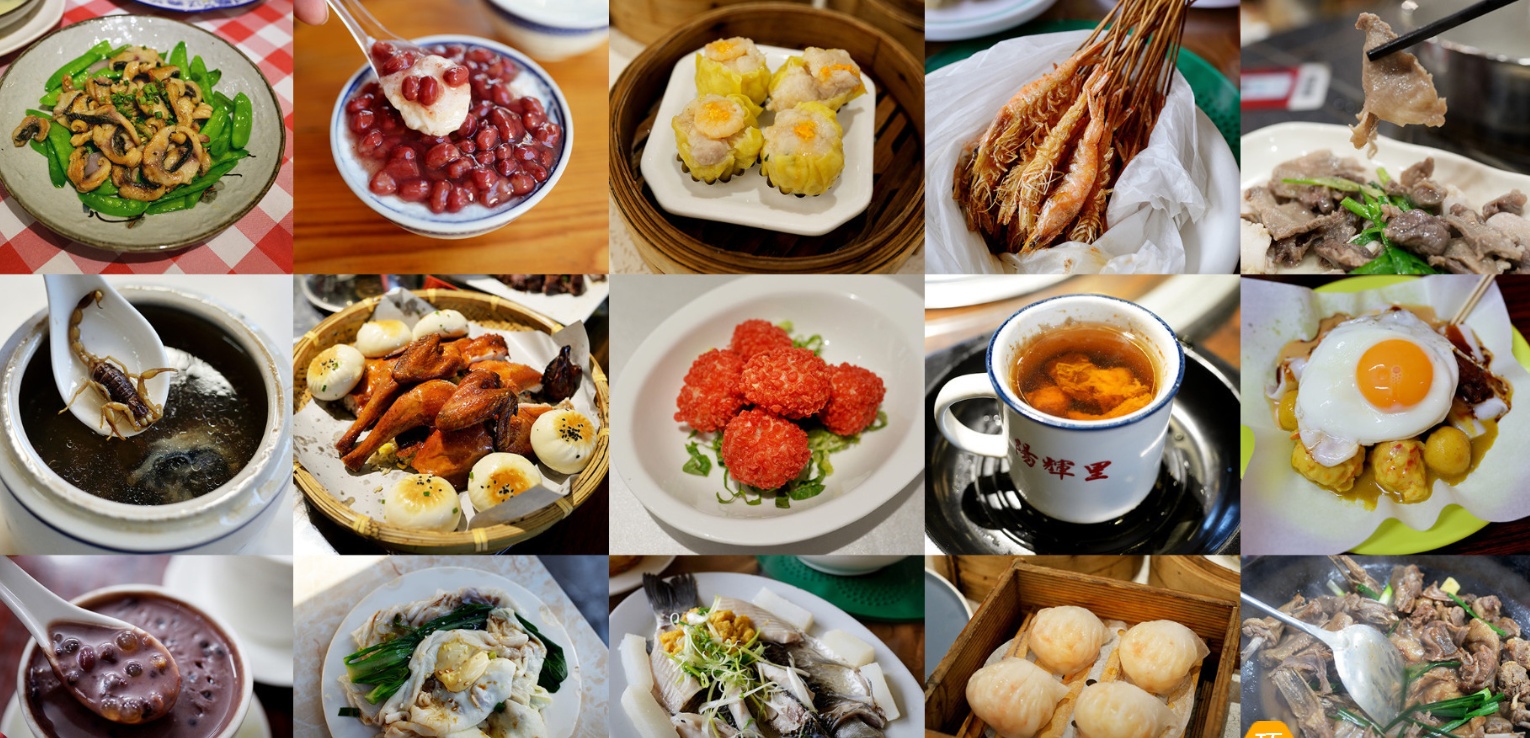
Your Trip Essentials
To help you plan your own journey, here are the vital statistics from this unforgettable trip. Use this as a blueprint for your own Shunde adventure.
- Trip Duration 5 Days
- Travel Style Family Trip
- Average Cost 1200 RMB / Person
✈️ Plan Your Trip to the Food City
Most travelers fly into Guangzhou (CAN) and take a short high-speed train or taxi to Shunde. Check distinct flights and trains here:
🧳 China Travel Toolkit: Before You Go
Shunde is a local city where cash is rarely used and English is limited. Make sure you are prepared:
- 💳 Payment is Crucial: Don’t get stuck! Learn How to Link International Credit Cards to Alipay/WeChat.
- 📱 Stay Connected: You will need maps and translation. Check our guide on eSIMs vs Local SIMs and the Best Apps for China Travel.
- 🛂 Visa Check: Ensure your entry is smooth with our Latest Visa-Free Policy Guide.
Shunde | The Quest for Flavor
This guide is the culmination of a second, deeper exploration of Shunde. It’s a “version 2.0” of my culinary map, updated and refined for you. While I’ve visited many famous spots before, this journey uncovered new gems and revisited old favorites. This guide is packed with practical tips, covering everything from must-try dishes to navigating the city. Whether you’re a first-timer or a returning enthusiast, you’ll find valuable insights here. Let the feast begin!
The Ultimate Food Map: Main Courses & Signature Dishes
Now, we get to the heart of the matter. Here is your detailed guide to the restaurants that define Shunde’s culinary scene. We begin with a local legend.
01. Song Kee Eatery (松记食店)
The temple of “Clear Broth Hot Pot,” where the purity of ingredients reigns supreme. This isn’t just a meal; it’s a ritual.
Prepare yourself, for a visit to Song Kee in the Ronggui district is not just a meal; it’s a pilgrimage to the heart of Shunde’s culinary philosophy. With over thirty years of history, this celebrated eatery has transcended its local fame to become a legend, earning a spot on countless “must-eat” lists and even a former Black Pearl diamond. This is, without exaggeration, one of the most unmissable food experiences in Shunde.
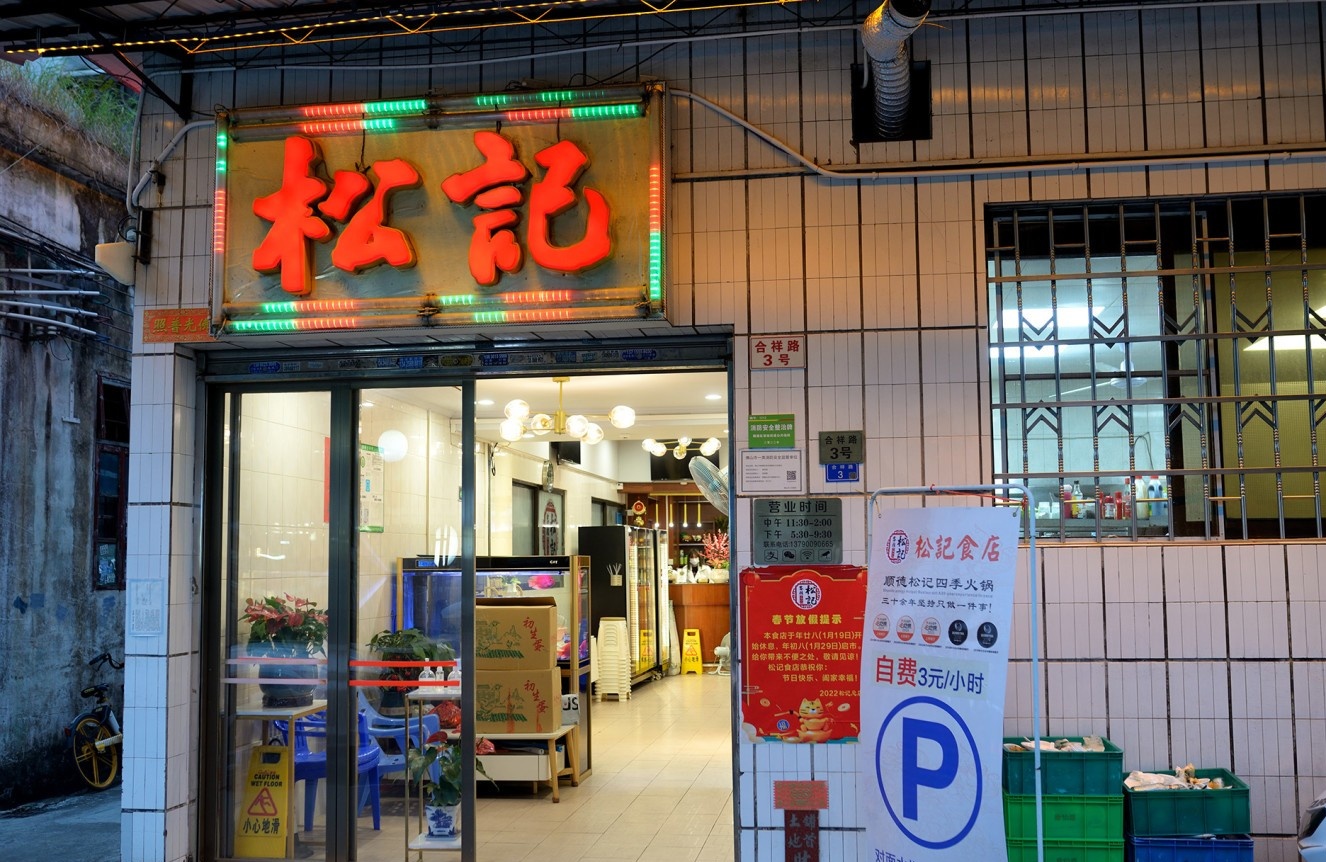
The Philosophy: A Cauldron of Pure Water
Forget the heavy, overpowering broths you might be used to. At Song Kee, the hot pot base is shockingly simple: a pot of clear, boiling water. This is the ultimate expression of confidence in Shunde, a tradition born from a deep respect for the ingredient’s true flavor.
“In Shunde, the purest water is the ultimate test of the finest ingredients. Only the absolute freshest, highest-quality pork offal can withstand this trial by fire—or rather, by water.”
The local palate in this part of the Pearl River Delta is famously discerning, especially when it comes to pork offal (猪杂). The meticulousness with which they select, clean, and slice each part rivals the legendary precision of Chaoshan chefs with their beef. Here, the ingredients are the stars, and the clear broth is the stage that allows them to shine.
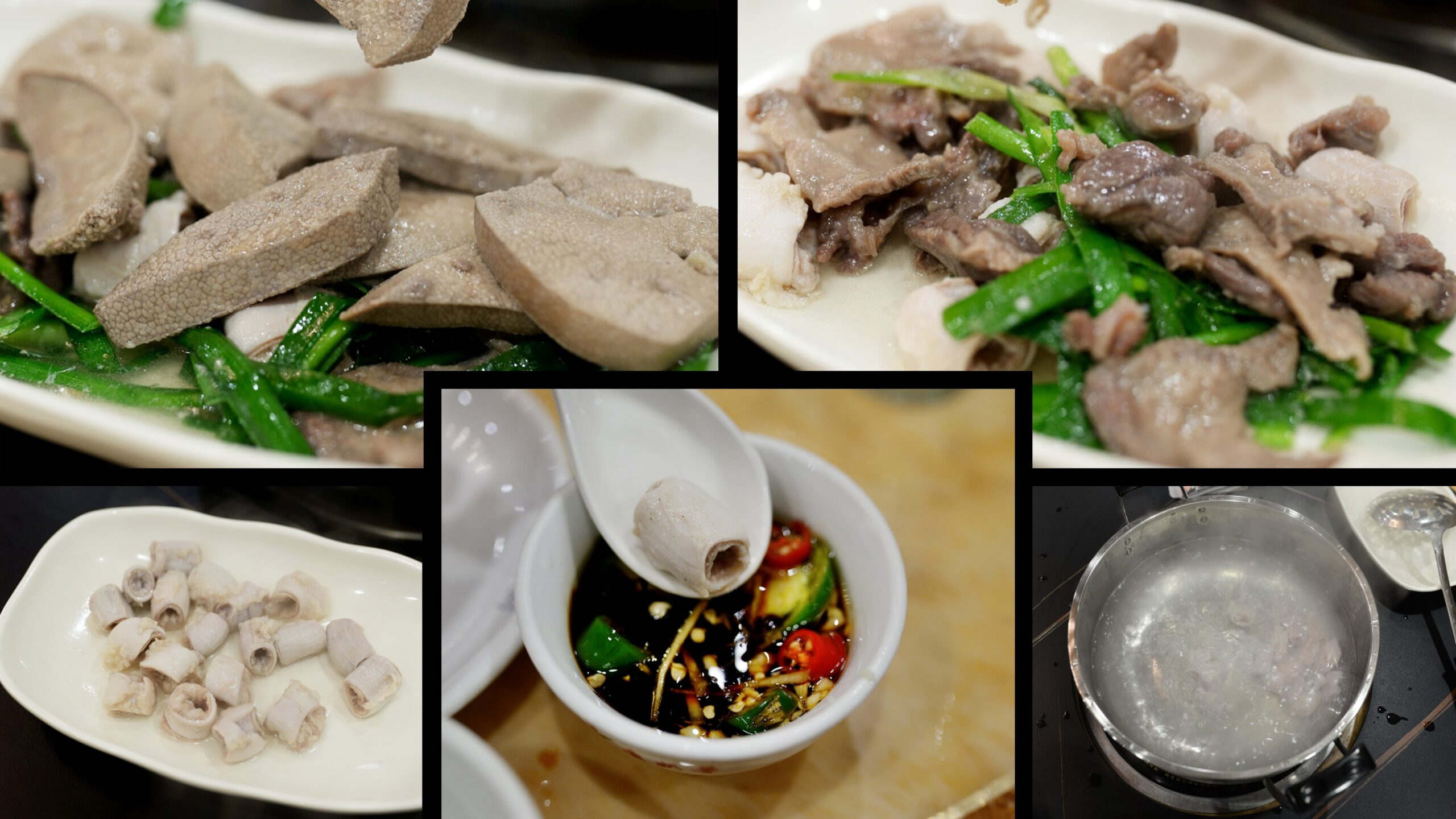
The Experience: Let the Experts Guide You
Don’t worry about cooking times or techniques. A key part of the Song Kee experience is that the staff cooks everything for you. They are masters of their craft, expertly blanching each ingredient for the precise number of seconds required to achieve its peak texture and flavor. You are simply there to witness the magic and enjoy the results at their absolute best.
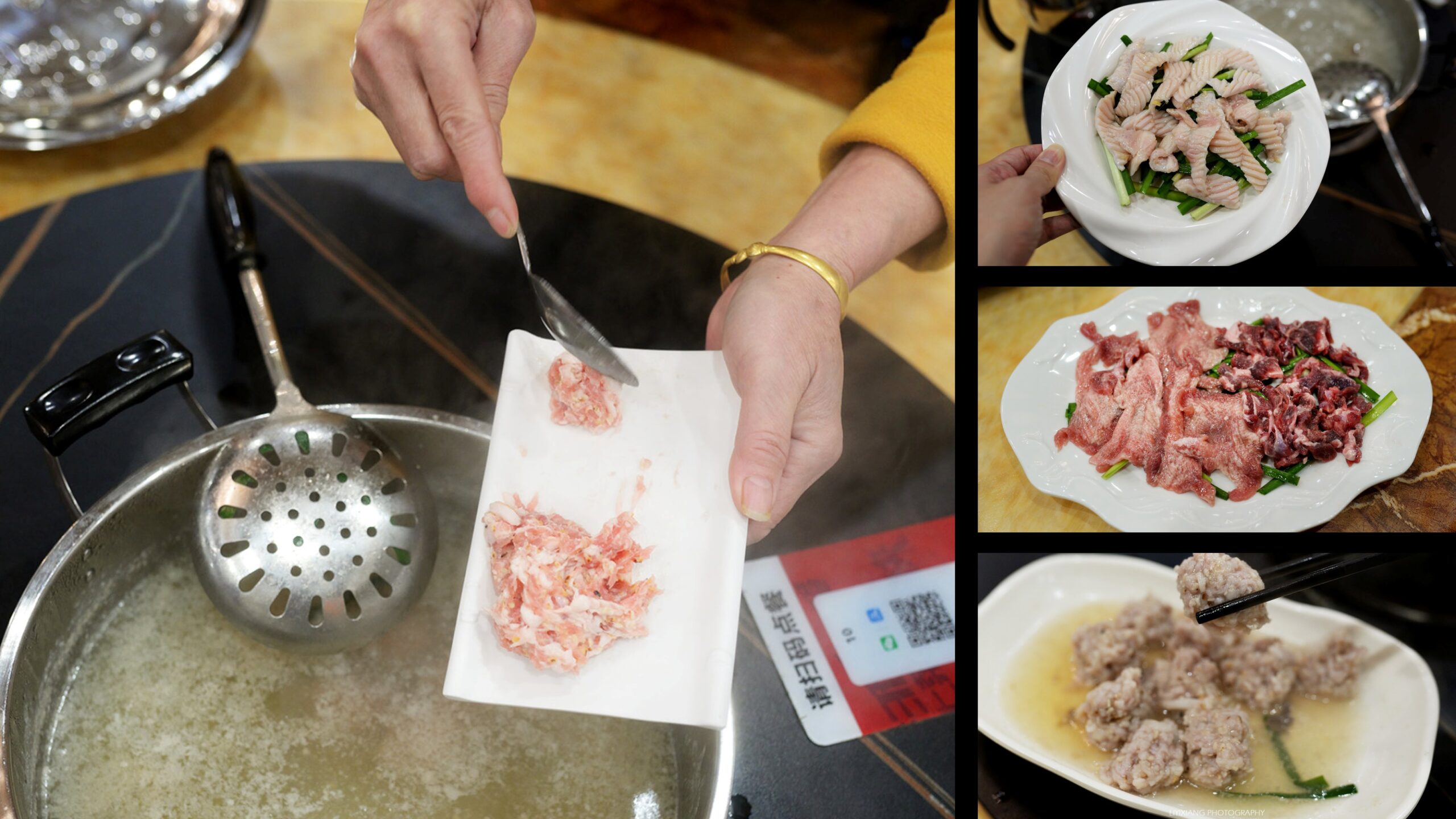
At a Glance
- Address:合祥路3号 (No. 3, Hexiang Road, Ronggui District)
- Avg. Cost: ¥90 per person
- Must-Try Dishes: Signature Pork Liver, Signature Bamboo Intestine, Pork Palate (Zhu Tianti), Hand-minced Pork Paste, Beef Tongue Base, Glutinous Rice Mochi.
02. Yanghuili Specialty Shunde Cuisine (阳辉里·特色顺德菜)
An innovative kitchen that respects tradition while daring to create something new. A top-rated spot that lives up to the hype.
Located in the Lunjiao district, Yanghuili has transformed a historic red-brick factory into one of Shunde’s most talked-about dining destinations. The industrial-chic ambiance provides a unique backdrop for a menu that is both traditional and brilliantly creative. This is where you come for their legendary signature dish, the “Ji Bao Fan,” a clever and hearty platter that has earned the restaurant a spot on numerous “must-eat” lists. This is where industrial heritage meets culinary innovation, serving a dish that’s a feast for both the eyes and the palate.
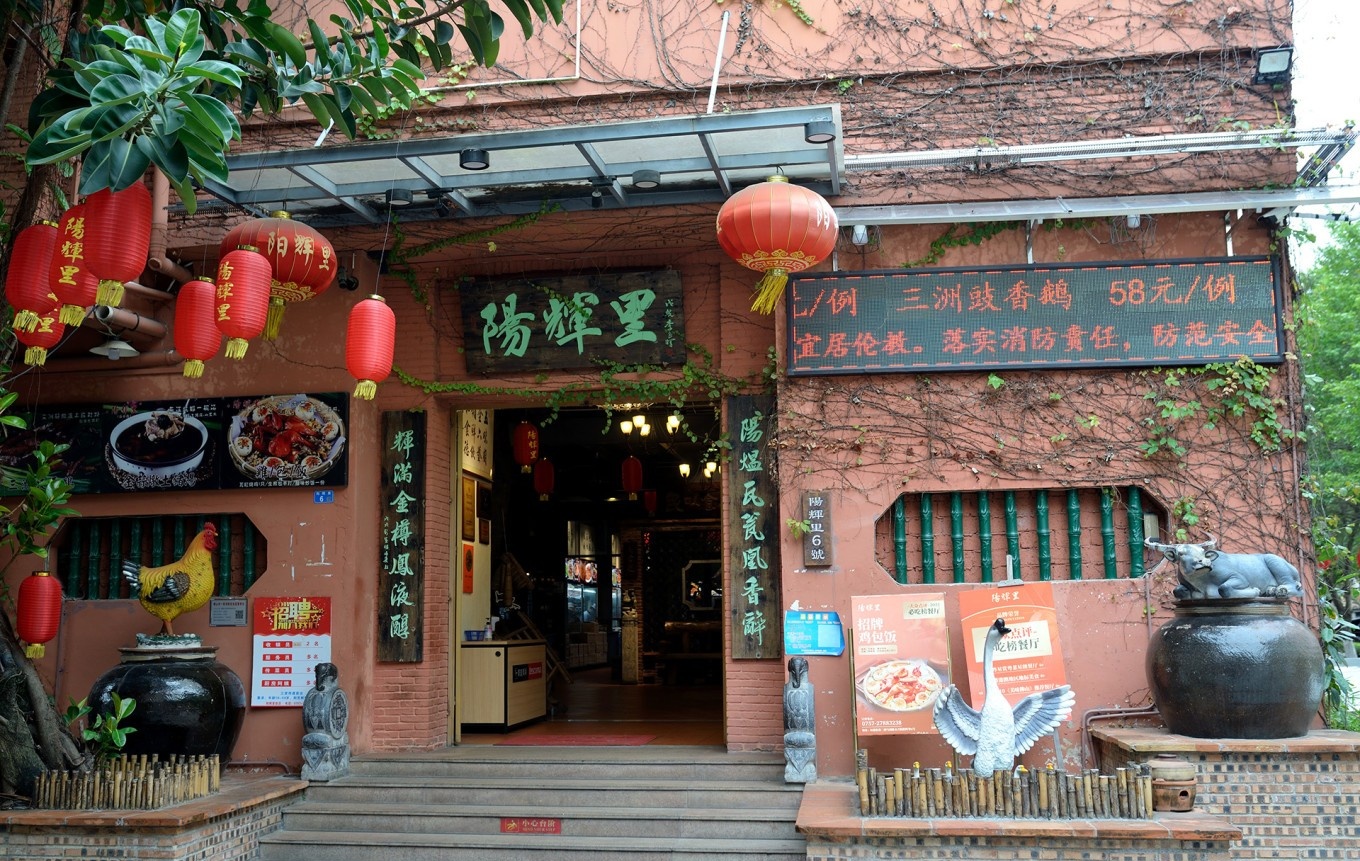
The “Ji Bao Fan” (鸡包饭): A Trio of Delights
The name “Chicken Wrapped Rice” is a playful misnomer. It’s not a chicken stuffed with rice, but a magnificent trio of dishes served together, each a star in its own right. It’s a complete, satisfying meal on one platter.
1. The Clay Pot Roast Chicken (瓦缸烧鸡): The centerpiece is a whole Sanhuang chicken, roasted in a clay pot until its skin is glistening, golden, and shatteringly crisp (`香脆干身`). Yet, the meat beneath remains incredibly tender, soft, and bursting with juice (`软嫩多汁`). It’s so good that nearly every table orders it.
2. The Pan-fried Buns (梅菜叉烧煎包): Served piping hot, these fluffy buns have a perfectly seared golden-brown bottom. They are filled with a delicious mixture of sweet char siu and savory preserved mustard greens (`梅菜`), which cuts through the richness and adds a layer of complex umami.
3. The Fragrant Fried Rice (腊味炒饭): The foundation of the dish is a bed of fried rice with Chinese preserved meats. The rice is cooked so each grain is distinct (`粒粒分明`), but its true genius lies in its placement. Positioned directly under the chicken, it soaks up all the flavorful drippings (`鸡油`), transforming it into an intensely aromatic and irresistible base for the entire meal.
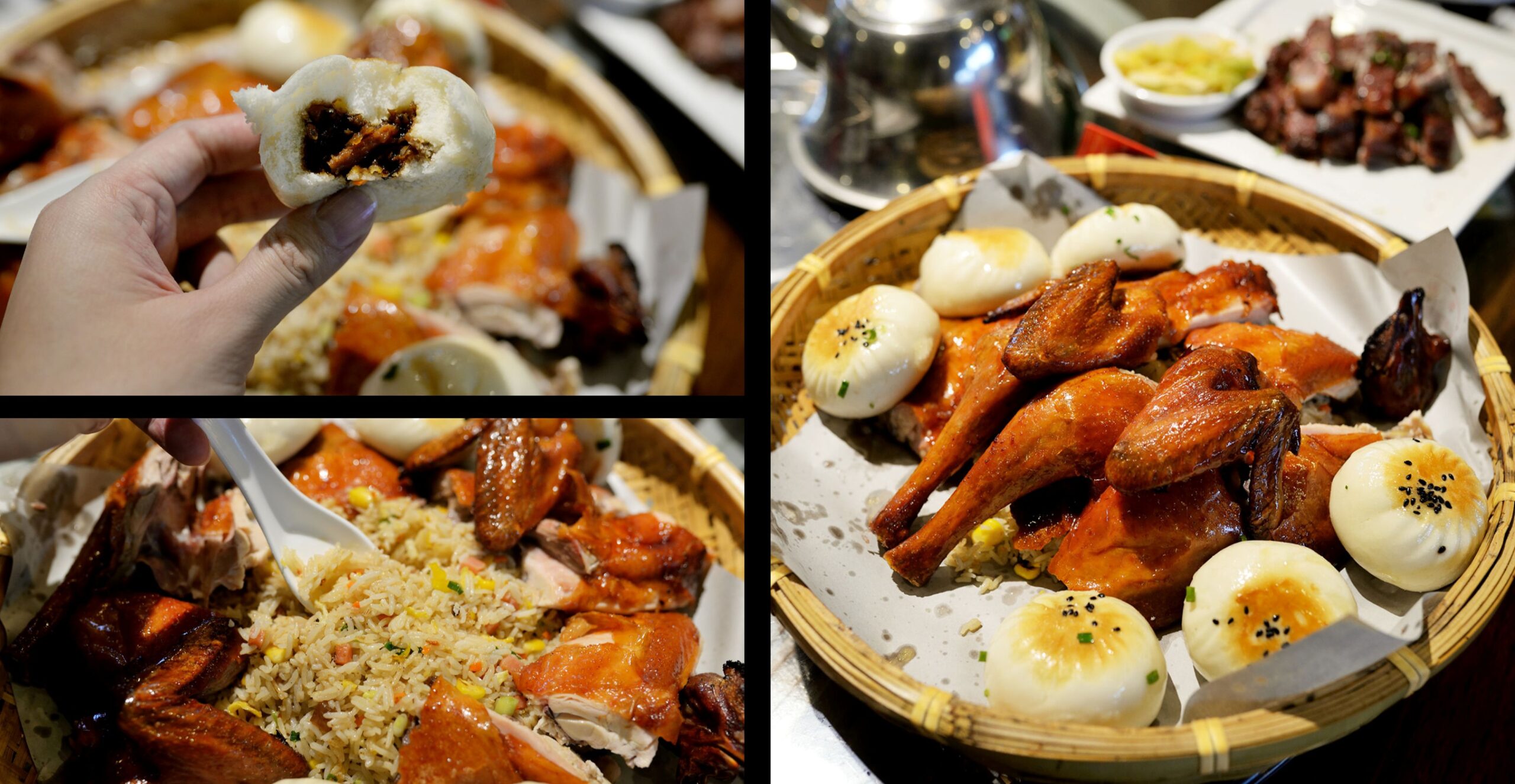
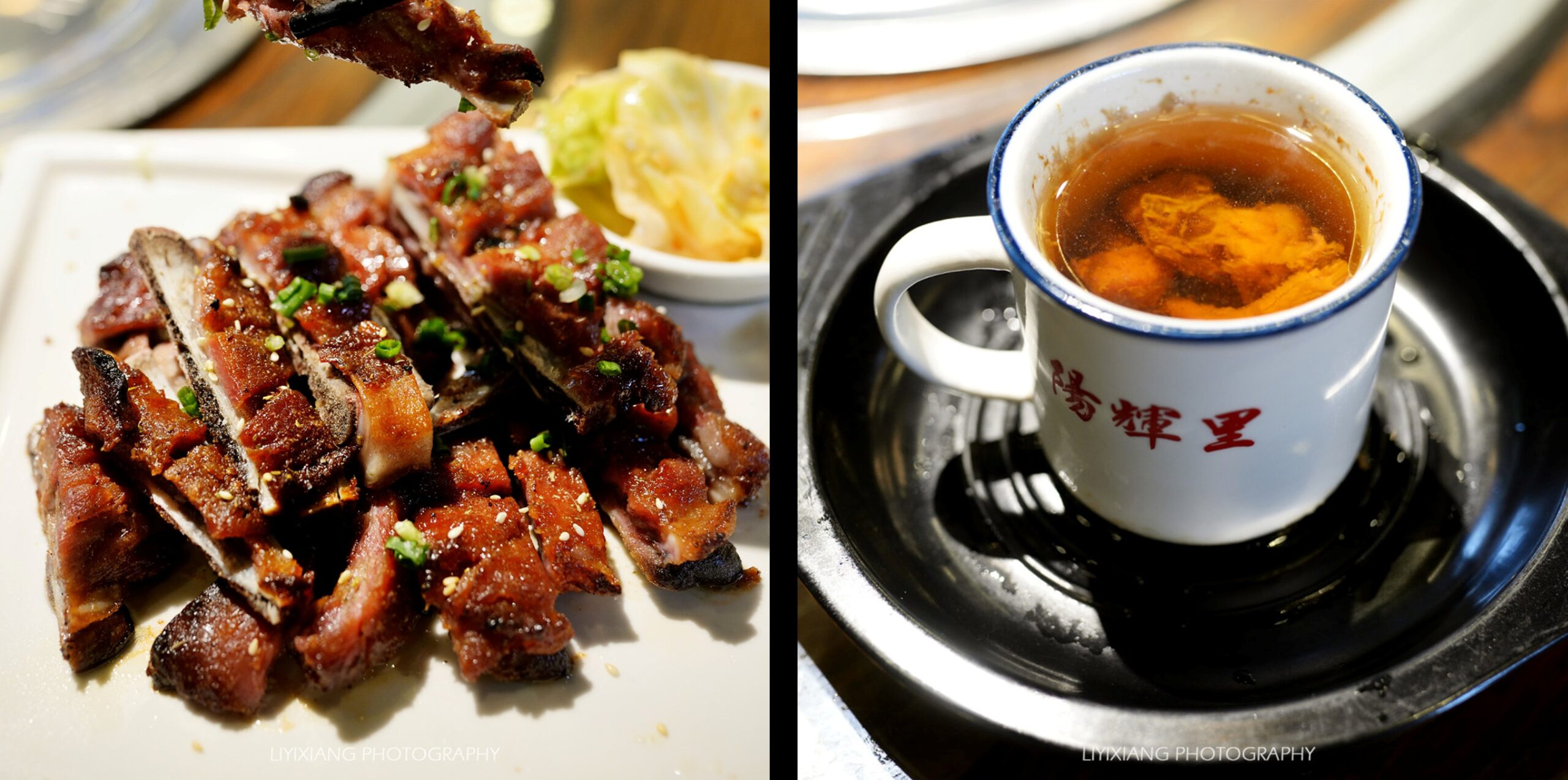
At a Glance
- Address: 顺德区伦教熹涌康路二街1号 (No. 1, Kanglu Erjie, Xiyong, Lunjiao, Shunde)
- Avg. Cost: ¥80 per person
- Must-Try Dishes: The “Ji Bao Fan” (鸡包饭) platter is essential.
03. Tianranju – Natural Residence (天然居)
Tucked away in a quieter part of the Lunjiao district, Tianranju is a true hidden gem highly recommended by locals. Forget the hustle of the city; this restaurant feels like stepping into a private garden. Its courtyard sits beside a small river, evoking the idyllic scenery of “small bridges, flowing water, and riverside homes” (`小桥流水人家`). This is where masterful, home-style cooking is served in a tranquil, rustic setting, showcasing the quiet confidence of Shunde’s culinary heritage.
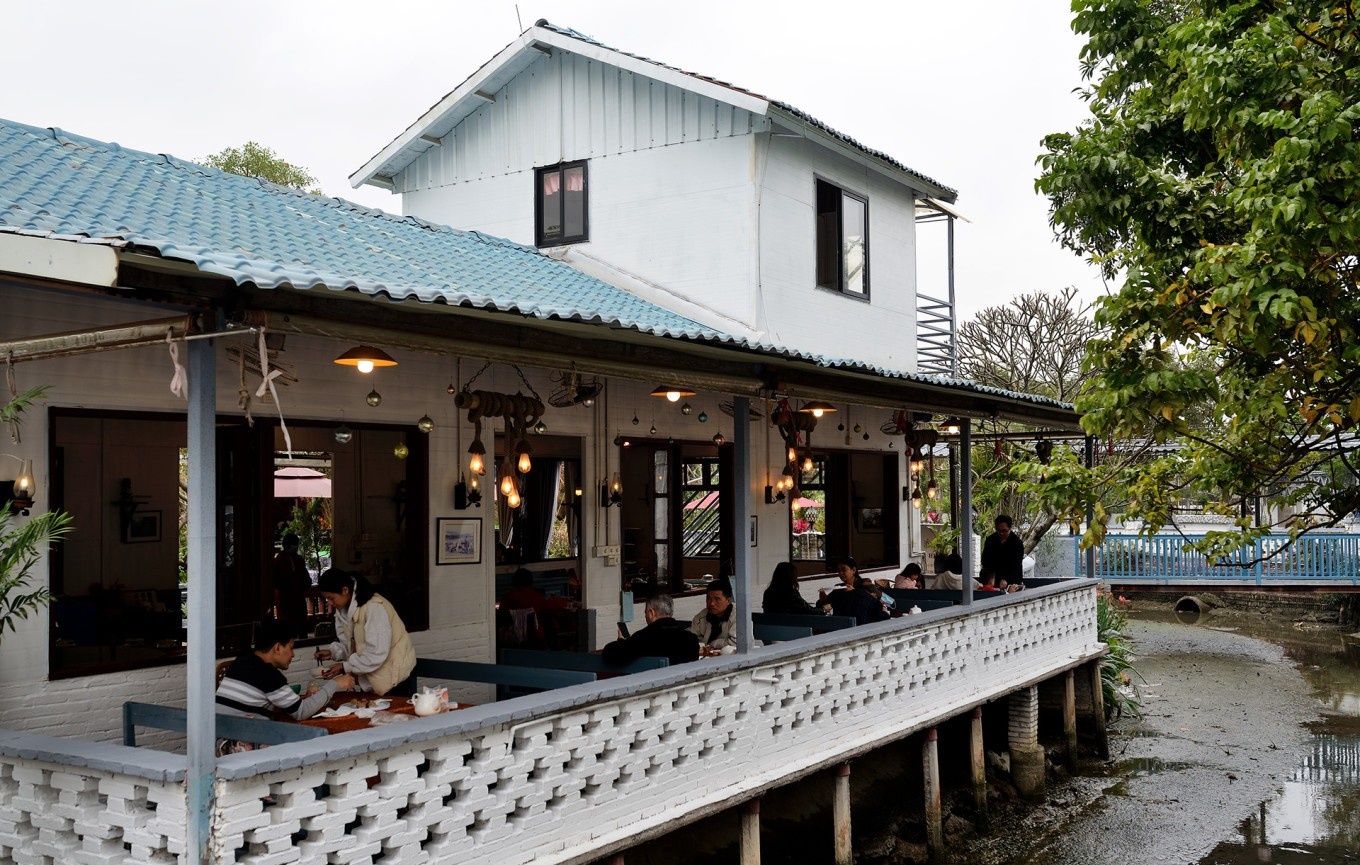
The Magic of the Boneless Fish: Steamed Crucian Carp (盐油水蒸无骨鲫鱼)
This dish is a testament to the legendary knife skills of Shunde chefs. Crucian carp is notoriously filled with countless tiny, intramuscular bones, making it challenging to eat. Here, however, the chefs perform a culinary miracle. Through breathtakingly precise knife work, they debone the entire fish (`骨肉分离`), leaving only the main spine. It’s then prepared in the most classic Shunde way: steamed simply with salt, oil, and water (`盐油水蒸`).
This minimalist approach allows the natural, delicate sweetness of the fresh fish to shine through. You can savor every mouthful of the tender flesh without a single worry about tiny bones—an experience that is nothing short of amazing.
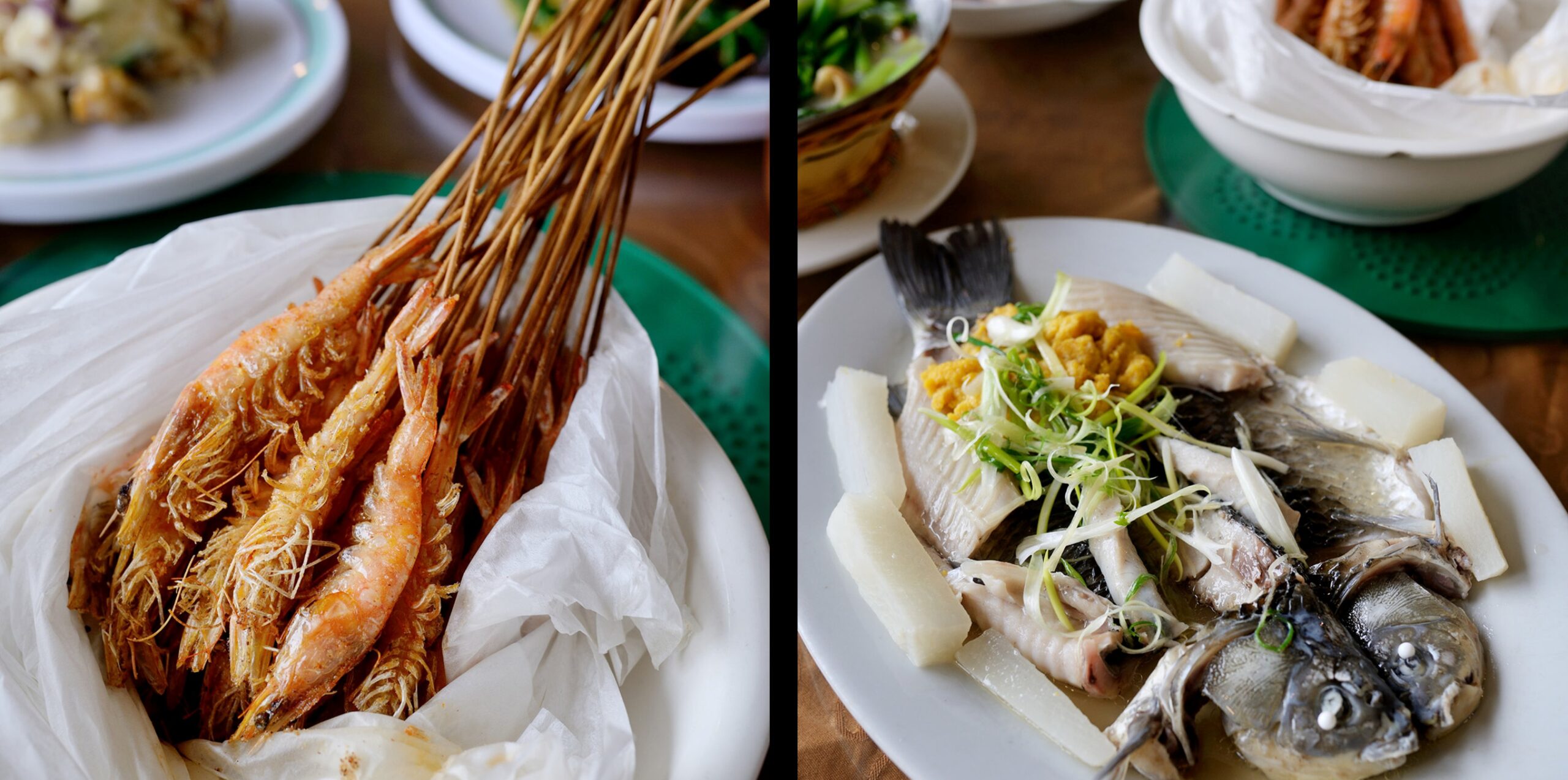
Crispy, Savory, and Eaten Whole: Salt-Impaled Shrimp (盐插虾)
Another signature dish, the Salt-Impaled Shrimp, offers a delightful contrast in texture and flavor. The fresh shrimp are flash-fried and then salt-baked (`走油后盐焗`), a method that imparts a much deeper flavor than simple boiling. The process makes the shells incredibly thin and crispy (`咸香酥脆`), so much so that you can eat them whole without peeling!
The savory shell gives way to sweet, succulent shrimp meat inside, a testament to the freshness of the ingredients. The portion is also famously generous, making it a satisfying and highly recommended choice.
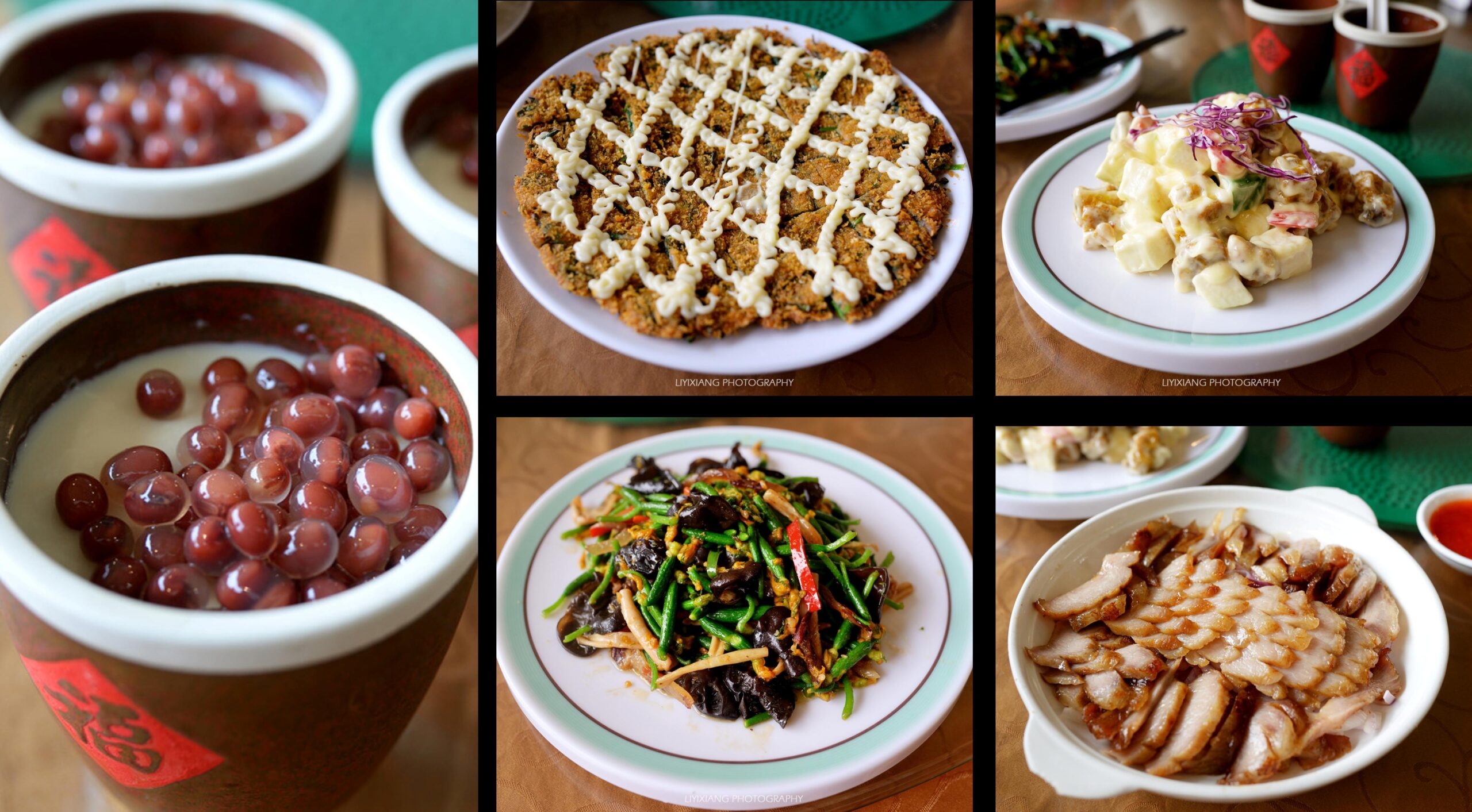
Don’t Miss: Grilled Pork Jowl (猪颈肉)
As a perfect complement to the seafood, the grilled pork jowl is a must-order. With its ideal balance of fat and lean meat (`肥瘦相间`), the texture is wonderfully springy and chewy (`弹牙`). Served with a tangy sweet and sour sauce, it’s an irresistibly delicious dish.
At a Glance
- Location: 顺德区伦教 (Lunjiao District, Shunde)
- Avg. Cost: ¥110 per person
- Must-Try Dishes: Steamed Boneless Crucian Carp (盐油水蒸无骨鲫鱼), Salt-Impaled Shrimp (盐插虾), Grilled Pork Jowl (猪颈肉).
04. Longqiao Private Kitchen (龙桥私厨)
Experience the artistry of Shunde cuisine, where fresh fish is transformed into a culinary masterpiece.
Your culinary adventure continues as you venture into a quiet village in Ronggui, searching for a place that rewards the curious. From the outside, Longqiao Private Kitchen might seem like a humble farmhouse eatery (农家乐), but step through its doors and you’ll discover a different world. The warm lighting and thoughtful decor create an intimate, cozy atmosphere that immediately tells you this is a place of passion. Here, the essence of Shunde cuisine is not just preserved; it’s playfully reimagined.
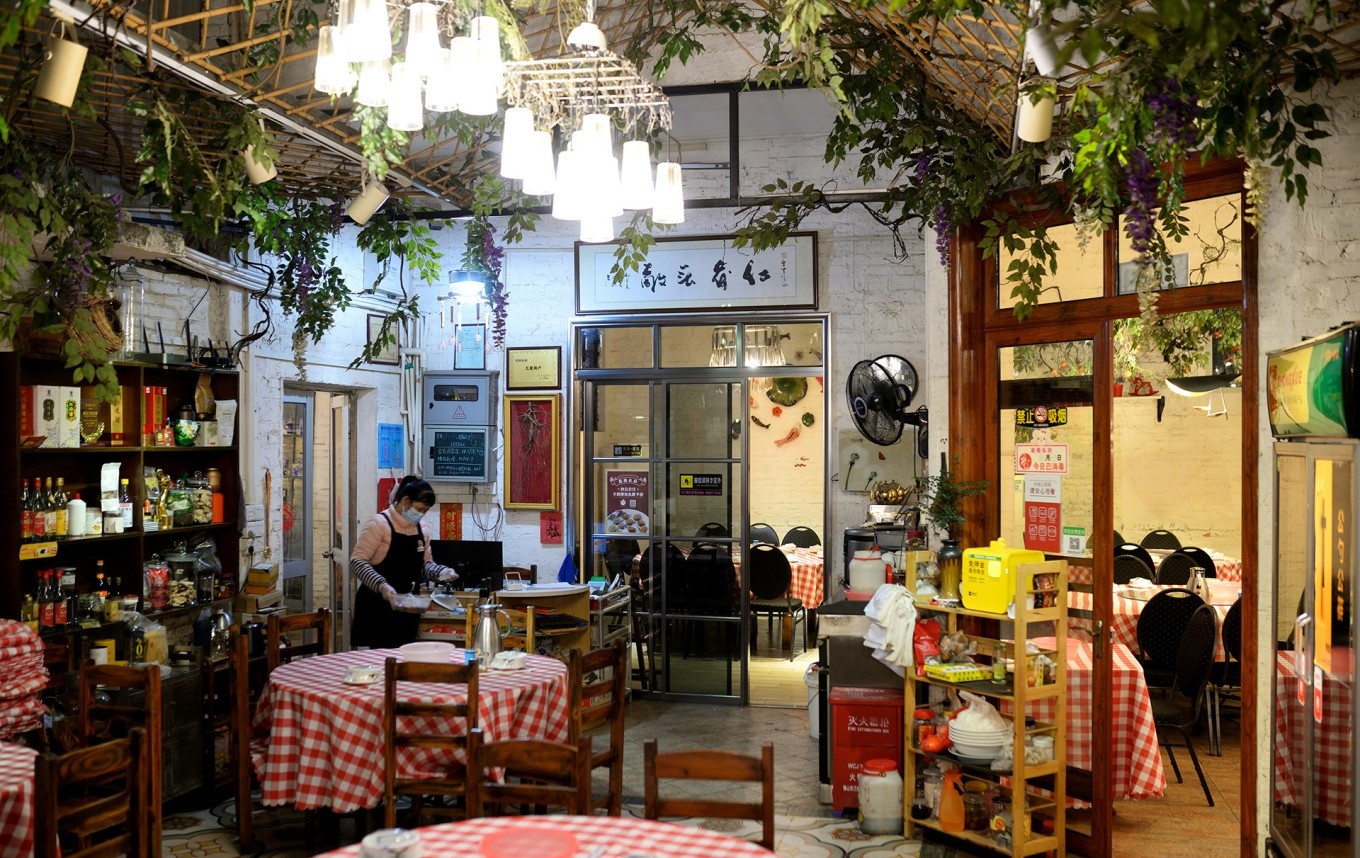
The Art of the Unexpected Twist
The chefs at Longqiao are masters of flavor, but they are also artists of texture and surprise. They take beloved, traditional Shunde dishes and introduce a single, brilliant element that elevates them into something entirely new and unforgettable.
Signature Dish 1: Four Seasons Tossed Chicken (四季捞鸡)
Prepare to have your perception of “chicken salad” changed forever. This isn’t your average tossed dish. It begins with tender, hand-shredded chicken, a Cantonese classic. But then comes the magic: fragrant, citrusy lemongrass and finely sliced raw onion cut through the richness, adding a wave of incredible freshness. And the masterstroke? Crispy potato chips are tossed in at the last second. That combination of savory chicken, zesty herbs, and the shocking, salty crunch of the chips is a moment of pure culinary genius.
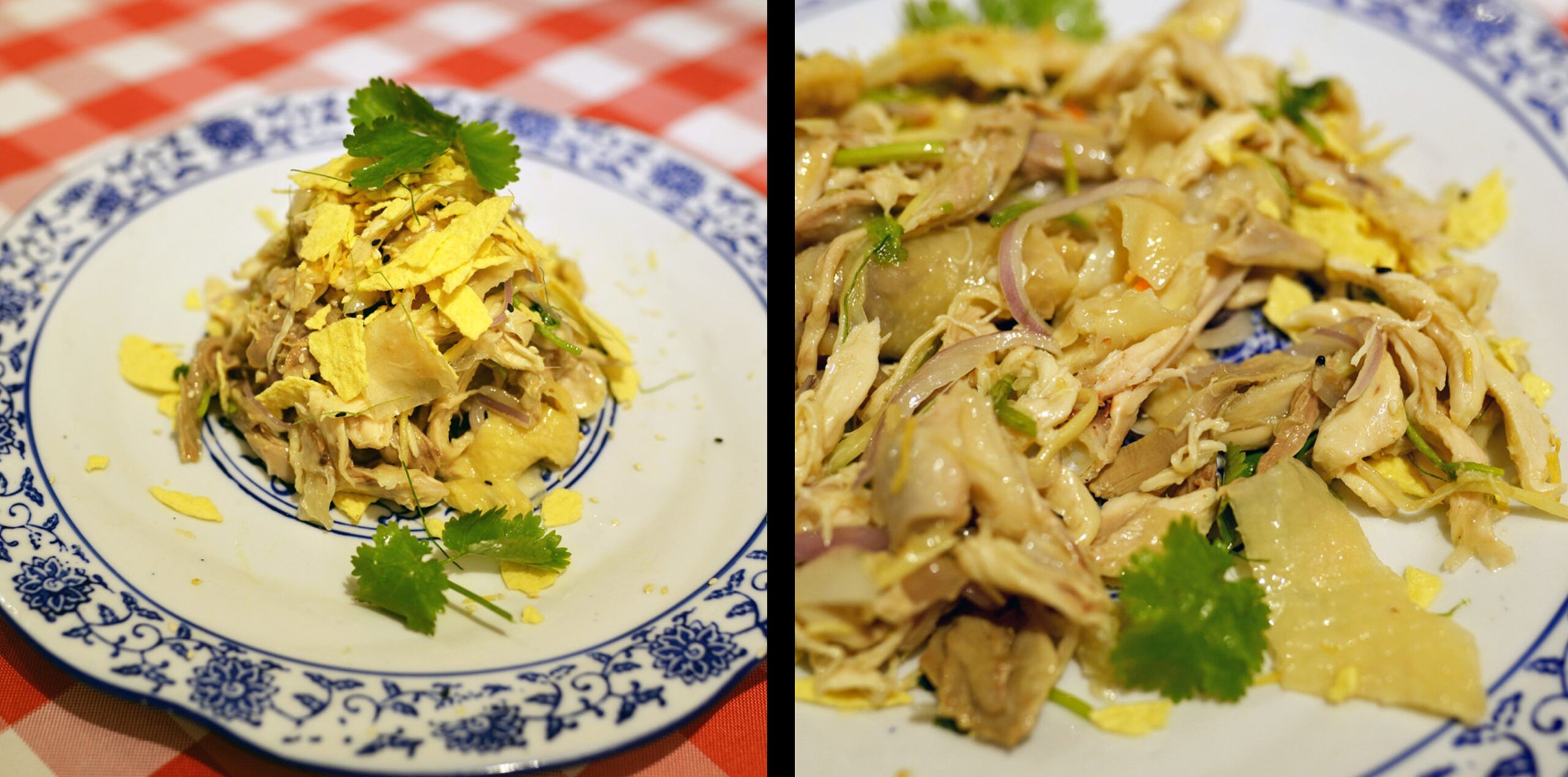
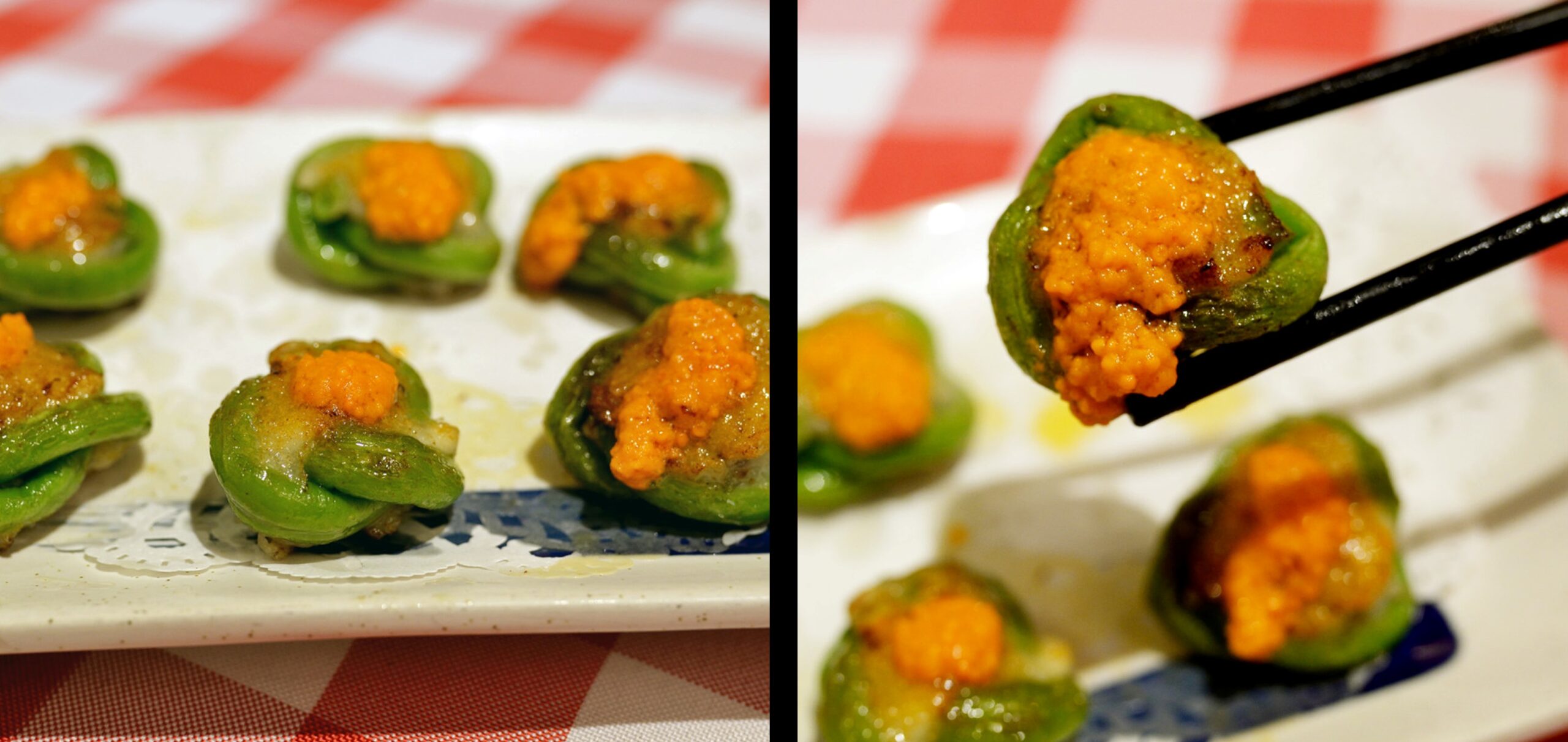
Signature Dish 2: Pan-fried Cuttlefish Cake with Crab Roe (香煎蟹黄墨鱼饼)
This dish is as beautiful as it is delicious. Imagine a patty of hand-pounded cuttlefish paste, so fresh it’s bouncy and springy (`Q弹`) to the bite. Each cake is artfully tied with a crisp, tender green bean, and then crowned with a generous dollop of rich, golden crab roe sauce. The result is a delightful interplay of textures and a profound umami flavor from the sea that will leave you wanting more.
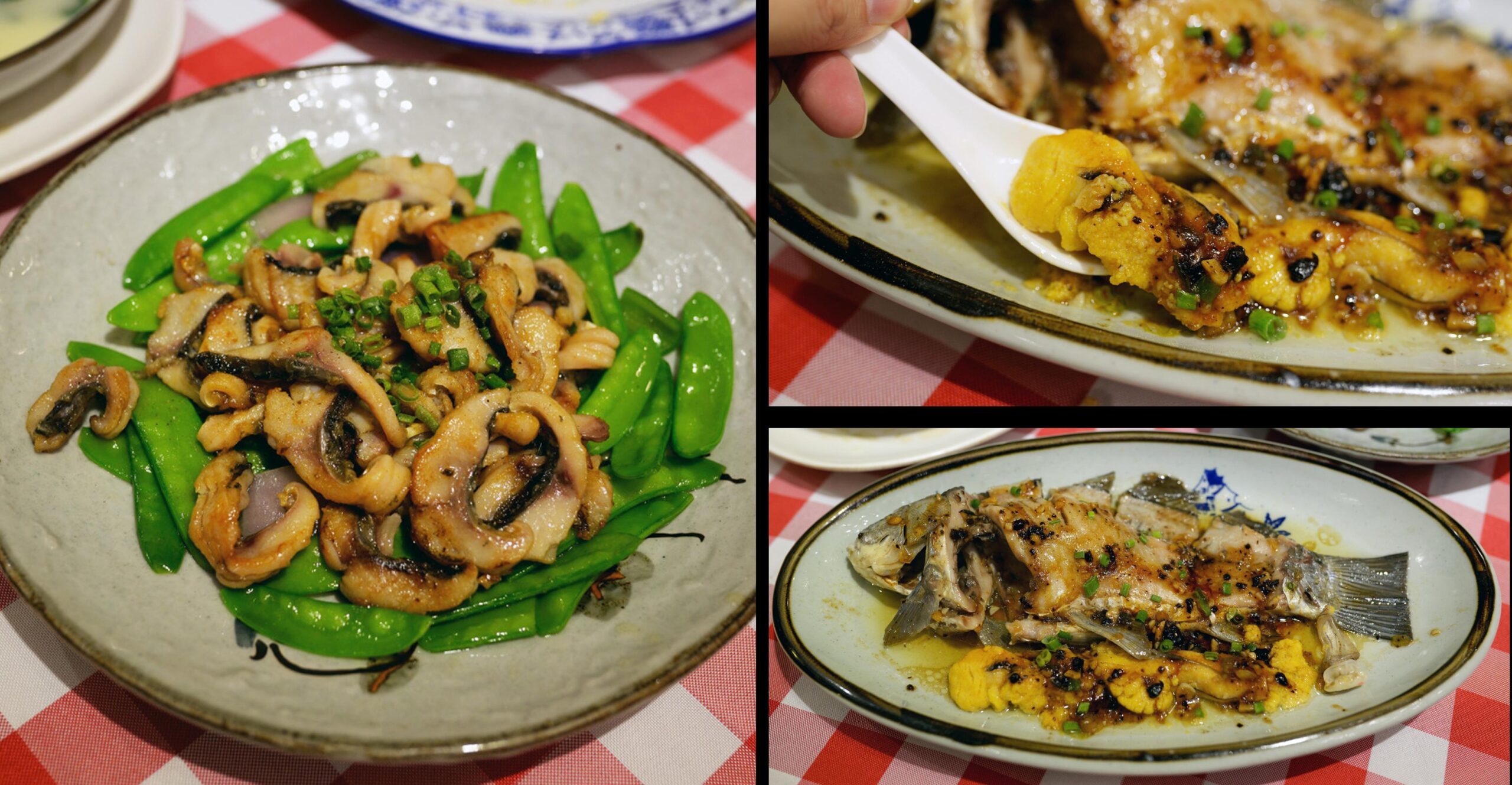
At a Glance
- Address: 龙源西路五巷5号公园内(In the park at No. 5, Lane 5, Longyuan West Road)
- Avg. Cost: 80 per person
- Must-Try Dishes: Four Seasons Tossed Chicken, Pan-fried Cuttlefish Cake with Crab Roe, Master’s Stir-fried Fish Fillets.
05. Dadi Farmstead (大地农庄)
Prepare for a spectacle of fire and flavor. This is home to the legendary Drunken Goose, a dish that’s as much a performance as it is a meal.
Some restaurants are known for their ambiance, others for their variety. Dadi Farmstead is known for an experience—a singular, spectacular dish that has become the stuff of legend: the Drunken Goose (火焰醉鹅). This is not a quiet meal. It’s a lively, communal, and theatrical event. The rustic, bustling atmosphere of the farmstead is the perfect stage for the drama that’s about to unfold at your table.
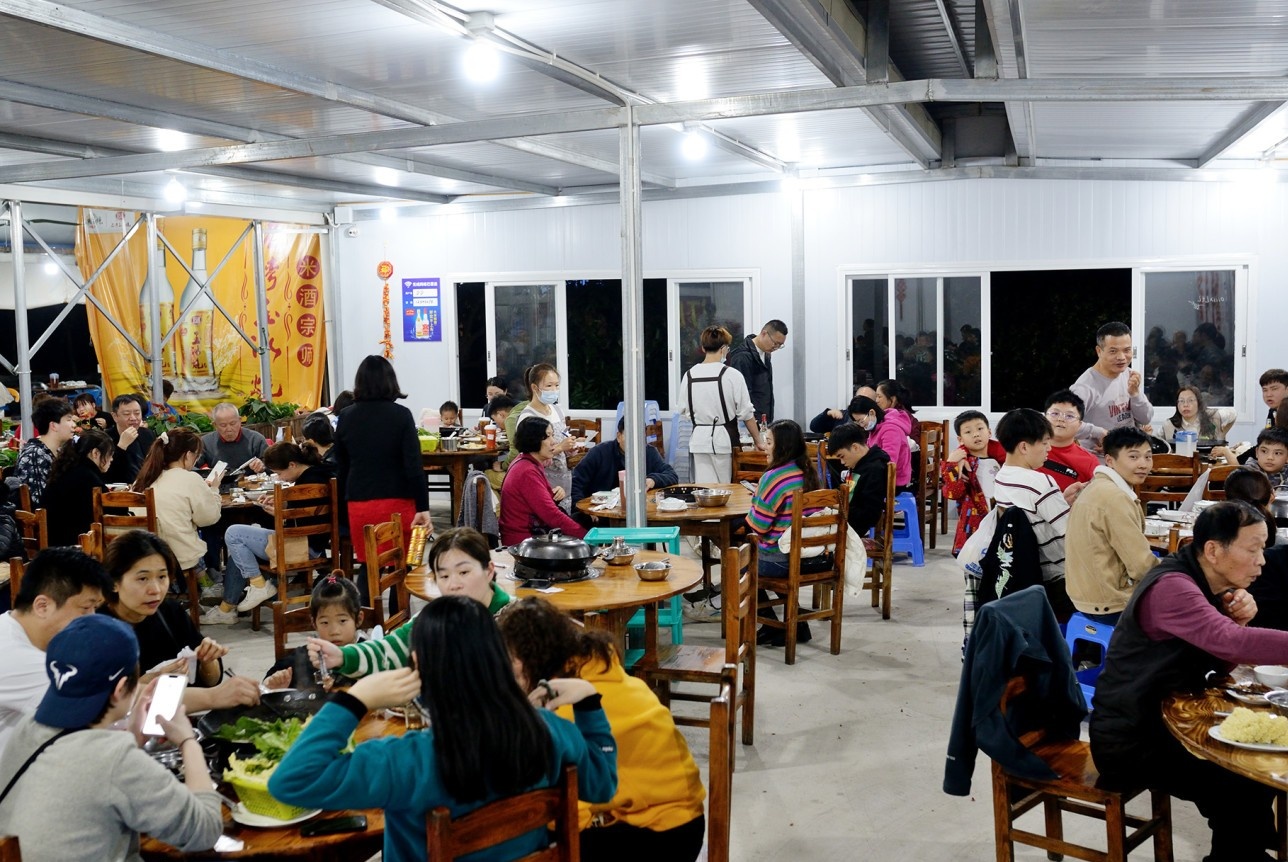
The Main Event: A Feast Forged in Flame
Forget ordering from a menu in the traditional sense. You are here for the goose. The process is a performance in itself:
- The Arrival: A massive, heavy wok is placed on a special gas burner at your table. A platter of goose pieces, marinated in a secret sauce, arrives alongside aromatics like ginger and garlic.
- The Sizzle: The chef stir-fries the goose pieces right in front of you, the wok filling the air with an intoxicating aroma.
- The Climax: Here comes the moment of theatre. The chef takes a full bottle of local rice wine (米酒) and pours it generously into the wok. With a long lighter, they set it ablaze. A huge column of blue and orange flame erupts from the wok, engulfing the goose.
- The Finish: As the flames die down, the alcohol has burned away, leaving behind a profound, sweet, and complex flavor infused deep into the succulent meat. The goose is then left to simmer in its own rich gravy until it is perfectly tender.
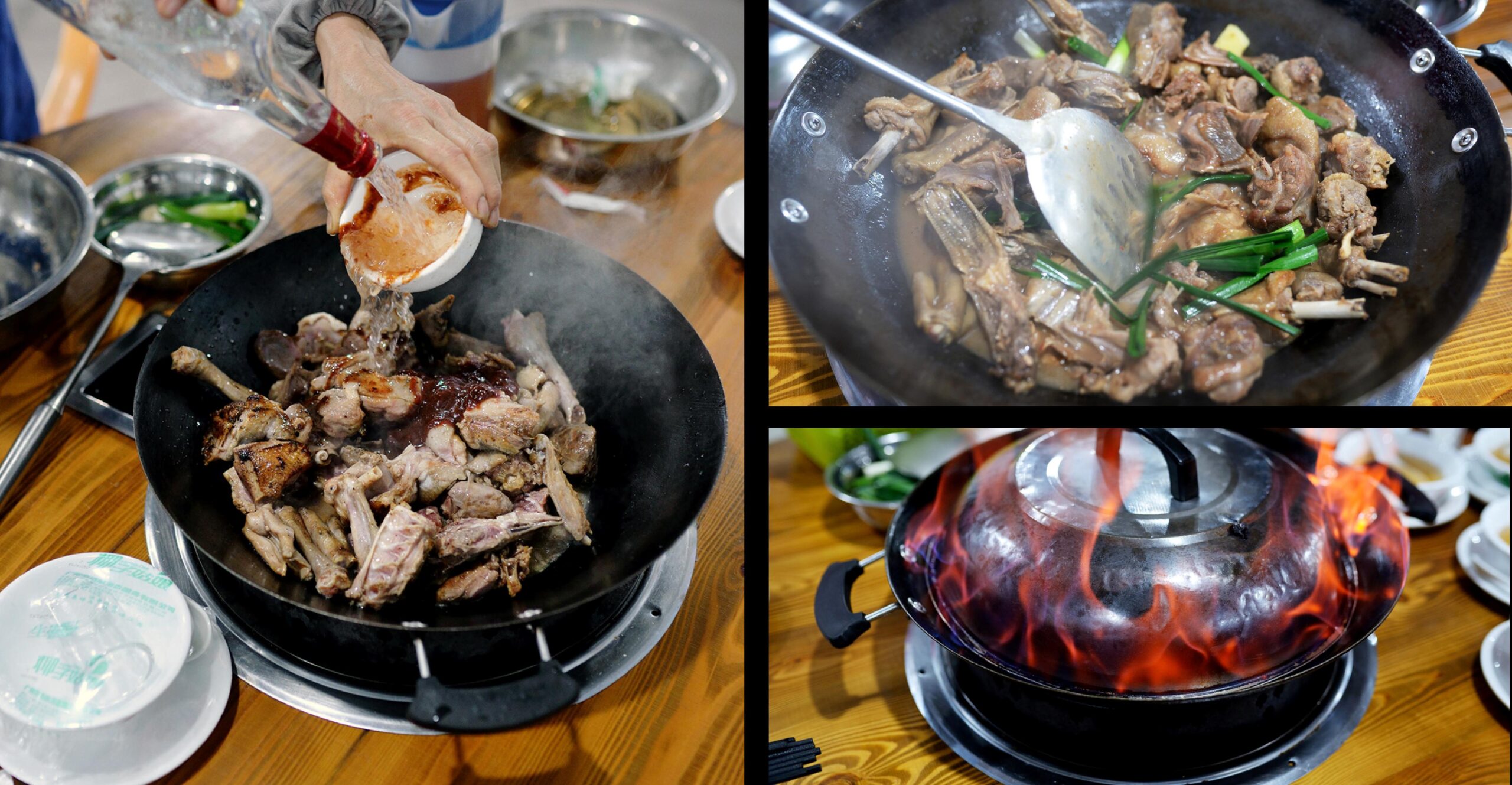
“The flash of fire is more than just a show; it’s a traditional technique that sears the meat and infuses it with the very soul of the rice wine, creating a flavor that cannot be replicated.”
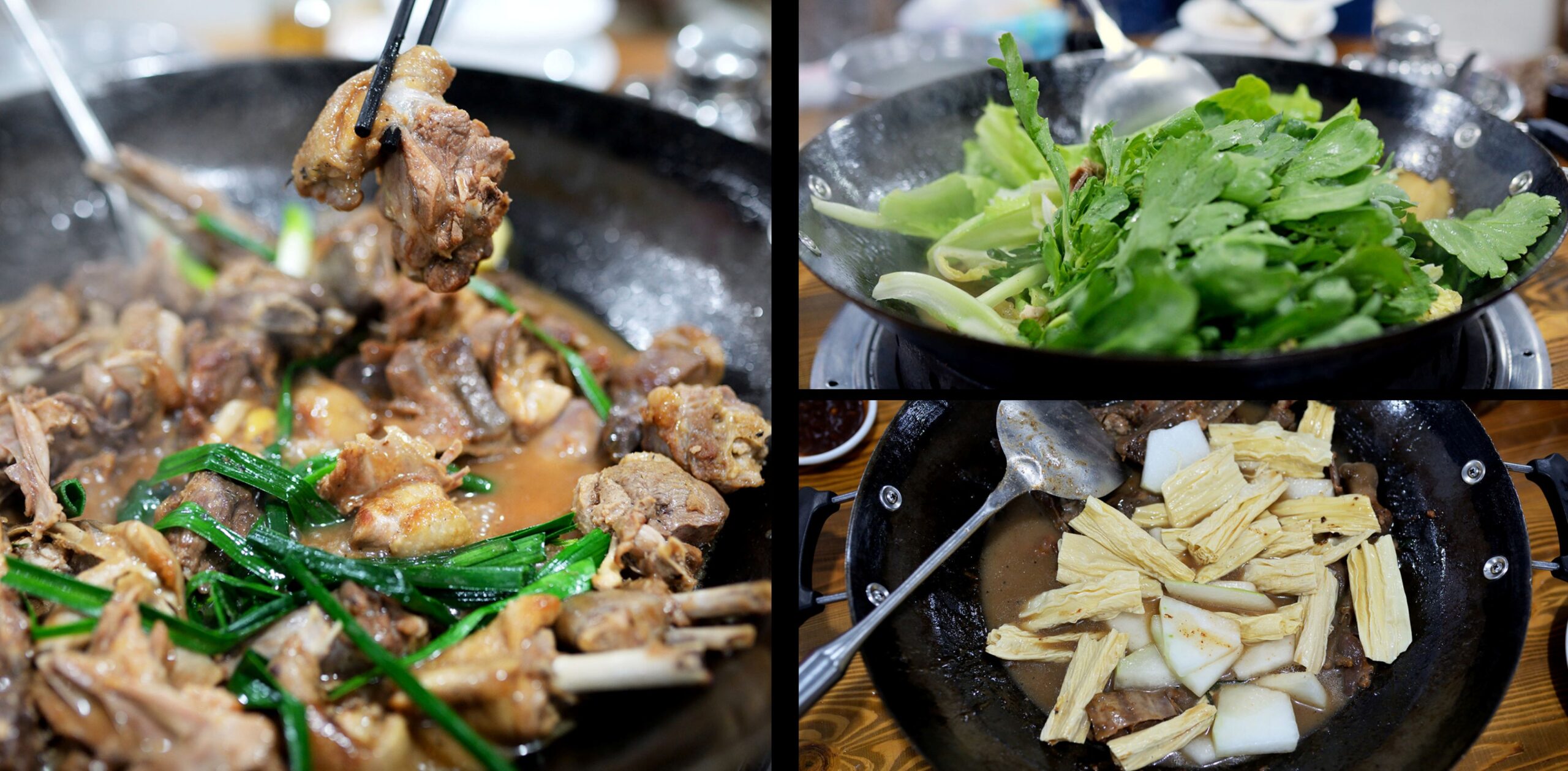
At a Glance
- Address:逢沙大道大良逢沙市场内(Fengsha Avenue Daliang Fengsha Market)
- Avg. Cost: ¥50 per person
- Must-Try Dishes: The one and only Drunken Goose (火焰醉鹅). You can also order fresh vegetables or rice to accompany it.
06. Long’s Restaurant (龙的酒楼)
A grand, classic establishment perfect for both a lively dim sum brunch and a formal dinner. Reliability and tradition in every bite.
When you want to experience the full spectrum of Cantonese and Shunde cuisine in a grand, traditional setting, you go to Long’s Restaurant. This is not a hidden gem; it’s a landmark. Imagine vast, bustling dining halls with white tablecloths, the clatter of porcelain, and the lively chatter of families and friends. Long’s is an institution, the go-to destination for everything from a cheerful morning `yum cha` (dim sum) to a lavish celebratory banquet.
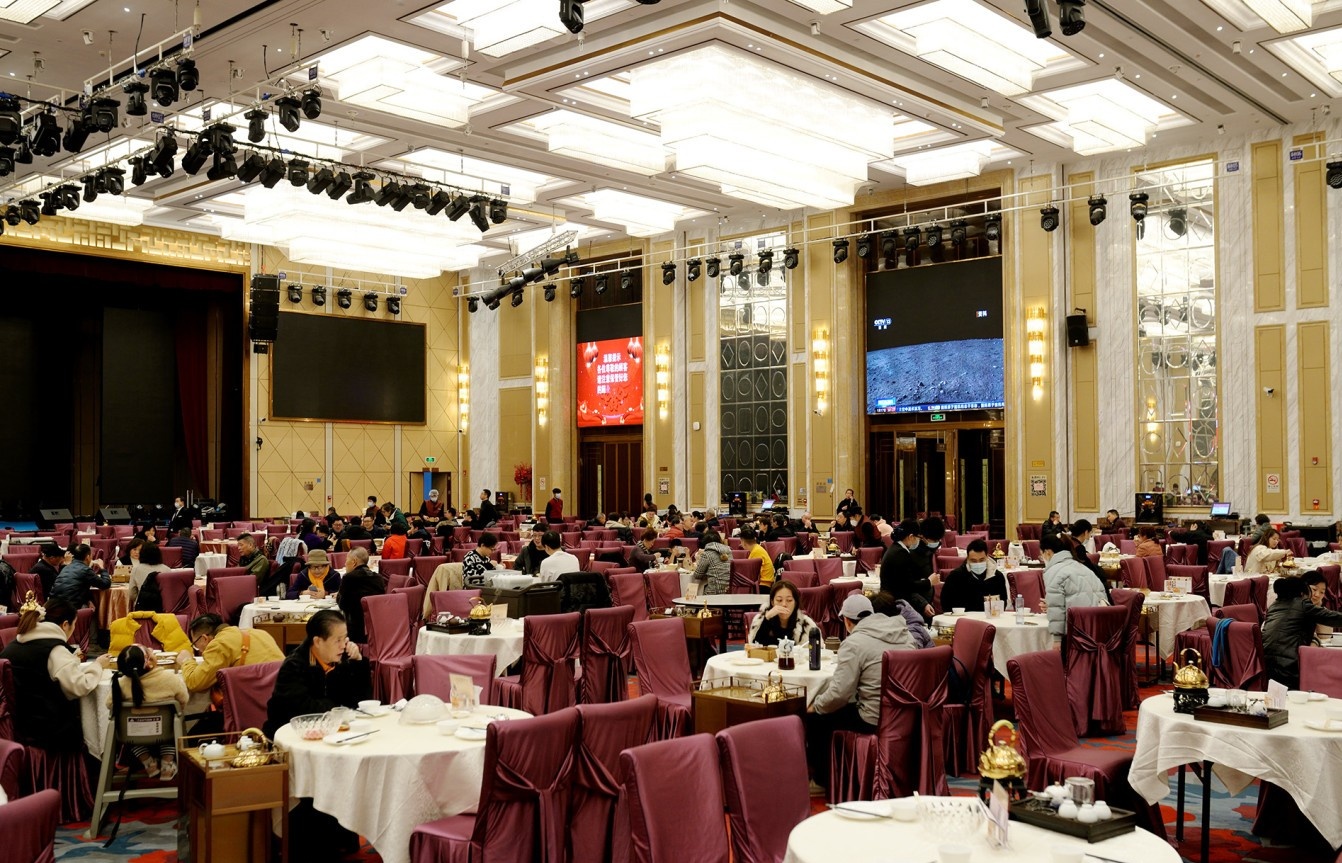
Two Experiences, One Legendary Kitchen
Long’s offers two distinct but equally brilliant dining experiences, showcasing the incredible range of their chefs.
The Morning Ritual: A Dim Sum Paradise (早茶)
Join the locals for the beloved ritual of `yum cha`. Here, you’ll find all the classics executed to perfection. Picture delicate, translucent Har Gow (shrimp dumplings) bursting with fresh shrimp, savory Siu Mai (pork and shrimp dumplings) topped with roe, and silky-smooth Cheong Fun (rice noodle rolls) doused in sweet soy sauce. It’s a symphony of small, perfect bites that defines the Cantonese weekend.
Tip: Dim sum has its own unspoken rules. To blend in with the locals and avoid awkward moments, check out our guide on Dining Etiquette in China.
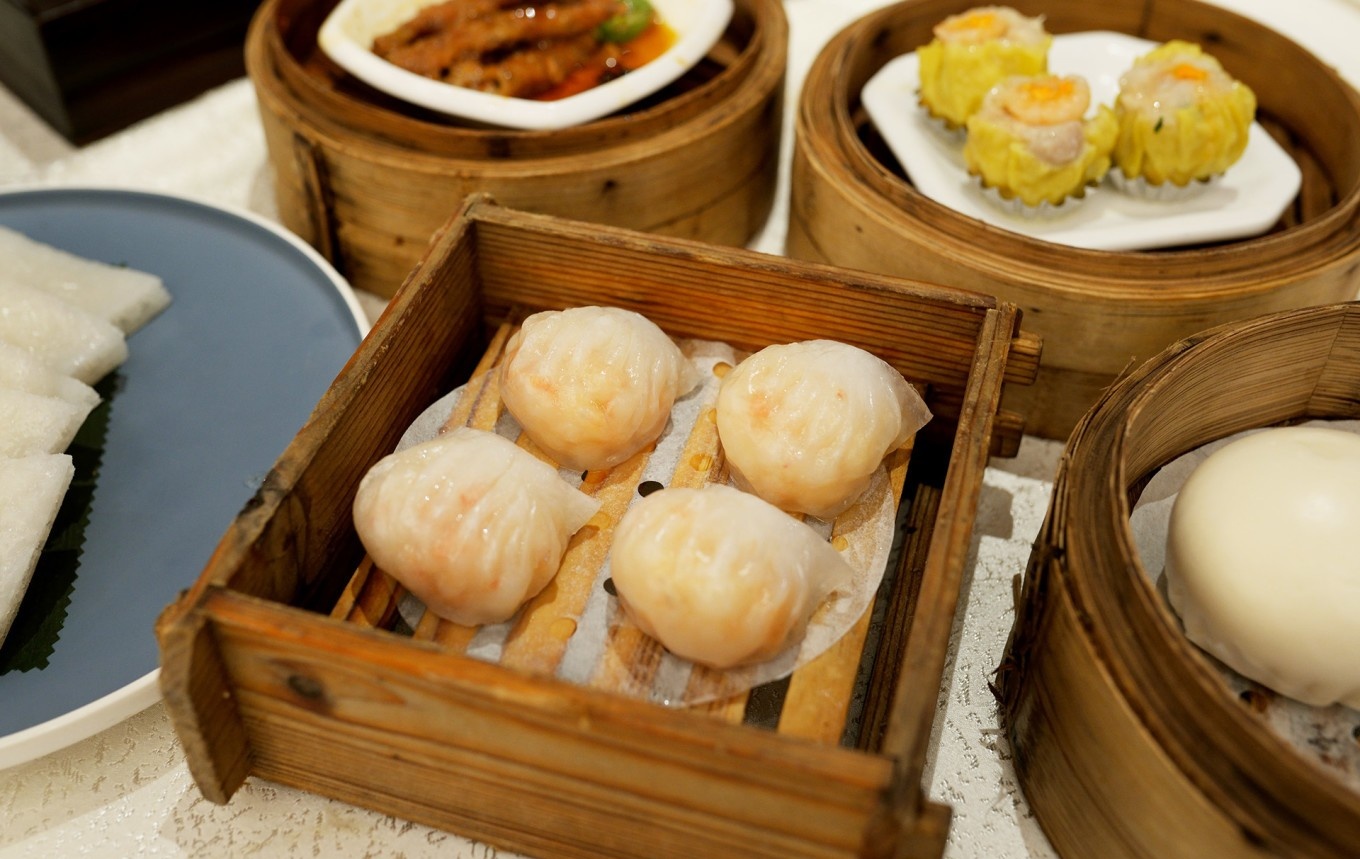
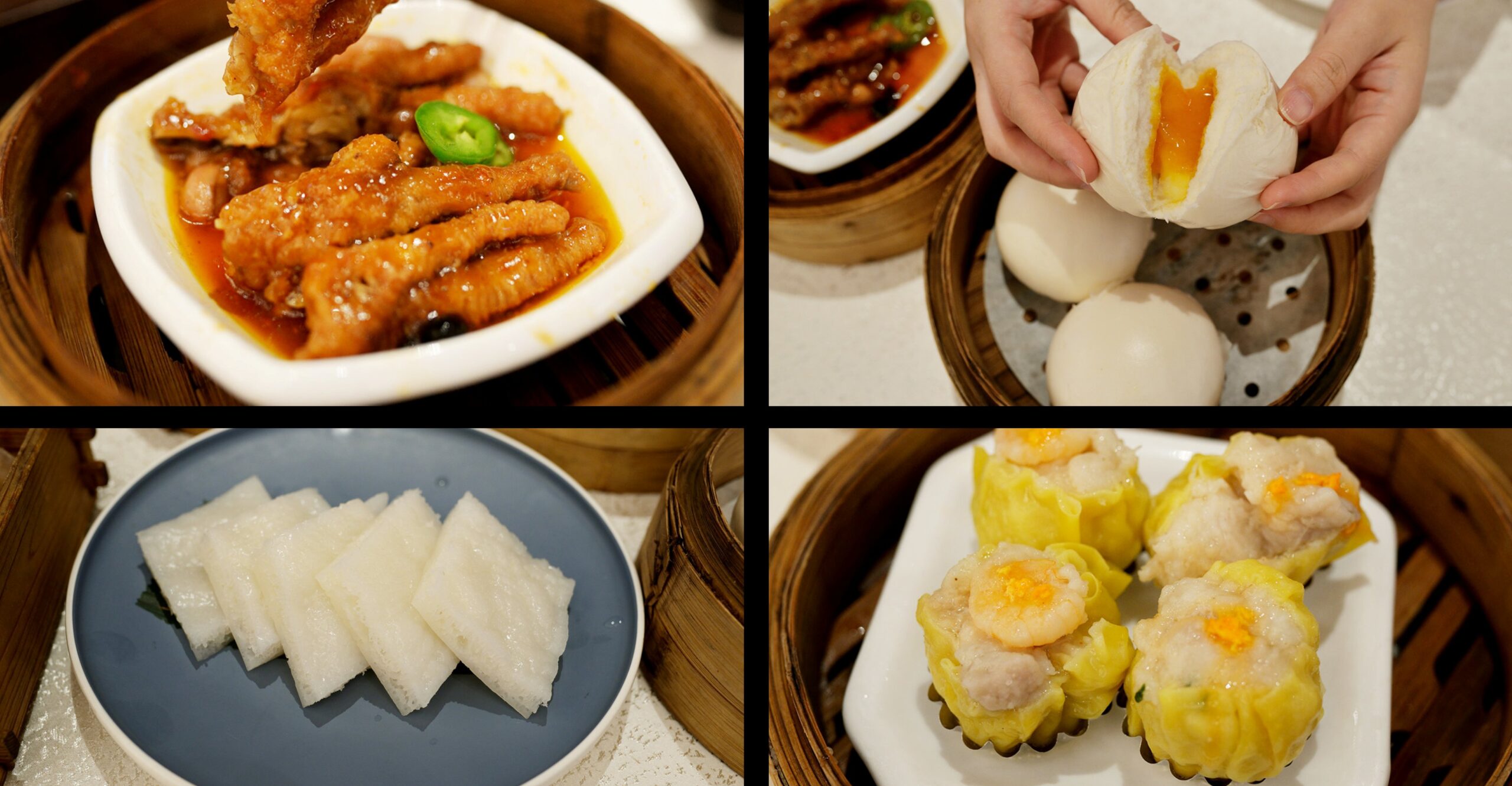
The Evening Feast: A Showcase of Banquet Classics (晚宴)
As evening falls, the menu transforms to feature the grand masterpieces of Shunde cuisine. This is where you’ll find show-stopping dishes designed for sharing and celebration. Indulge in a Crispy-skinned Roasted Chicken (脆皮鸡) with skin that shatters like glass, a whole Steamed Fish (清蒸鱼) showcasing ultimate freshness, or a magnificent Roasted Suckling Pig (烧乳猪) carved tableside. This is Cantonese cooking at its most refined and impressive.
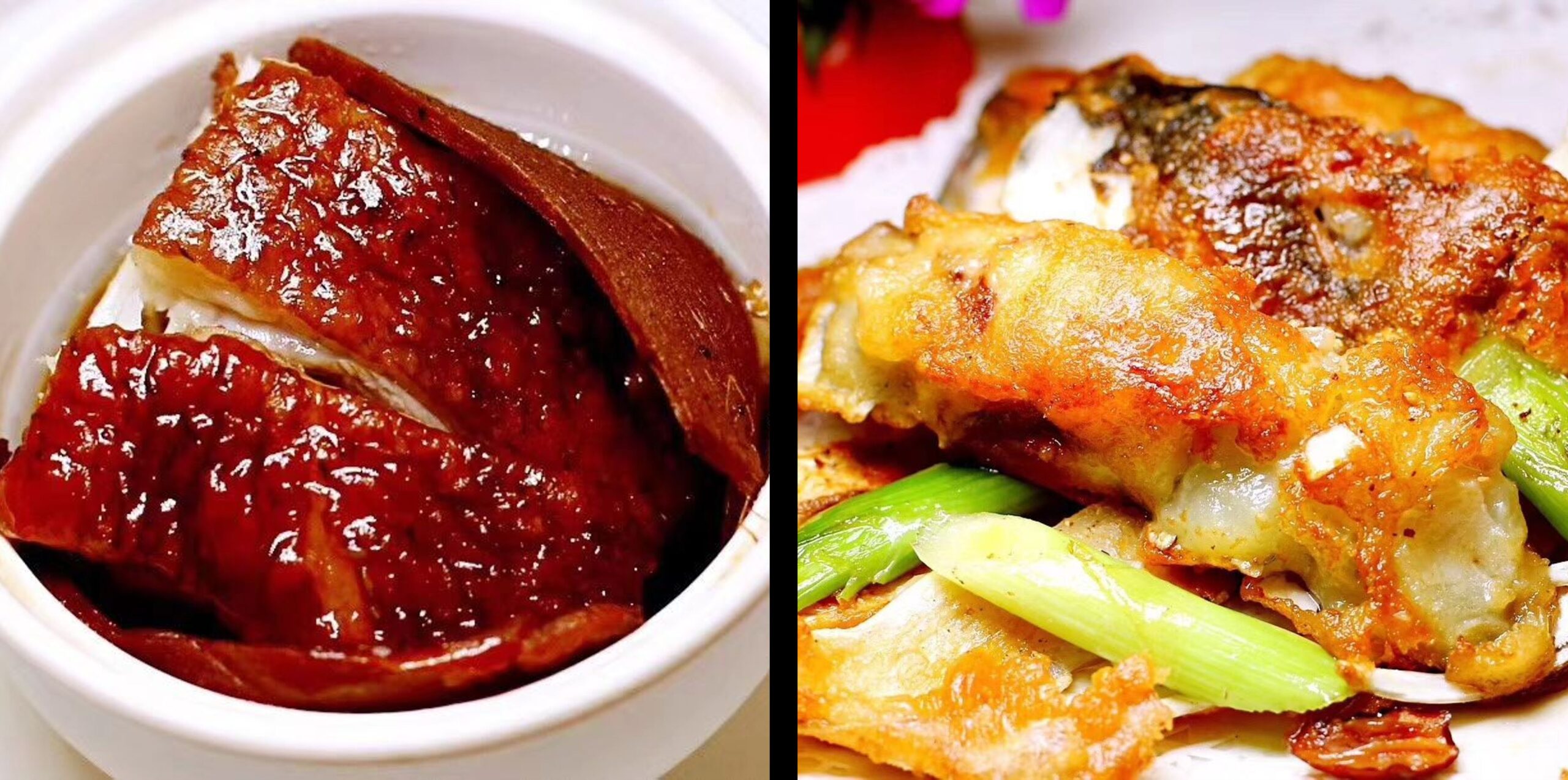
At a Glance
- Address: 大良街道近良路6号(No. 6, Jinliang Road, Daliang Street)
- Avg. Cost: ¥50 per person
- Must-Try Dishes: For Dim Sum: Har Gow, Siu Mai, Cheong Fun. For Dinner: Crispy-skinned Chicken, Steamed Fish, any of their signature roasted meats.
07. Fengcheng Restaurant (凤城酒家)
A taste of old Shunde, this restaurant is named after the city’s historical moniker, “Phoenix City.” It’s the place to go for time-honored local specialties.
While Long’s Restaurant represents the grand tradition of Cantonese dining, Fengcheng Restaurant, located in the heart of Daliang (the historic “Phoenix City”), offers a more contemporary and artistic interpretation. As part of the renowned Pork Po (猪肉婆) culinary group, this time-honored brand has evolved, focusing on dim sum that is not only delicious but also breathtakingly creative and refined. If you’re looking to be surprised and delighted by edible works of art, this is your morning destination.
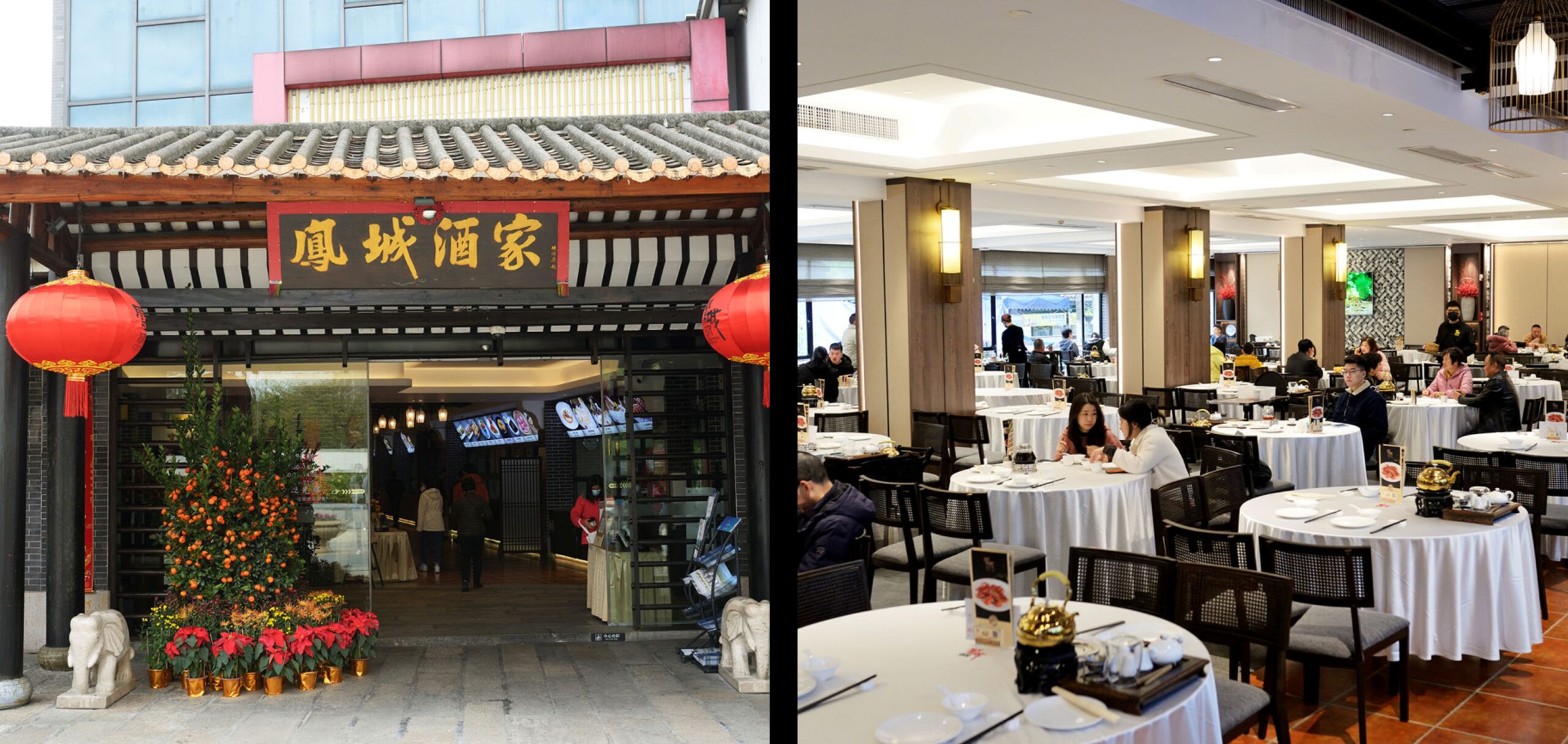
A Symphony of Flavor and Form
The chefs at Fengcheng are true innovators, pushing the boundaries of what dim sum can be. Each dish is a testament to their creativity, blending unexpected ingredients and stunning visuals.
Signature Dim Sum 1: Fresh Sichuan Peppercorn & Lily Bulb Dumpling (鲜花椒百合饺)
Prepare for a flavor revelation. These dumplings are, first and foremost, a feast for the eyes with their delicate, pale violet hue. But the real magic happens on your palate. The first bite yields the sweet, crisp texture of fresh lily bulb. This is immediately followed by a gentle, tingling wave of `ma` (麻) from fresh Sichuan peppercorns—a fragrance that awakens the senses without overwhelming them. It’s a bold, brilliant fusion that will have the entire table talking.
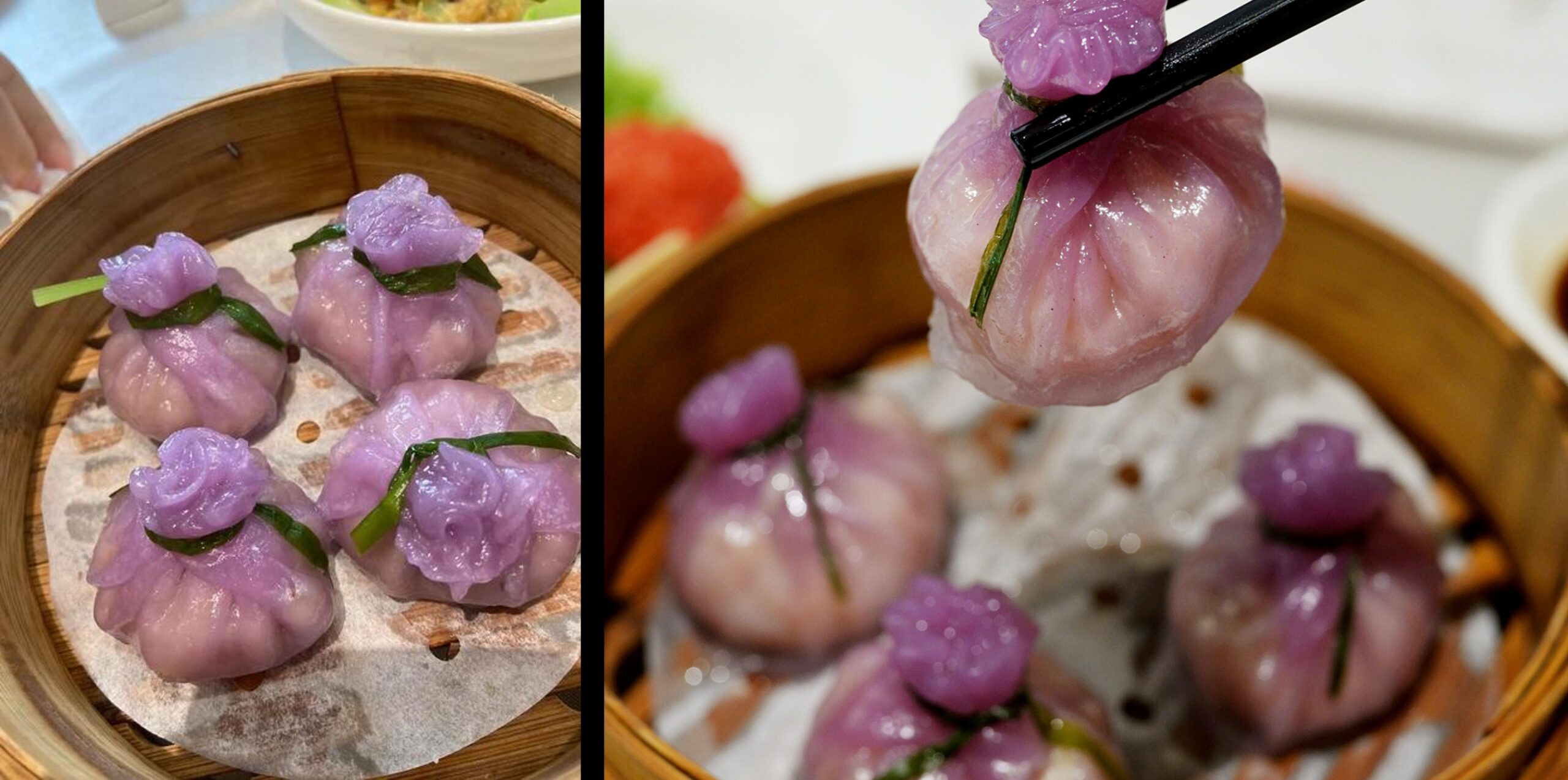
Signature Dim Sum 2: Imperial Concubine Lychee Ball (贵妃荔枝球)
This dish is a masterclass in playful deception. What appears to be a plate of fresh, red lychees is actually a savory delight. Each “lychee” is a springy, hand-pounded cuttlefish ball, coated in a layer of crispy puffed rice that has been dyed a vibrant red. The result is an addictive combination of textures—crispy on the outside, bouncy and tender on the inside (`外酥里嫩`). It’s a dish that scores perfect marks for both creativity and flavor.
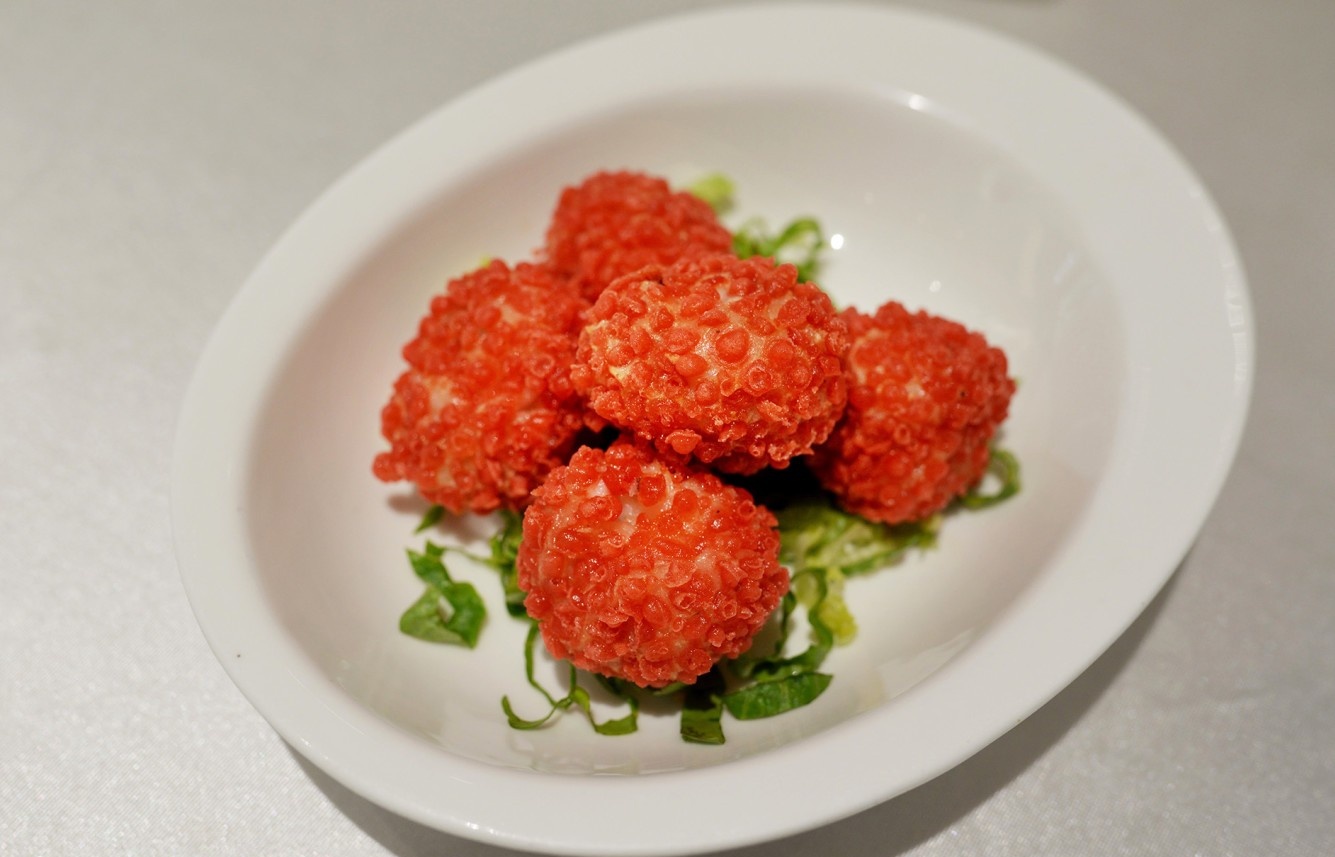
Signature Dim Sum 3: Seaweed Crispy Beef Rice Noodle Roll (海苔脆皮牛肉肠)
Even the humble rice noodle roll (`cheong fun`) gets a spectacular makeover here. The rice noodle itself is infused with seaweed, giving it a beautiful, delicate green color. Inside, you’ll find savory beef paste seasoned with classic Cantonese aromatics like dried tangerine peel and cilantro. But the true secret is a hidden layer of golden, crispy netting nestled between the soft noodle and the beef, providing a third, delightful texture. It’s a multi-layered experience in every bite.
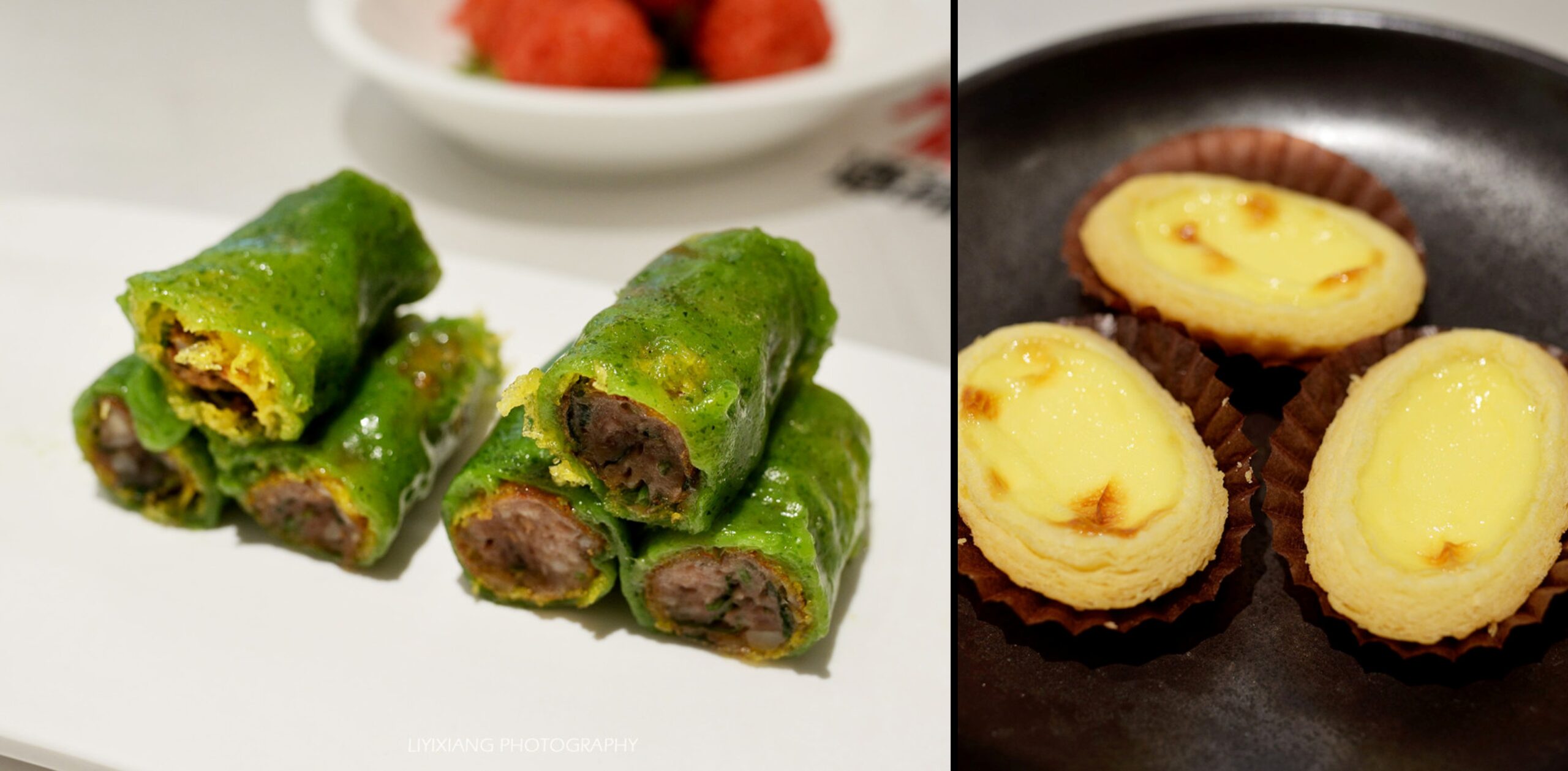
At a Glance
- Address: 滨河路1号一层A铺之一(One of the A shops on the first floor of No. 1 Binhe Road)
- Avg. Cost: ¥60 per person
- Must-Try Dishes: Fresh Sichuan Peppercorn & Lily Bulb Dumpling, Imperial Concubine Lychee Ball, Seaweed Crispy Beef Rice Noodle Roll.
08. Shunde Renjia Restaurant (顺德人家食府)
“Shunde People’s Restaurant” offers a comprehensive menu of local hits in a lively setting, often conveniently located near major attractions.
Located on the second floor of the Golden Plaza in the heart of Daliang, Shunde Renjia is a celebrated “old brand” (`老字号`) and a perennial favorite on local “must-eat” lists. The grand, spacious dining hall buzzes with energy, reminiscent of a classic, upscale Cantonese banquet hall. It has carved out a perfect niche for itself: locals say its dim sum is more refined and exquisite than some other major halls, yet more affordable than other high-end establishments. This is the definitive destination for a top-tier dim sum experience that delivers on both quality and value.
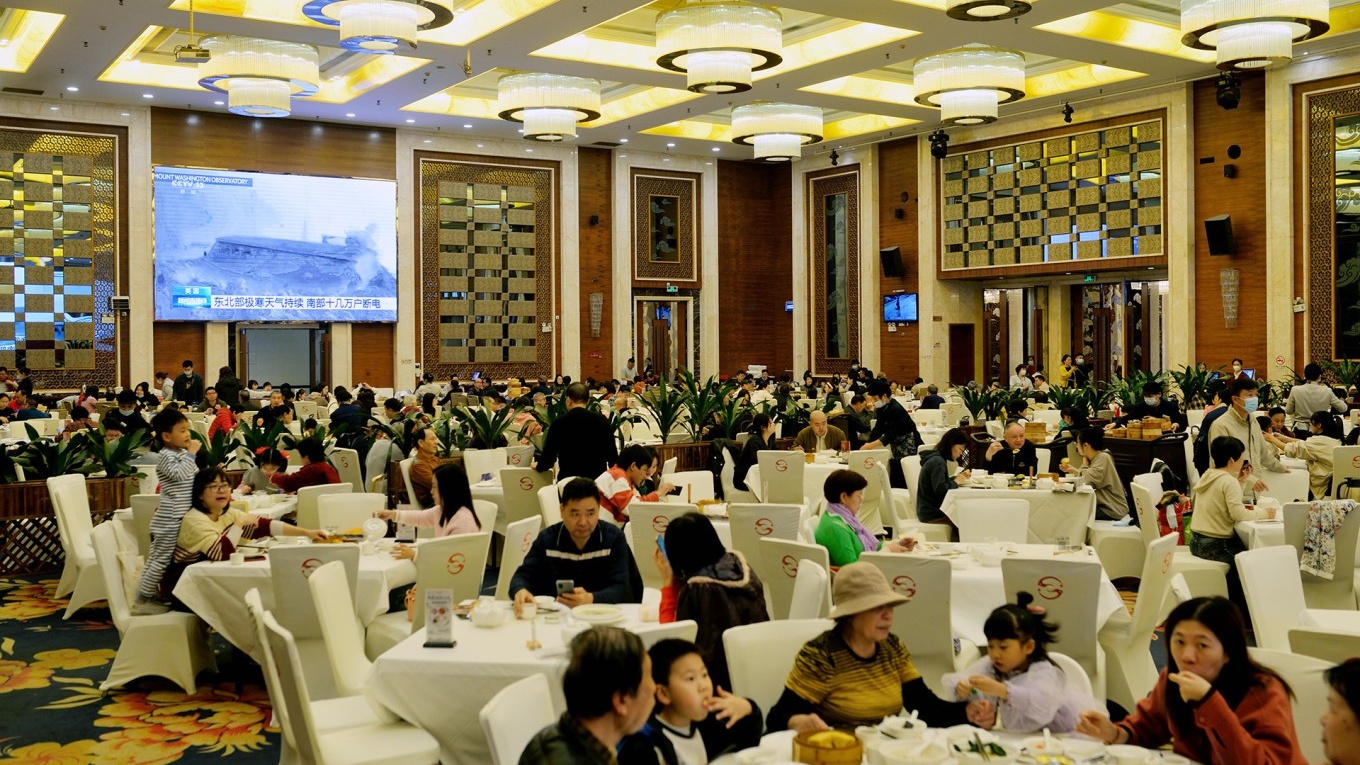
The Dim Sum “Big Three”: Flawless Execution
While the menu is extensive, a few classic items stand out for their sheer perfection and are considered essential orders.
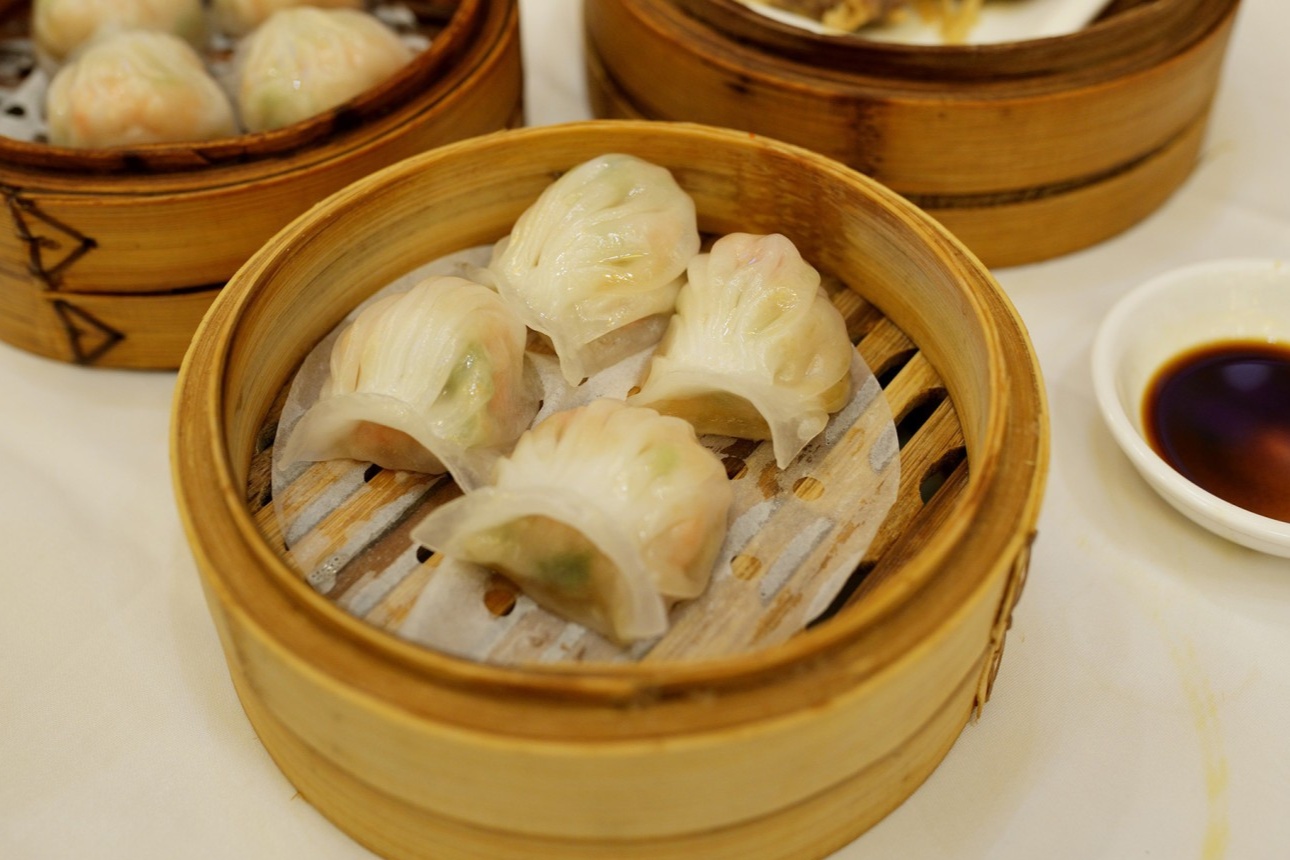
Har Gow Emperor (虾饺皇)
A fixture on nearly every table. The dumpling skin is flawlessly thin and translucent (`薄得透亮`), encasing a generous filling of three whole, plump shrimp and a surprising, delightful addition of diced asparagus, which adds a crisp texture and a pop of freshness.
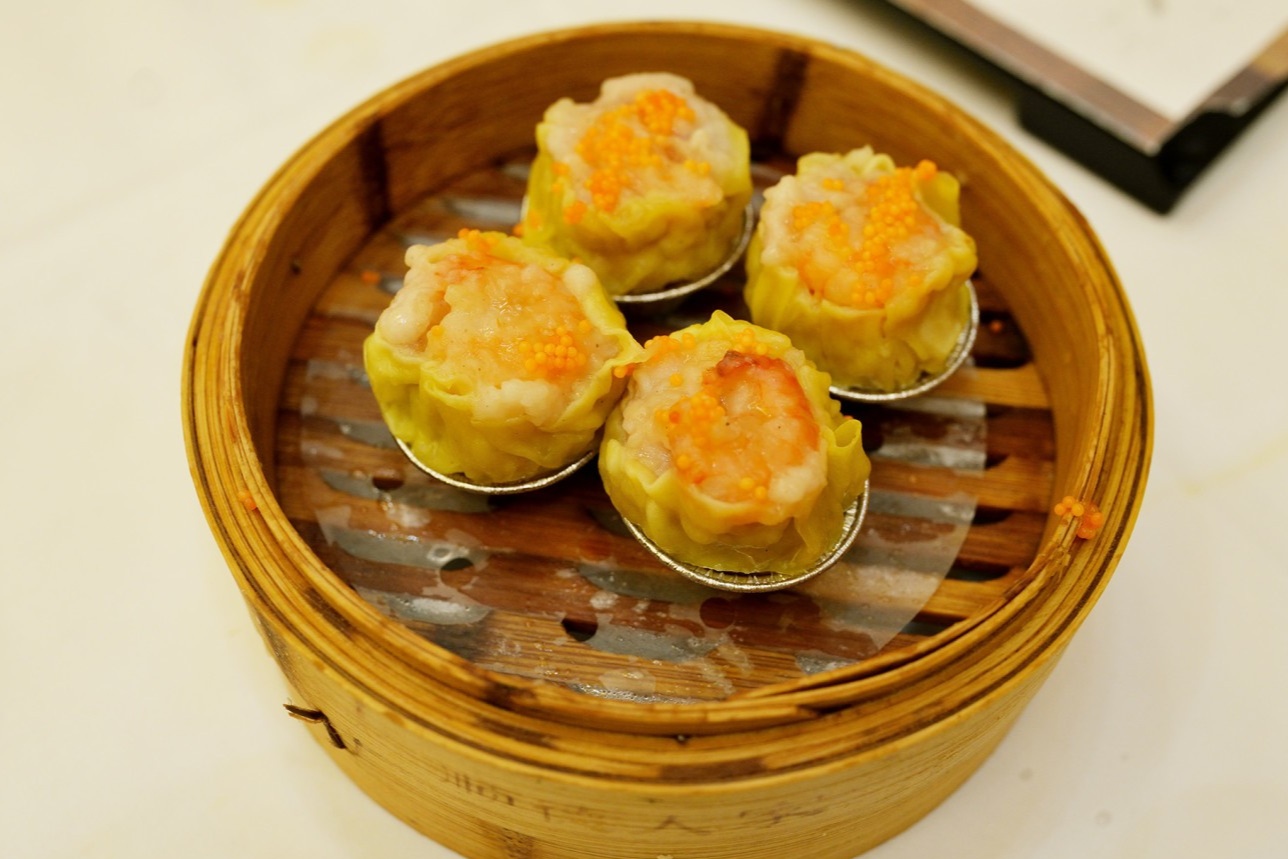
Crab Roe Siu Mai Emperor (蟹籽烧卖皇)
Another signature champion. These pork dumplings are generously filled, wrapped in a thin skin, and then crowned with a whole shrimp and a vibrant topping of crab roe. The combination of savory meat and the briny pop of the roe is pure perfection.
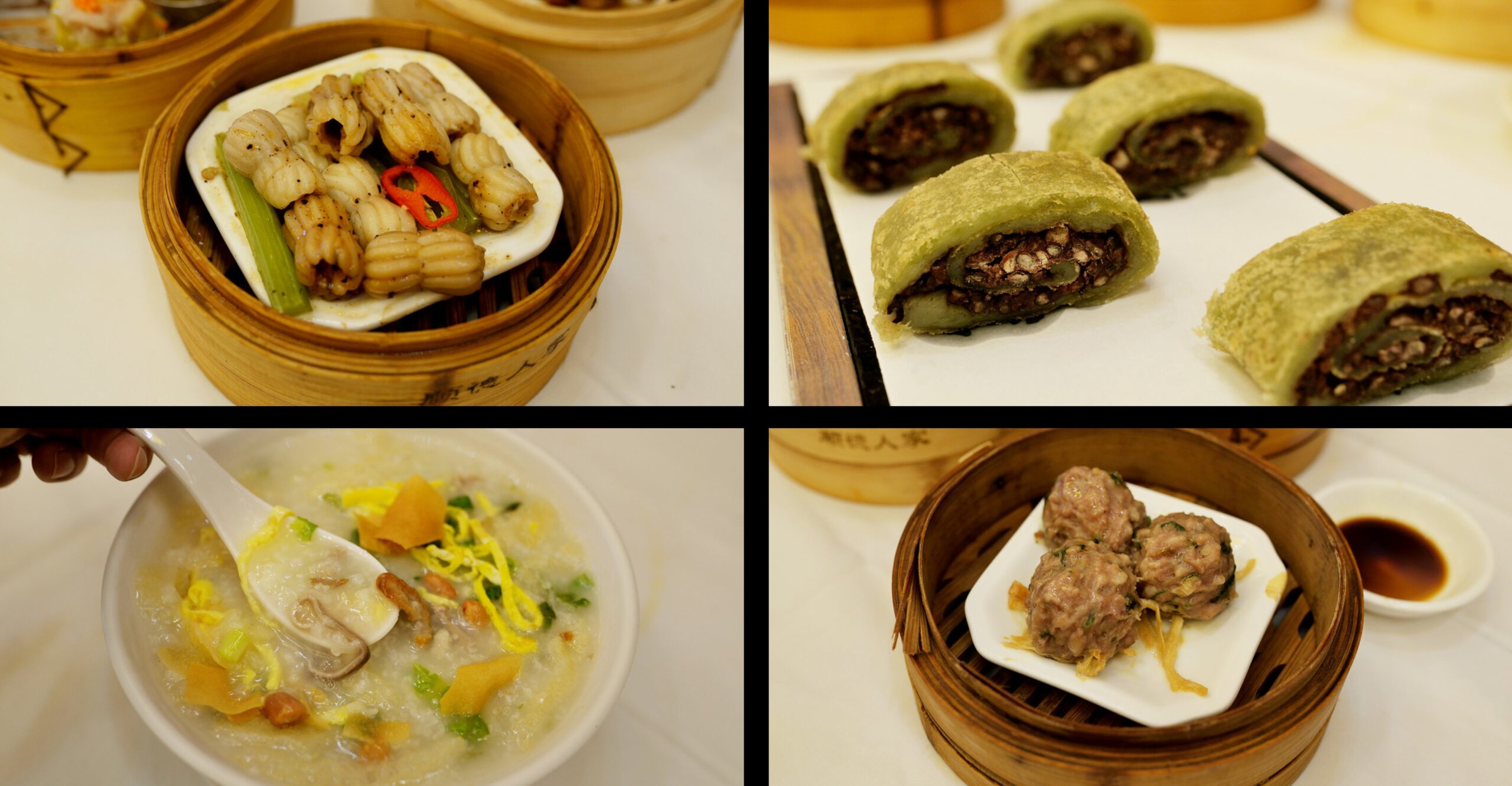
Steamed Beef Balls (鲜竹牛肉球)
A Cantonese classic, elevated. These beef balls are incredibly tender and flavorful, infused with the fragrance of dried tangerine peel (`陈皮`) and the subtle crunch of water chestnut (`马蹄`). Be sure to dip them in Worcestershire sauce (`喼汁`) for the authentic, tangy finish.
At a Glance
- Address: 顺德区大良街道华盖路步行街黄金广场二楼 (2/F, Golden Plaza, Huagai Road Pedestrian Street, Daliang, Shunde)
- Avg. Cost: ¥85 per person (for dim sum)
- Must-Try Dishes: Har Gow Emperor (虾饺皇), Crab Roe Siu Mai Emperor (蟹籽烧卖皇), Steamed Beef Balls (鲜竹牛肉球).
The Comfort Zone: Congee, Noodles & Local Staples
Beyond the grand banquets, the soul of Shunde’s cuisine lies in its everyday comfort foods. This section is dedicated to the humble yet masterful bowls of congee, noodles, and snacks that locals cherish.
09. Aunt Ying’s Pork Offal Congee (英姑猪杂粥)
The undisputed queen of late-night supper. This is where you’ll find the freshest, most satisfying bowl of pork offal congee, made to order.
As darkness falls over Shunde, a different kind of culinary scene awakens. To truly understand the local soul, you must experience its `ye xiao` (宵夜), or late-night supper. And there is no place more authentic, more vibrant, and more deeply satisfying than Aunt Ying’s. Forget fancy decor; this is a classic `dai pai dong` (大排档) style eatery, buzzing with the loud, cheerful chaos of locals. This is where you taste the city’s heartbeat, one bowl of spectacular pork offal congee at a time.
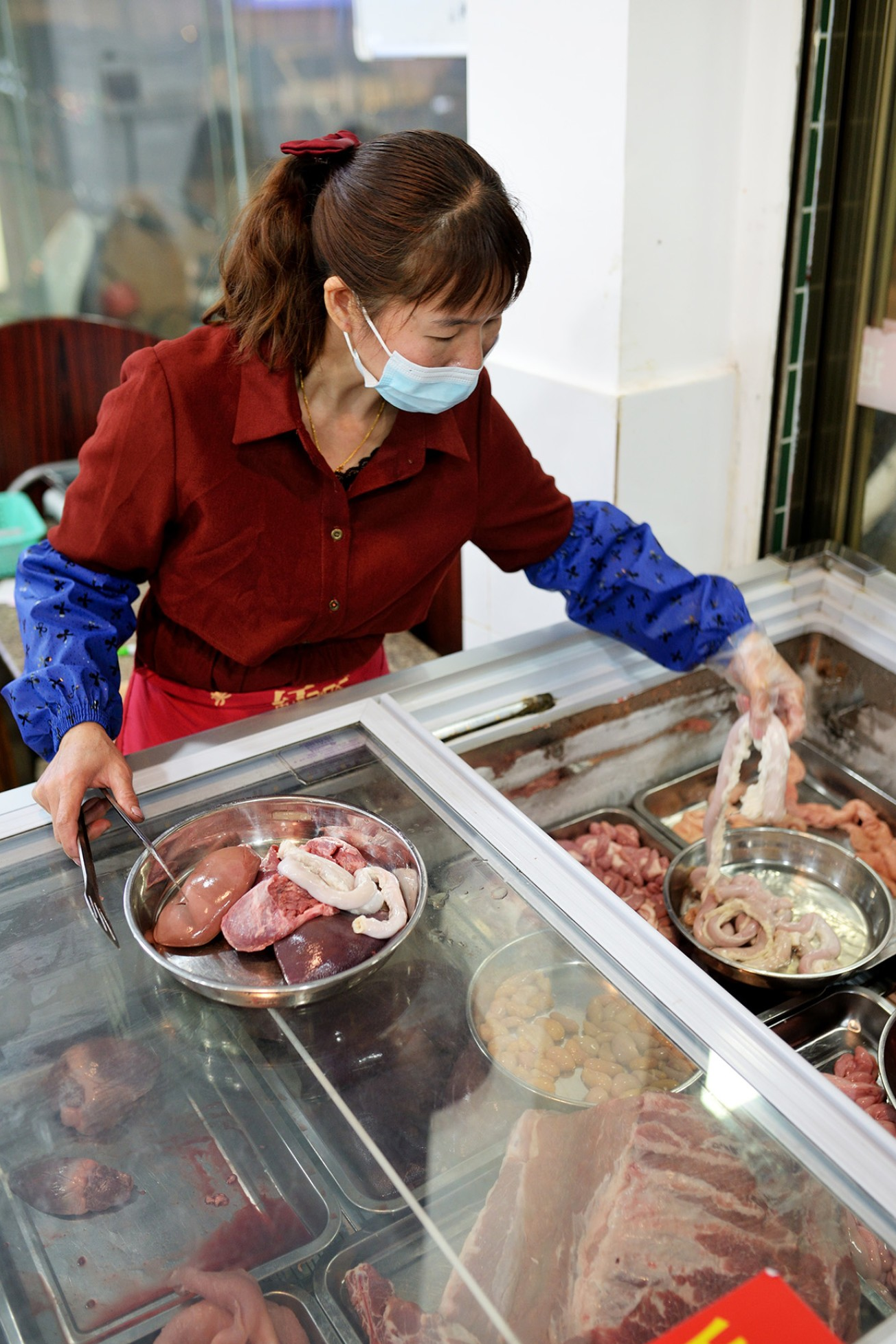
The Ritual: Choose Your Own Adventure
The experience begins the moment you walk in. There’s no menu passed to you. Instead, you head straight to a large, brightly lit refrigerated display case. Here, an incredible array of impeccably fresh pork offal is laid out before you. You point, you choose, and the owner weighs your selection. The classics are a must: liver (猪肝), kidney (猪腰), and the intestines. For the adventurous, the owner might recommend the `zhu ban jin` (猪板筋), a delightfully springy cut. A good rule of thumb is one `jin` (about 500g) for every two to three people.
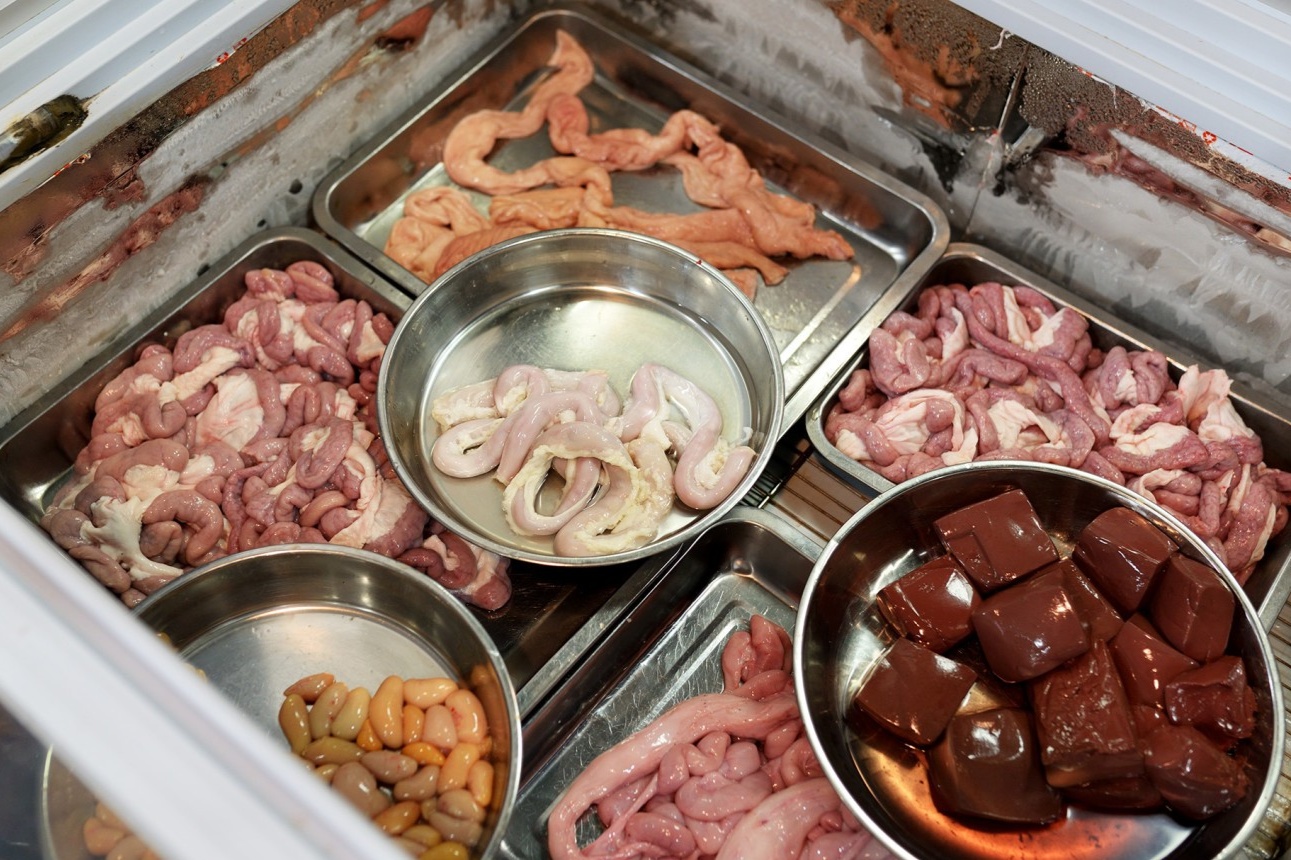
The Art of the Congee Hot Pot
At your table, a pot of plain, simmering white congee arrives. Your chosen offal follows, cleverly separated onto two plates based on required cooking times. The tougher cuts that need more time—like the chitterlings (粉肠) and tendon (板筋)—are on one plate. The delicate liver and kidney, which need just a brief blanch, are on another. As the congee reaches a rolling boil, the staff expertly adds the ingredients in sequence, then turns off the heat, allowing the residual warmth of the clay pot to cook everything to perfection. This precise control is the secret to the dish’s incredible texture.
“The final moments of cooking happen in the residual heat of the clay pot, a technique that ensures every piece of offal is cooked to its optimal, tender state.”
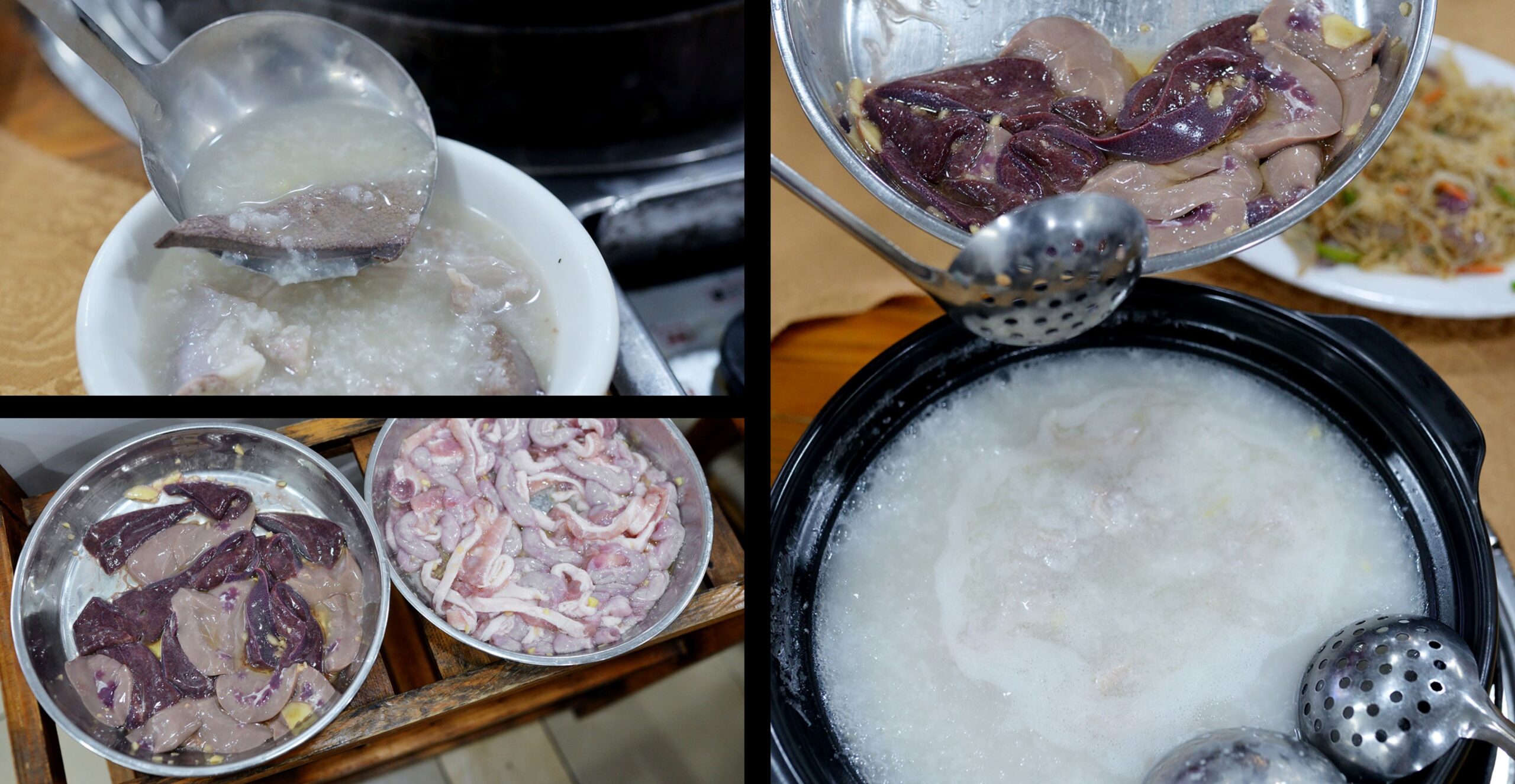
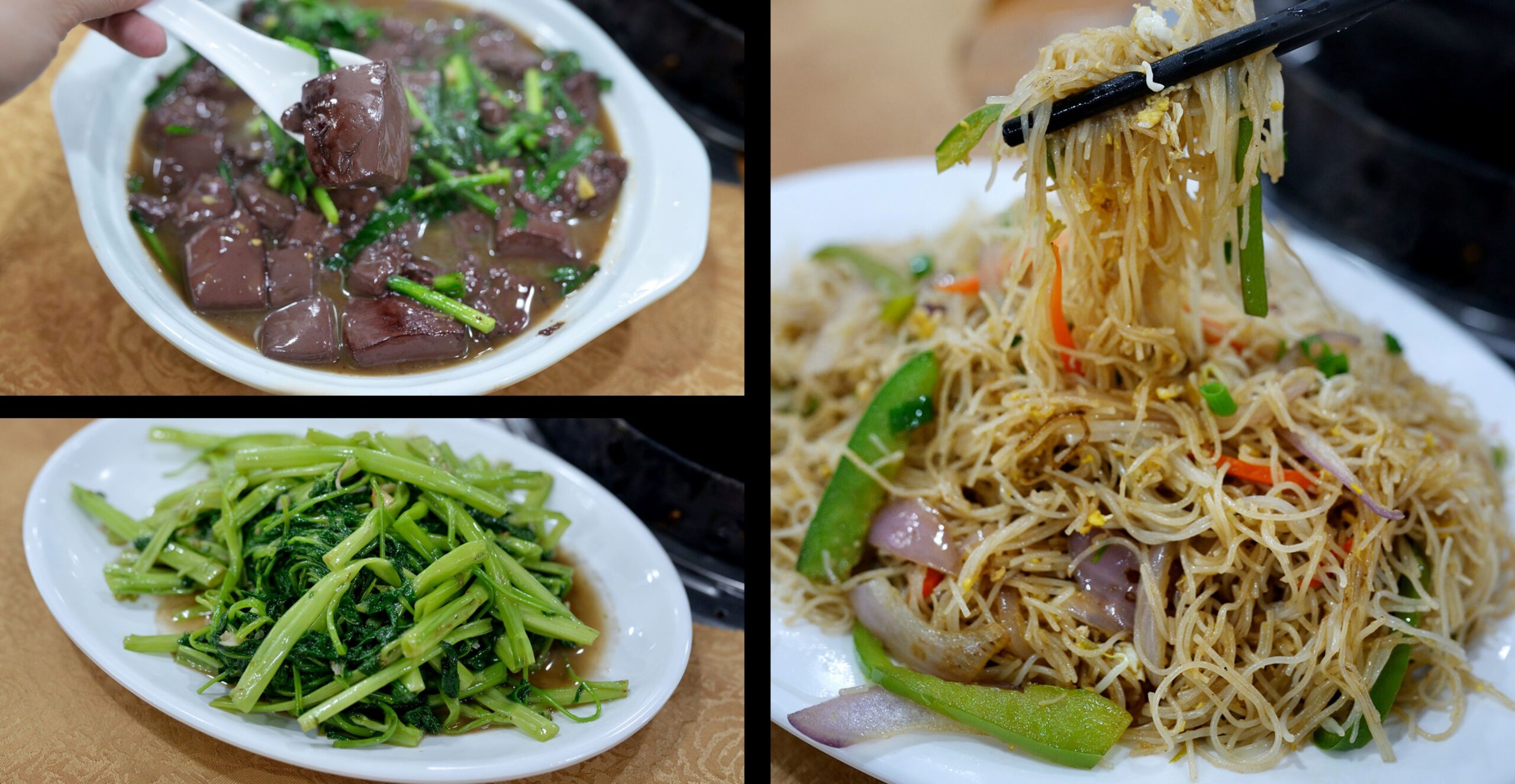
The first spoonful is a revelation. The freshness is absolute, with no gamey taste. The liver is powdery and tender (`粉嫩`), the tendon is springy (`爽弹`), but the star of the show is the crispy intestine (`脆肠`, actually the fallopian tube), which has a mind-blowing crisp-yet-bouncy texture that is simply unforgettable.
At a Glance
- Address: 南国中路159号东90米(90 meters east of No. 159 Nanguo Middle Road)
- Avg. Cost: ¥50 per person
- Must-Try Offal: Pork Liver (猪肝), Pork Kidney (猪腰), Crispy Intestine (猪脆肠), Chitterlings (猪粉肠).
10. Xuan Kee Congee (煊记粥铺)
A hidden gem beloved by locals, serving a unique and incredibly flavorful Water Snake Congee. An adventurous and rewarding meal.
If Aunt Ying’s is a celebration of vibrant chaos, Xuan Ji is a testament to quiet mastery. Here, the focus shifts from the ingredients cooked *in* the congee to the congee itself. Xuan Ji is famous for its legendary congee base (`粥水`), a porridge that has been cooked for so long that the rice grains have completely dissolved, leaving behind a broth that is as silky and smooth as cream, yet light and profoundly flavorful. This isn’t just congee; it’s a culinary medium, the foundation for a delicate and refined hot pot experience.
With over two decades of history, Xuan Kee Congee is a time-honored brand (`老字号`) that gained national fame after being featured in the popular documentary “Breakfast in China.” It was affectionately dubbed the “Hermès of the congee world,” a testament to its uncompromising quality. The original shop, tucked away under a residential building on Jianhai Road, embodies the spirit of a true hidden gem (`大隐隐于市`). The clientele consists mainly of local neighbors, and with the TV broadcasting Hong Kong’s TVB morning news, the authentic, old-school Cantonese atmosphere (`老广氛围感`) is palpable.
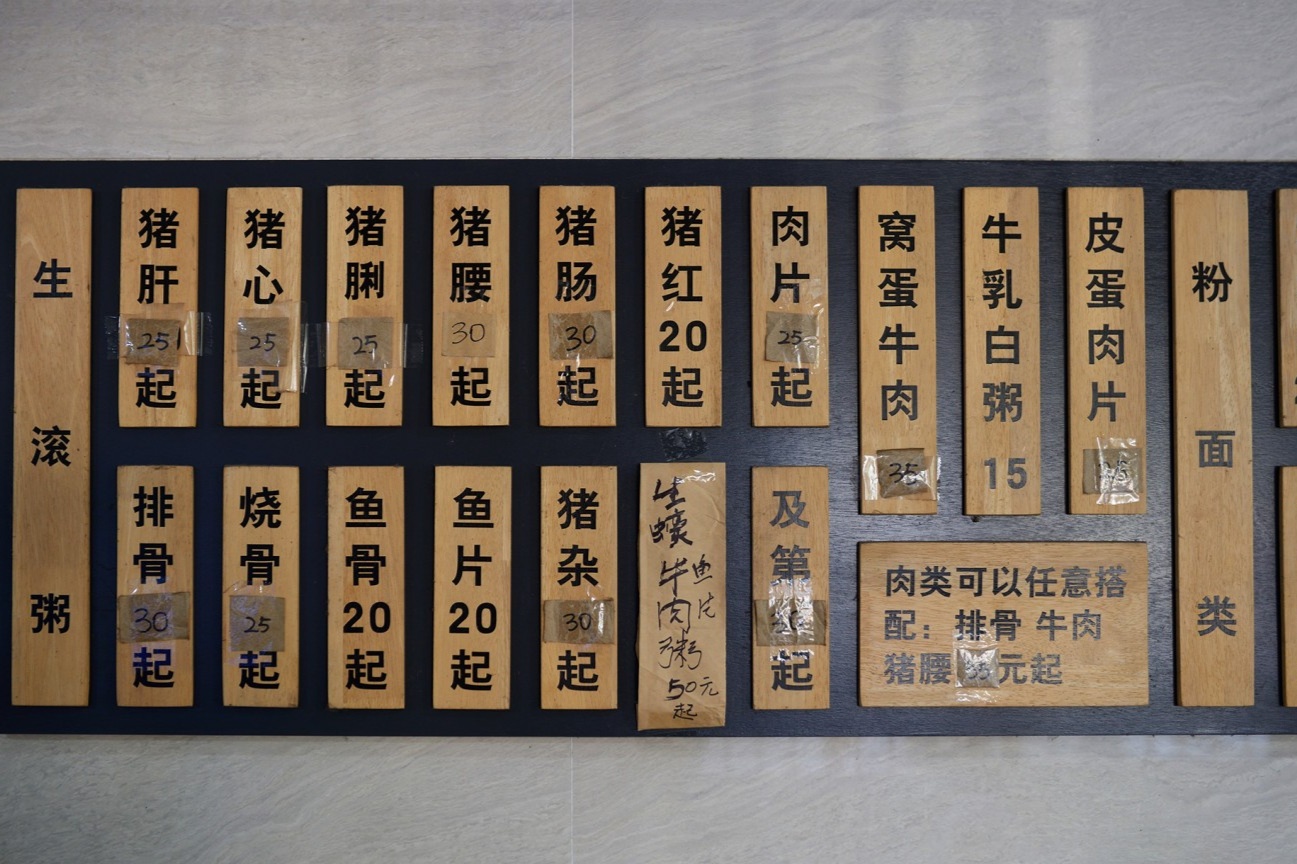
The Art of “Sheng Gun Juk” (生滚粥)
Xuan Kee specializes in `生滚粥` (sheng gun juk), or “freshly-rolled congee.” The process, while sounding simple, is a culinary art form. It starts with a perfectly smooth, pre-cooked plain congee base (`白粥底`). When an order is placed, a portion of this base is brought to a furious boil, and fresh, raw ingredients are tossed in and cooked in seconds. This method demands masterful control over the heat (`讲究对火候的把握`) to ensure the ingredients are cooked to perfection while the congee remains silky smooth. This commitment to freshness and technique is reflected in its premium pricing, which is considered high for the area but justified by the quality.
The Ultimate Indulgence: Raw Egg Beef Congee (窝蛋牛肉粥)
The star of the menu is the Raw Egg Beef Congee, their top-seller and most premium offering. The portion is famously generous—often enough for two people with smaller appetites. The magic happens when a raw egg is cracked into the piping hot congee right before serving, gently cooking in the residual heat to create a rich, velvety texture that envelops the tender slices of beef.
To complete the experience, it’s served with a small side dish of shredded ginger and spring onions (`姜葱丝`). The local way to eat it is to add a splash of soy sauce to this side dish, creating a simple yet exquisite dipping sauce for the beef. It’s a comforting, luxurious, and unforgettable bowl of congee.
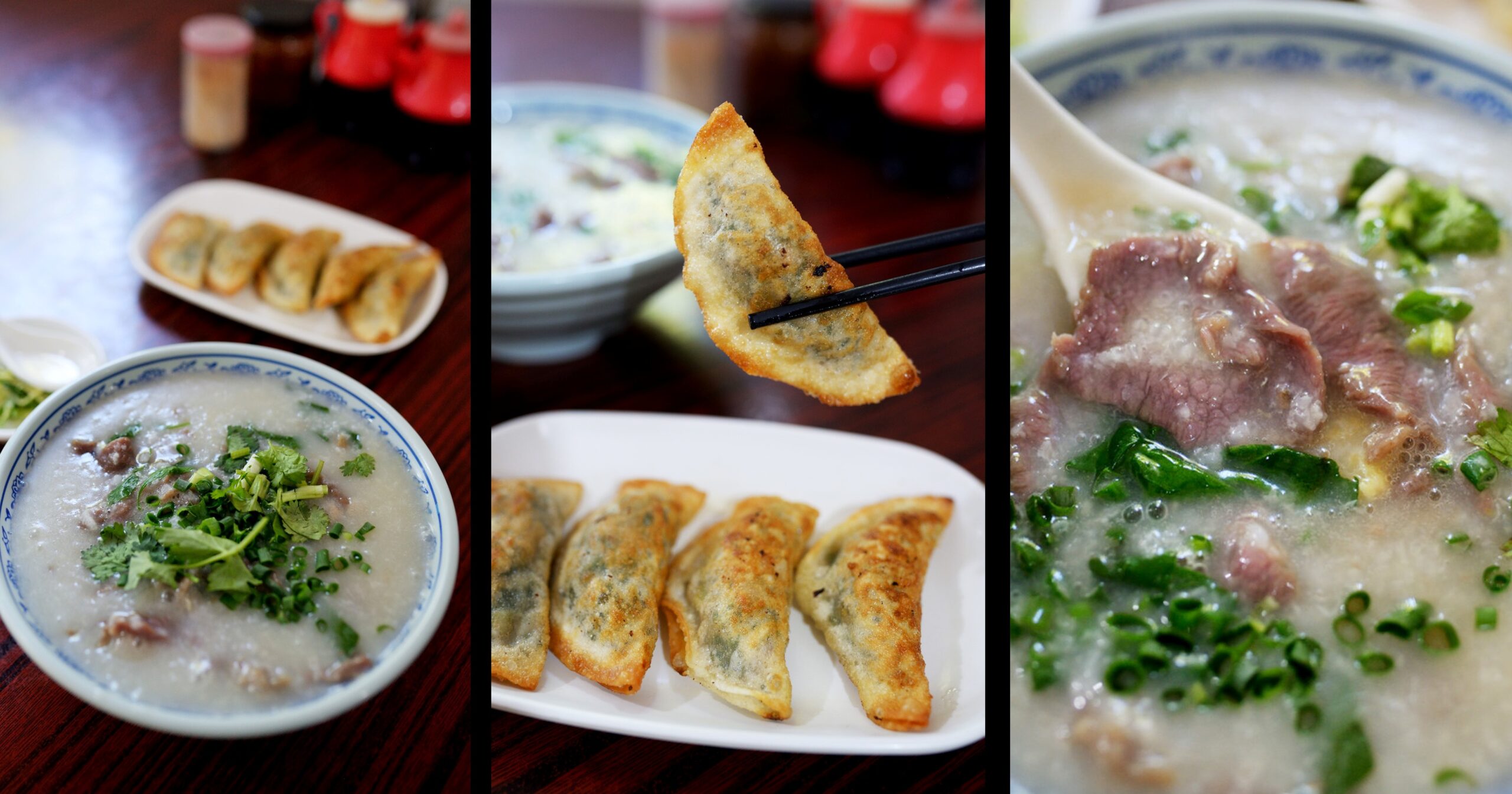
At a Glance
- Location: 顺德区大良鉴海南路 (Jianhai South Road, Daliang, Shunde)
- Avg. Cost: ¥35 per person
- Must-Try Dishes: Raw Egg Beef Congee (窝蛋牛肉粥).
- Pro Tip: The portions are large. Consider sharing one bowl between two people if you plan to eat more elsewhere.
11. Brother & Sister Freshly Boiled Congee (兄妹生滚粥)
The essence of “Sheng Gun Zhou” (freshly boiled congee). A silky congee base, cooked to order with your choice of fresh ingredients.
While Xuan Ji offers a refined congee hot pot experience, Brother & Sister Congee represents its bustling, down-to-earth, and incredibly popular counterpart. This is a top late-night spot for locals, known for its unbeatable value and consistently high quality. The atmosphere is loud, communal, and unapologetically local—expect to share large round tables during peak hours. This is where you find a world-class bowl of congee at a price that feels like a gift.
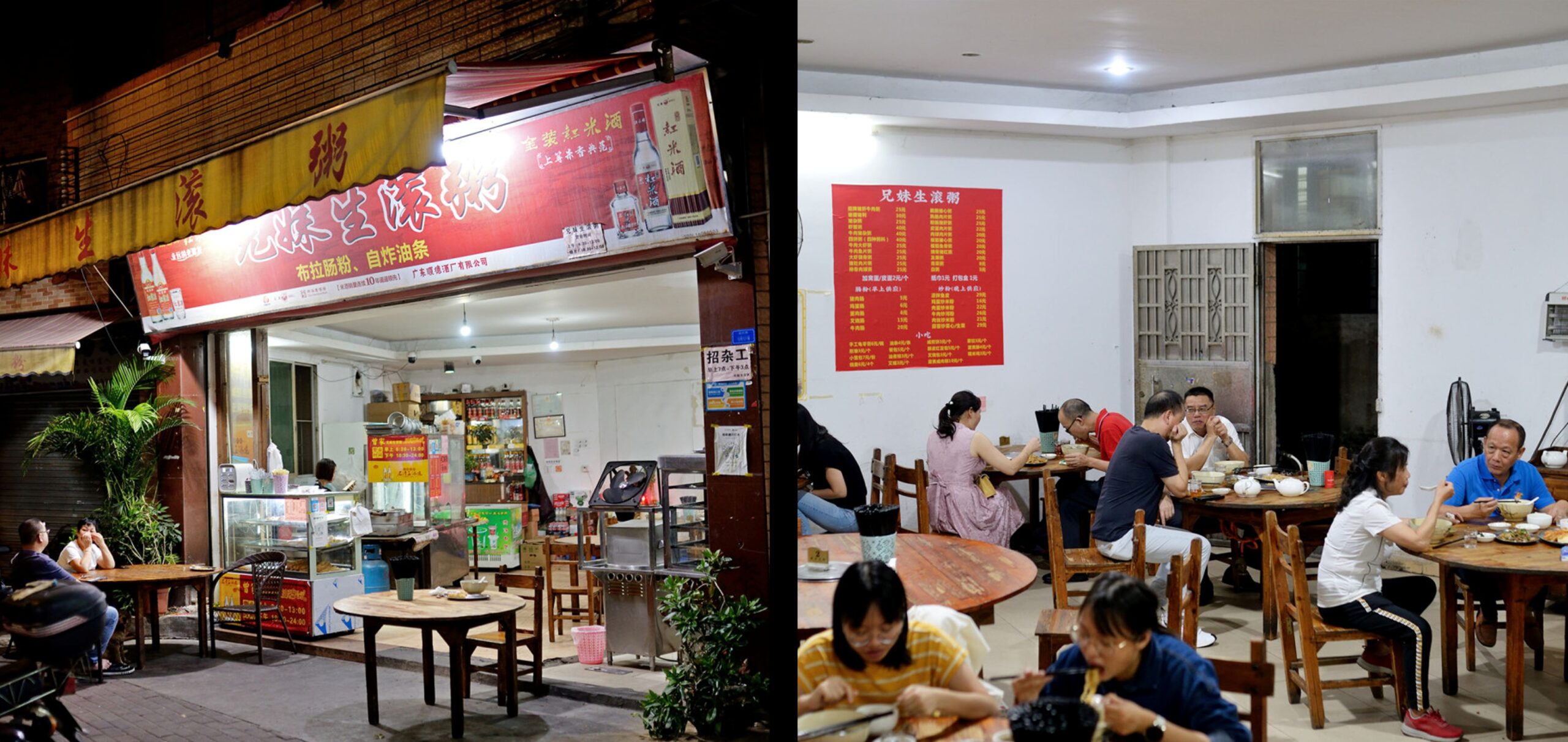
The Art of `Sheng Gun` (生滚) Congee
Unlike the congee hot pot where you cook ingredients yourself, `sheng gun` means “freshly boiled.” Raw ingredients are tossed into a pot of already boiling congee base and cooked to perfection in seconds by the chef before being served. This method captures the freshness and locks in the texture of the ingredients.
Signature Dish: Pork Liver & Beef Congee (招牌猪肝牛肉粥)
This is the bowl that has won the hearts of the city. The congee base itself is outstanding, with every grain of rice boiled until it “blossoms” (`煮至开花`), creating a thick, comforting porridge. A handful of fresh wolfberry leaves (`枸杞叶`) is the finishing touch, adding a subtle, clean sweetness. The toppings are the stars: the pork liver is visibly fresh and cooked to a perfect `shuang cui` (爽脆) texture—crisp-tender and without a hint of gaminess. The beef is silky smooth (`嫩滑`) and incredibly tender. For around 25 RMB, you get a massive bowl overflowing with ingredients—it’s a testament to Shunde’s generous culinary spirit.
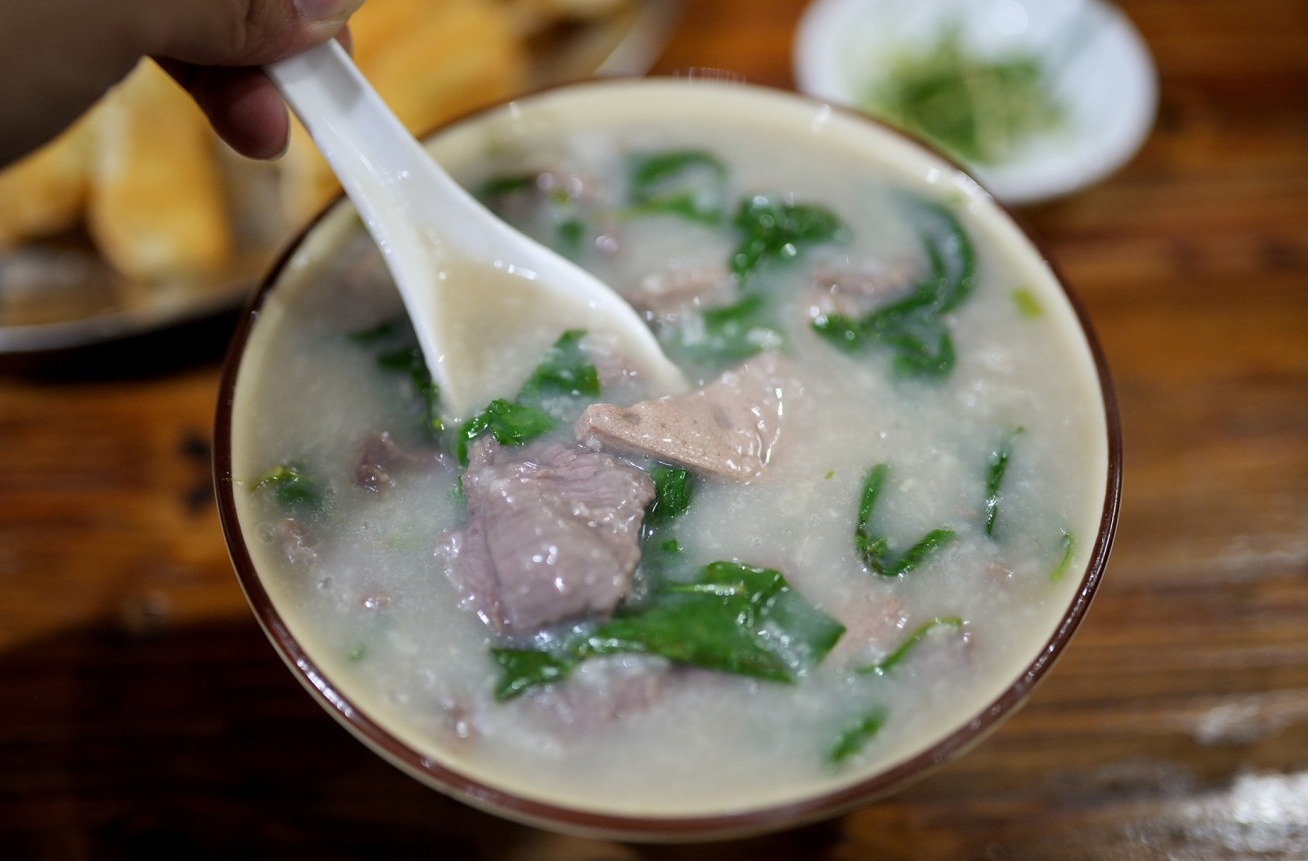
The Essential Companion: Youtiao (油条)
Don’t just order the congee. You must get a side of `youtiao` (fried dough sticks). On its own, it’s standard. But the magic happens when you dip it into the congee. Soaked in the savory porridge, the youtiao transforms, its crisp exterior giving way to a soft, spongy interior (`酥软又有弹性`) that has absorbed all the flavor. It’s the perfect textural contrast and an essential part of the experience.
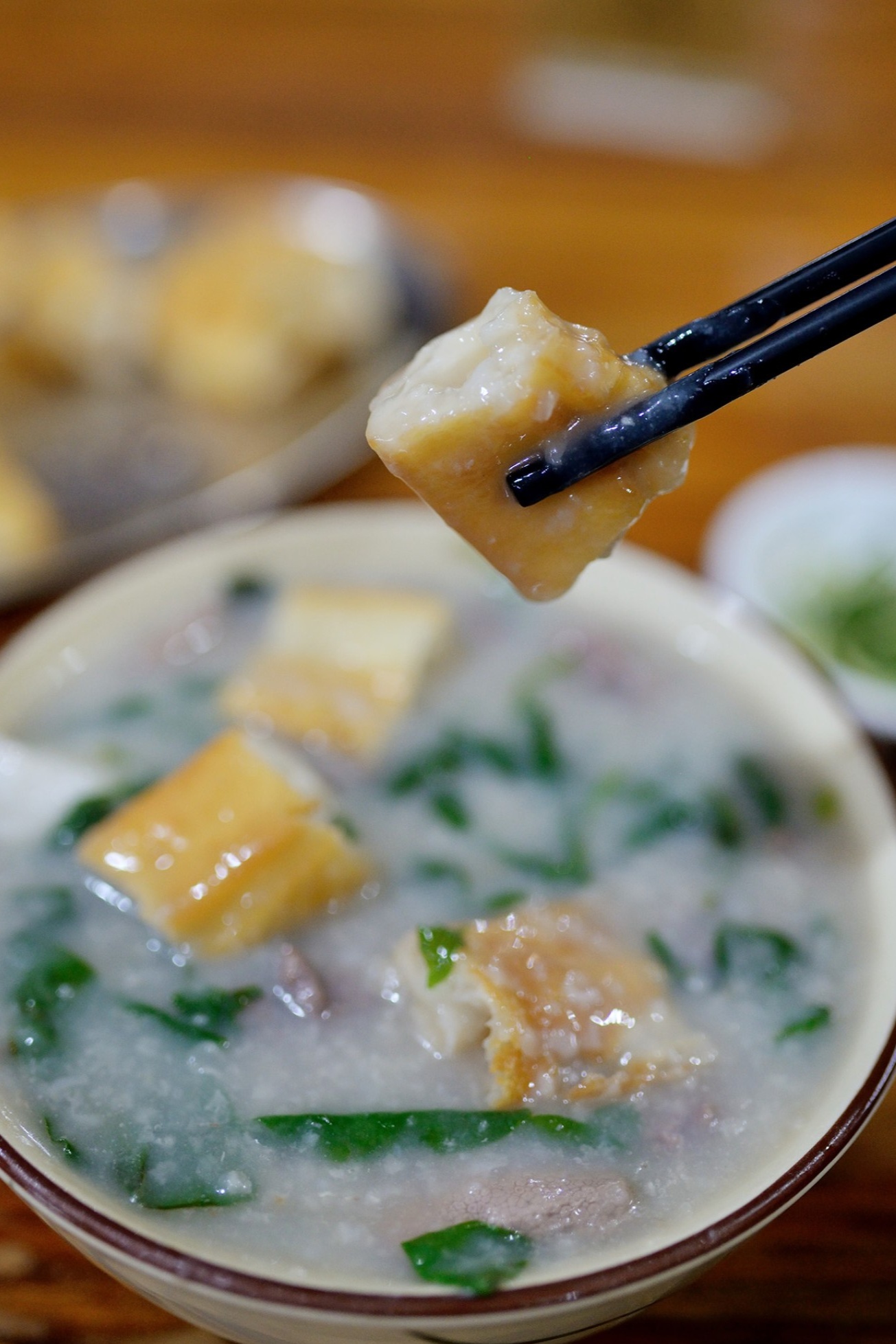
At a Glance
- Address: 广昌路1号之1 (Guangchang Road No. 1-1)
- Avg. Cost: ¥25 per person
- Must-Try Dishes: Signature Pork Liver & Beef Congee, Youtiao (for dipping).
12. Jianguo Noodle Shop (建国面店)
A step back in time. This decades-old shop serves one of the best and most traditional bowls of Wonton Noodles you’ll ever have.
In a city celebrated for grand banquets and elaborate techniques, Jianguo Noodle Shop stands as a monument to the beauty of doing one thing perfectly. This tiny, unassuming hole-in-the-wall is a local institution, a time capsule that has been serving the same classic wonton noodles for decades. The perpetual line of patient customers outside is a testament to its legendary status. This is not just a meal; it’s a taste of Shunde’s collective memory, a pilgrimage for a flavor that has remained unchanged by time.
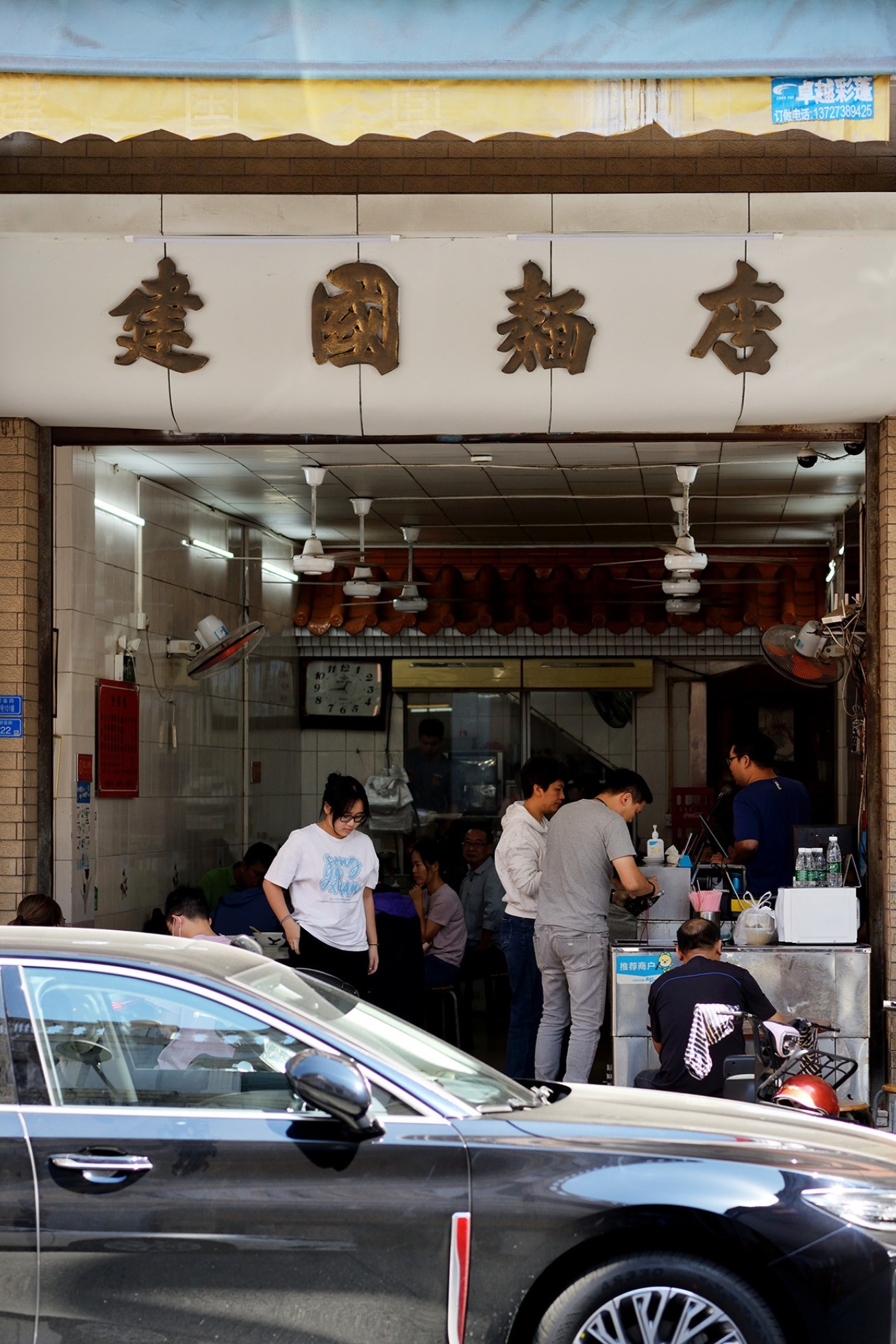
The Holy Trinity: Wontons, Noodles, and Broth
The magic of Jianguo lies in the flawless execution of three core components, each one a masterclass in its own right.
The Dish: Wonton Noodles (云吞面)
This is what everyone is here for. The bowl that arrives is deceptively simple. First, the wontons: plump parcels of fresh pork, seasoned perfectly, with a silky, almost translucent wrapper that glides down your throat. Then, the noodles: traditional, thin egg noodles with a distinct alkaline bite and a wonderfully springy, al dente texture (`爽弹`). Finally, the broth: a clear, light-golden liquid that looks simple but is profoundly flavorful, simmered for hours with pork bones and dried flounder, carrying a deep umami that ties everything together. It’s a harmonious symphony of textures and savory flavors.
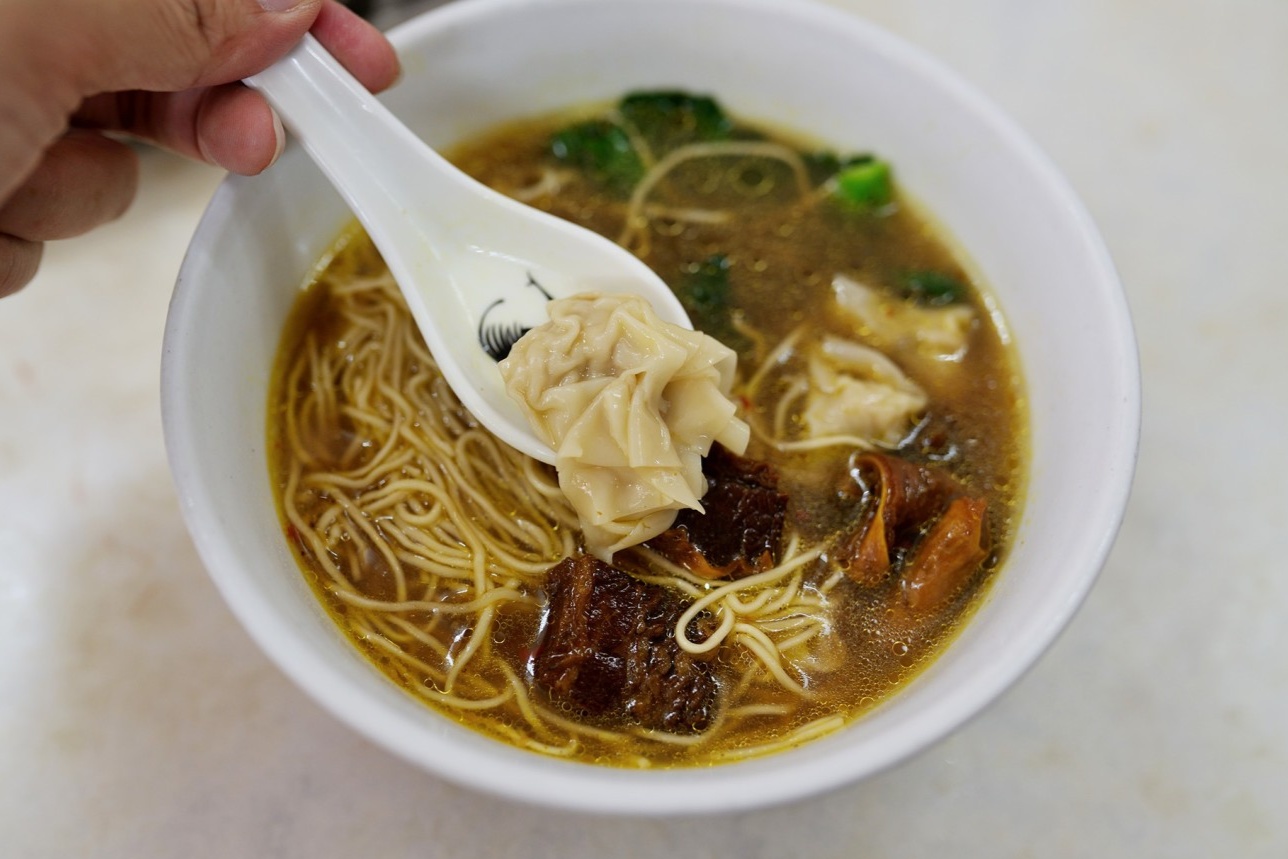
The Perfect Pairing: Fried Dace Fish Balls (炸鲮鱼球)
While waiting, or as a side, order the fried dace fish balls. These golden orbs are crispy on the outside, revealing a dense, bouncy (`Q弹`), and savory fish paste interior. They are the quintessential Shunde snack and the perfect crunchy counterpoint to the soft, soupy noodles. Often served with a side of local clam sauce (`蚬蚧酱`) for dipping, they add another layer of authentic flavor to your meal.
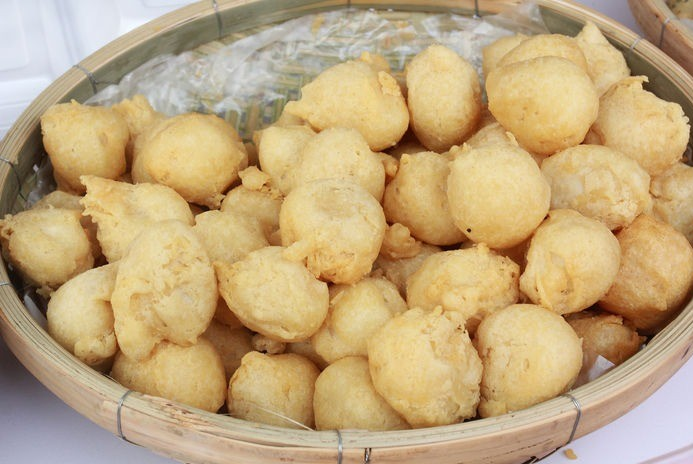
At a Glance
- Address: 顺德区大良街道碧鉴路18号 (No. 18, Bijian Road, Daliang, Shunde)
- Avg. Cost: ¥25 per person
- Must-Try Dishes: Wonton Noodles (云吞面), Fried Dace Fish Balls (炸鲮鱼球).
Street Food & Snacks
The streets of Shunde are an extension of its kitchens. Here, you’ll find iconic snacks that have been loved for generations, offering quick, delicious, and authentic bites of local culture.
15. Ximei Five-Spice Beef Offal ( 五香牛杂)
The quintessential Shunde street snack. A bubbling cauldron of fragrant, five-spice broth holds the city’s most beloved beef offal.
Located on the bustling Huagai Road Pedestrian Street, Ximei has been a Shunde institution since 1981. This isn’t a restaurant you find; it’s a scent that finds you. The rich, layered aroma of five-spice and simmering beef offal wafts down the street, an inescapable invitation to one of the city’s most beloved street food treasures. Following the scent to this humble stall is a rite of passage for any visitor.
The Soul of the Dish: The Braising Broth
What makes Ximei legendary is its `lou zap` (卤汁), or braising broth. It’s a complex, dark, and intensely fragrant liquid perfected over four decades. The five-spice blend is prominent but not overpowering, creating a flavor that is deeply savory with layers of subtle sweetness and spice. The menu is refreshingly simple, focusing on two key items: beef tripe (`牛肚`) and beef intestines (`牛肠`), slow-stewed to perfection in this magical broth.
The tripe is tender yet retains a satisfying chewiness (`软烂却不失咀嚼感`), while the intestines are impeccably clean, with no gamey taste. A standard portion comes with radish, which absorbs the broth and becomes incredibly sweet, and fried tofu puffs that act as little sponges for the savory sauce.
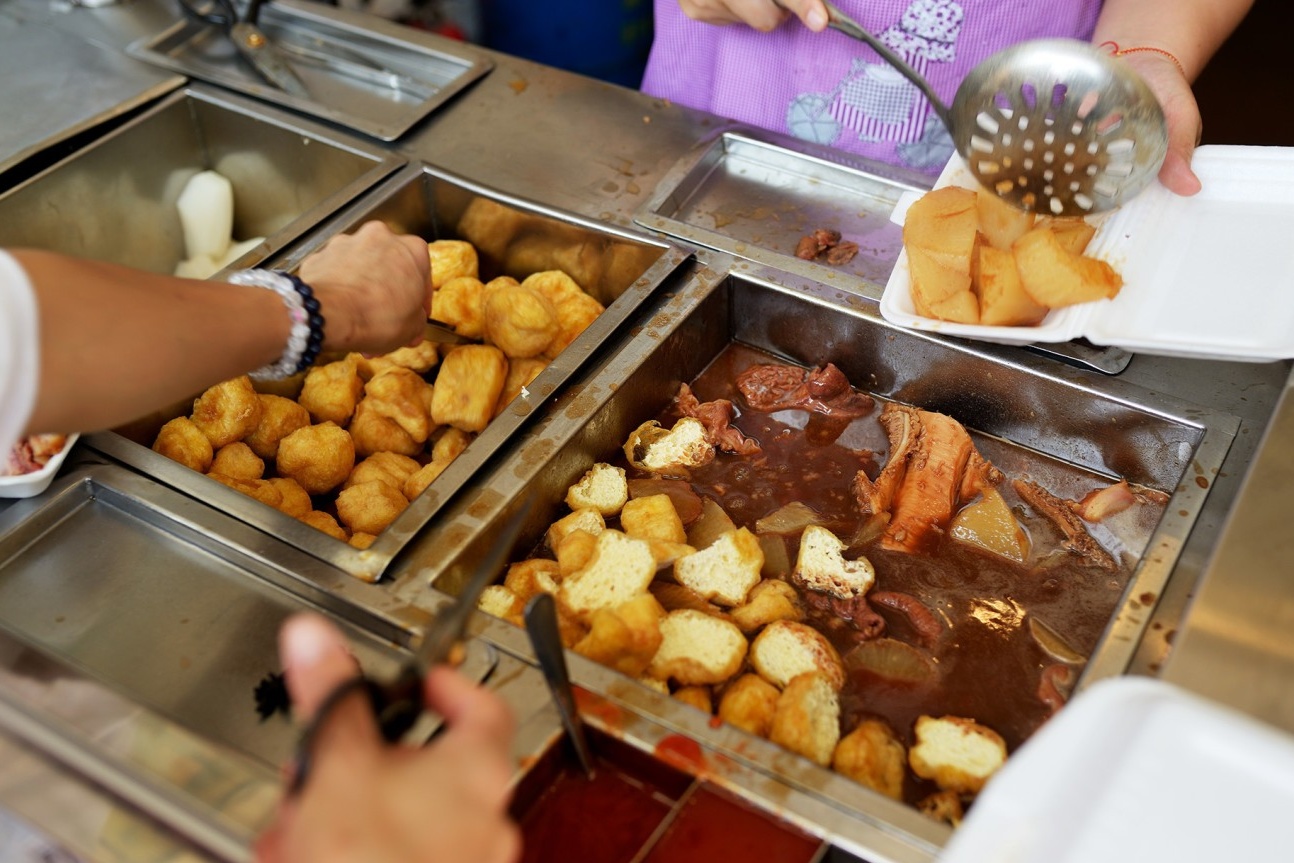
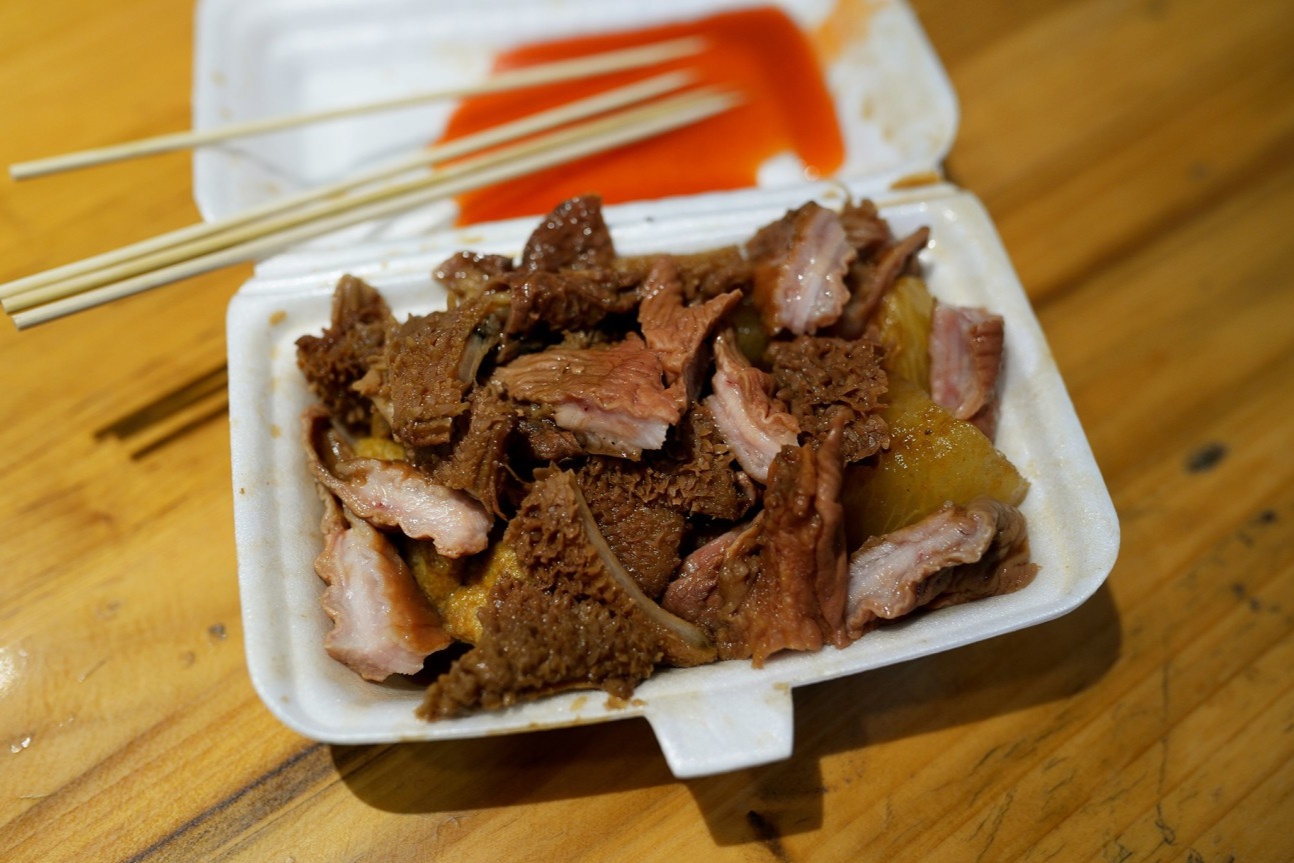
The Perfect Accompaniments
Two things elevate the Ximei experience from great to unforgettable. First is the house-made garlic chili sauce. It has a unique sweet and sour profile that cuts through the richness of the offal and brightens every bite. Second is the freshly squeezed sugarcane juice. Each bottle is made from a single stalk of sugarcane, resulting in a pure, refreshing sweetness that perfectly cleanses the palate. There’s a local saying, `掂过碌蔗` (dim gwo luk ze), which literally means “straighter than a sugarcane stalk” and figuratively means “everything is going great!”—a feeling you’ll surely have after this meal.
At a Glance
- Address: 华盖里直街信发楼3号铺 (Shop 3, Xinfa Building, Huagai Li Zhi Street)
- Avg. Cost: ¥30 per person
- Must-Try Dishes: Five-Spice Beef Offal, Freshly Squeezed Sugarcane Juice.
16. Uncle Hua’s Cha Kee (华叔茶记)
A true local “cha chaan teng” experience, famous for its pineapple buns and milk tea. This is where locals go for a casual afternoon break.
Uncle Hua’s Cha Kee greets visitors with a dose of playful self-deprecation: its sign proudly proclaims it’s a “Ten-year-old brand, only seven more years to go!” (`十年老字号,还差七年`). While not a traditional `老字号`, this trendy “internet-famous” (`网红`) spot has earned its place on “must-eat” lists by delivering food that genuinely lives up to the buzz. Tucked away in a small alley near the famous Qinghui Garden, the cafe is housed in a converted old building. The interior is simple, but the walls are adorned with retro Hong Kong-style posters, creating a cool, nostalgic vibe.
Pro Tip: This place is notorious for long queues. To avoid the wait, try visiting on a weekday, especially around noon.
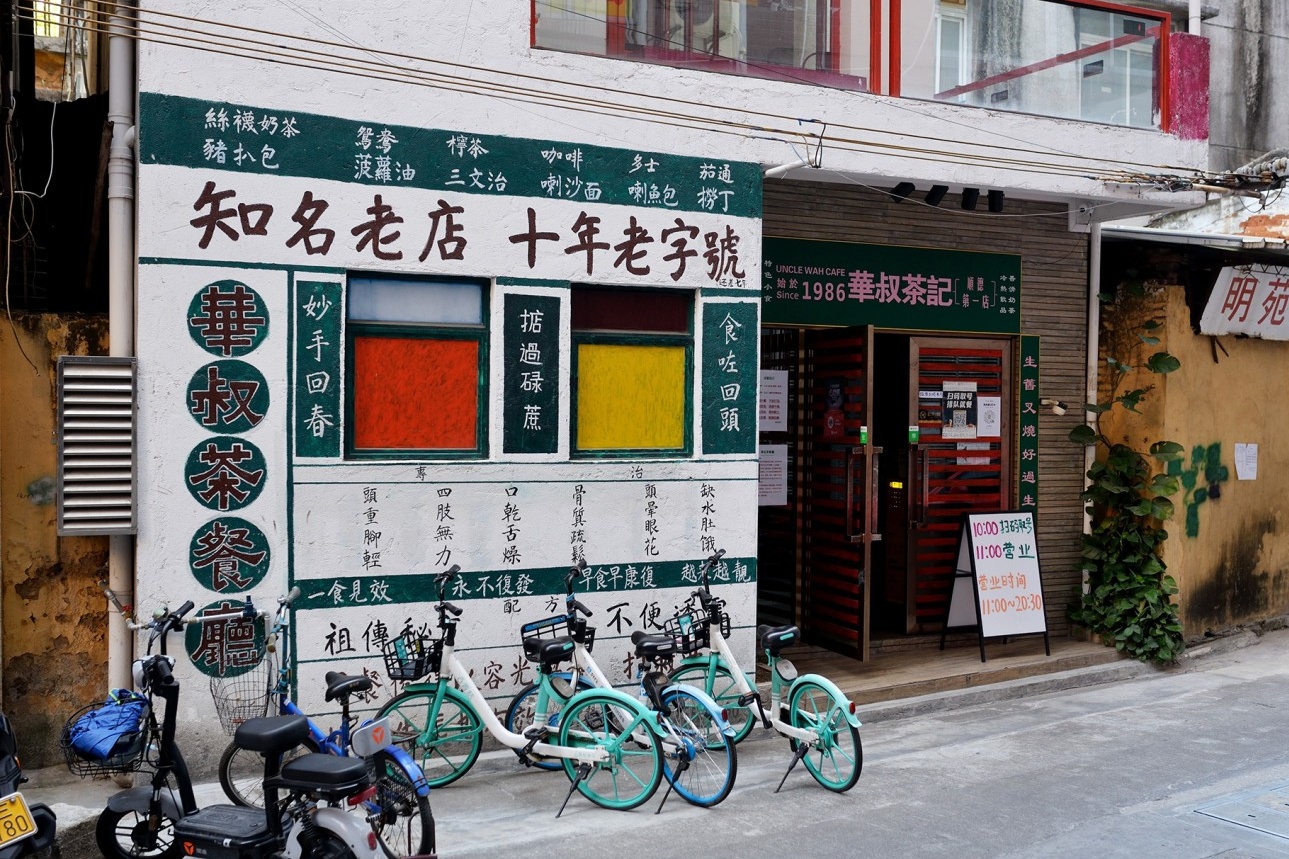
The Main Event: Four Joys Cheong Fun (华叔四喜猪肠粉)
While the menu is extensive, the undisputed star is the “Four Joys Cheong Fun.” This isn’t your average rice noodle roll; it’s a full, satisfying meal. The dish starts with classic Hong Kong-style `猪肠粉` (cheong fun), served on traditional wax paper and drizzled with a delightful sweet and savory trio of soy sauce, sweet sauce, and sesame paste. But the “Four Joys” are what make it legendary.
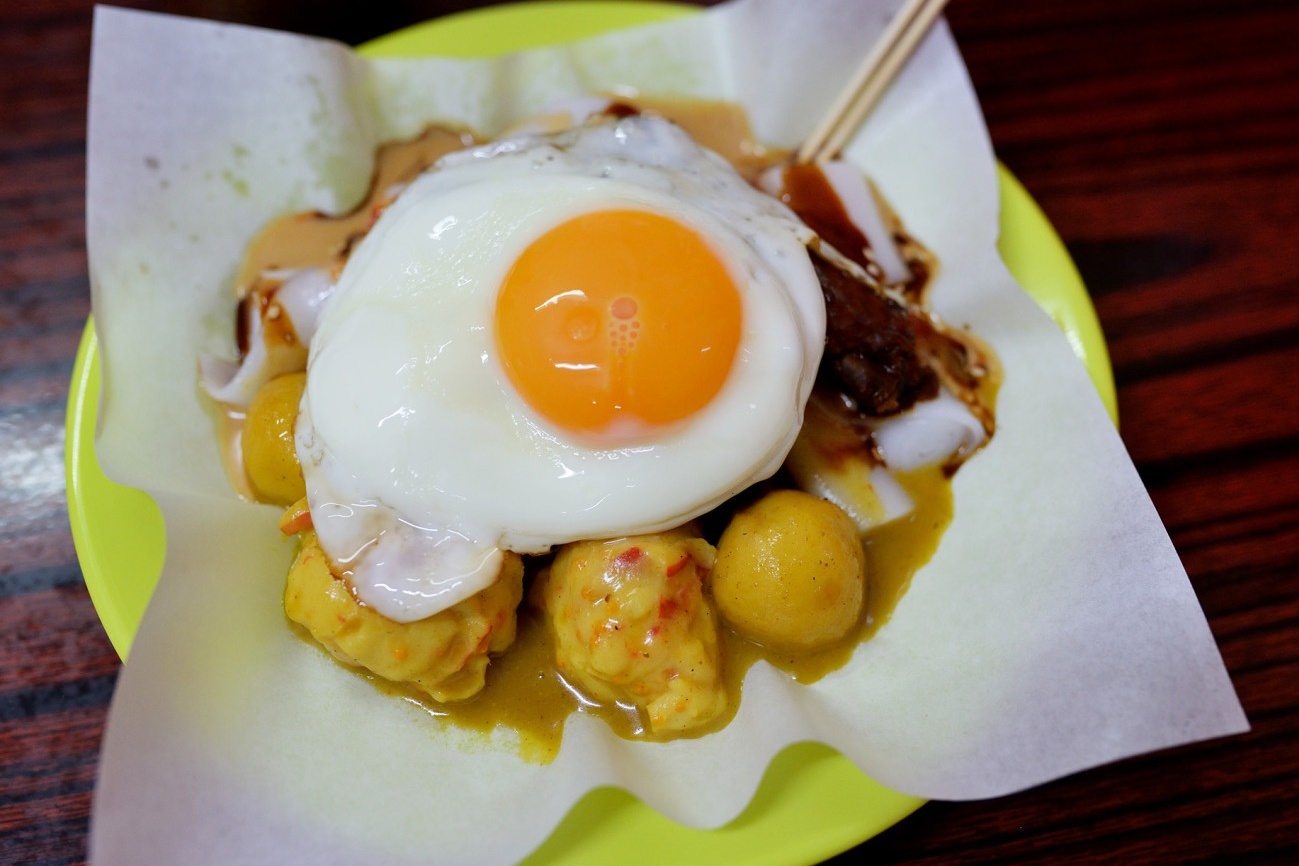
A Quartet of Toppings
The dish is loaded with a quartet of savory toppings: tender Swiss chicken wings, bouncy fish balls, flavorful lobster balls, and a perfectly cooked sunny-side-up egg (`太阳蛋`), all brought together with a fragrant curry sauce.
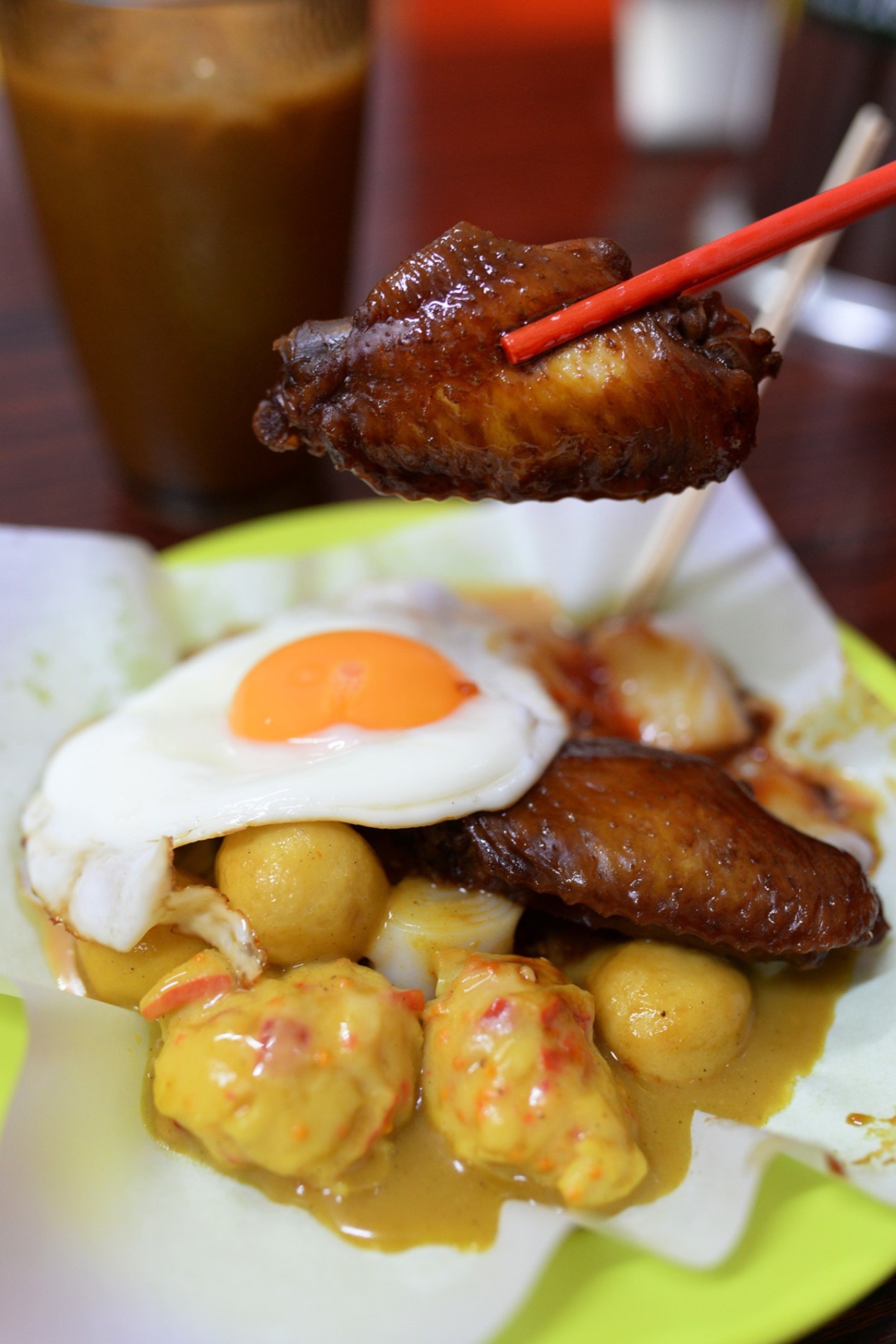
The Ultimate Bite
The crowning glory is the egg. Break the yolk and let the rich, velvety liquid coat the rice noodle rolls. This simple act elevates the entire dish, creating a sublime texture and flavor that you won’t soon forget.
At a Glance
- Location: 顺德区大良街道,清晖园附近的小巷子里 (In an alley near Qinghui Garden, Daliang, Shunde)
- Avg. Cost: ¥40 per person
- Must-Try Dishes: Uncle Hua’s Four Joys Cheong Fun (华叔四喜猪肠粉).
Guoying Stewed Soups (国英炖品店)
Nourishment, One Slow-Simmered Bowl at a Time
In Cantonese culinary culture, soup is more than a starter; it’s a form of medicine, comfort, and love. Guoying Stewed Soups is a temple to this tradition. For over 30 years, this humble shop has specialized in `dun tang` (炖汤)—double-boiled soups simmered for hours in individual ceramic jars. This slow, gentle cooking method extracts the deepest flavors and nutrients from the ingredients, creating broths that are intensely flavorful yet light and clear. A visit here is a nourishing experience for both body and soul.
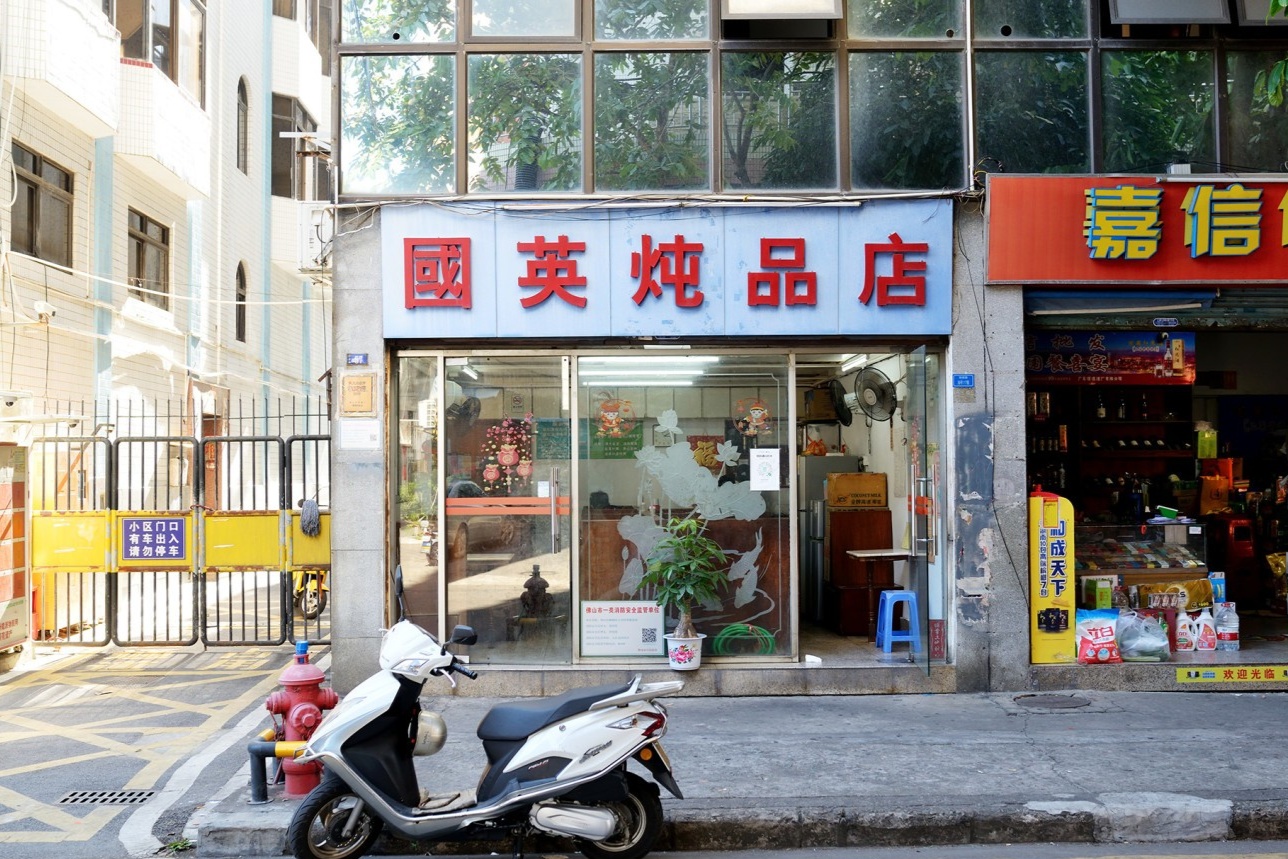
The Signature Stew: Scorpion & Silkie Chicken (党参乌鸡炖蝎子)
The must-try item on their menu of over a dozen options is the Codonopsis, Silkie Chicken, and Scorpion Stew. Each serving is a testament to the shop’s generosity, containing no fewer than six whole scorpions. The broth is slow-stewed with cogongrass rhizome (`茅根`) and longan (`桂圆`), resulting in a clear, deeply flavorful soup that is naturally sweet with a pleasant, subtle medicinal aftertaste. It’s the kind of soul-warming nourishment that Cantonese cuisine is famous for.
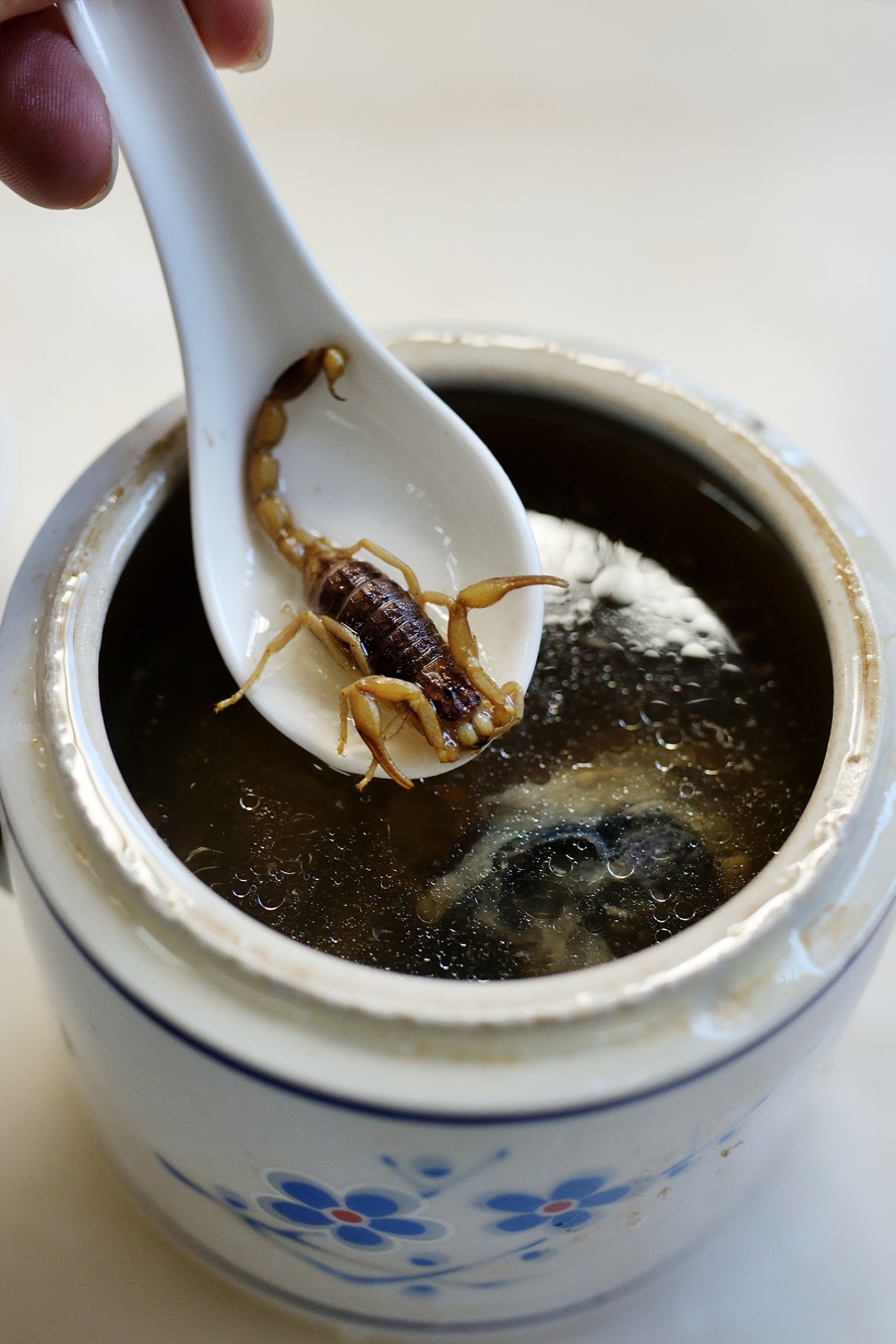
Don’t Waste the Dregs! (别浪费汤渣)
In Cantonese soup culture, the solid ingredients left after drinking the broth, known as `汤渣` (tang zha), are just as important. The shop provides a small dish of soy sauce for dipping. The silkie chicken meat, having simmered for hours, is incredibly tender and fragrant. And for the adventurous eater, the scorpions await. If you dare to take a bite, you’ll be rewarded with a unique “bursting” sensation (`爆浆的感觉`) and a surprisingly wonderful texture. It’s a culinary experience you won’t find just anywhere.
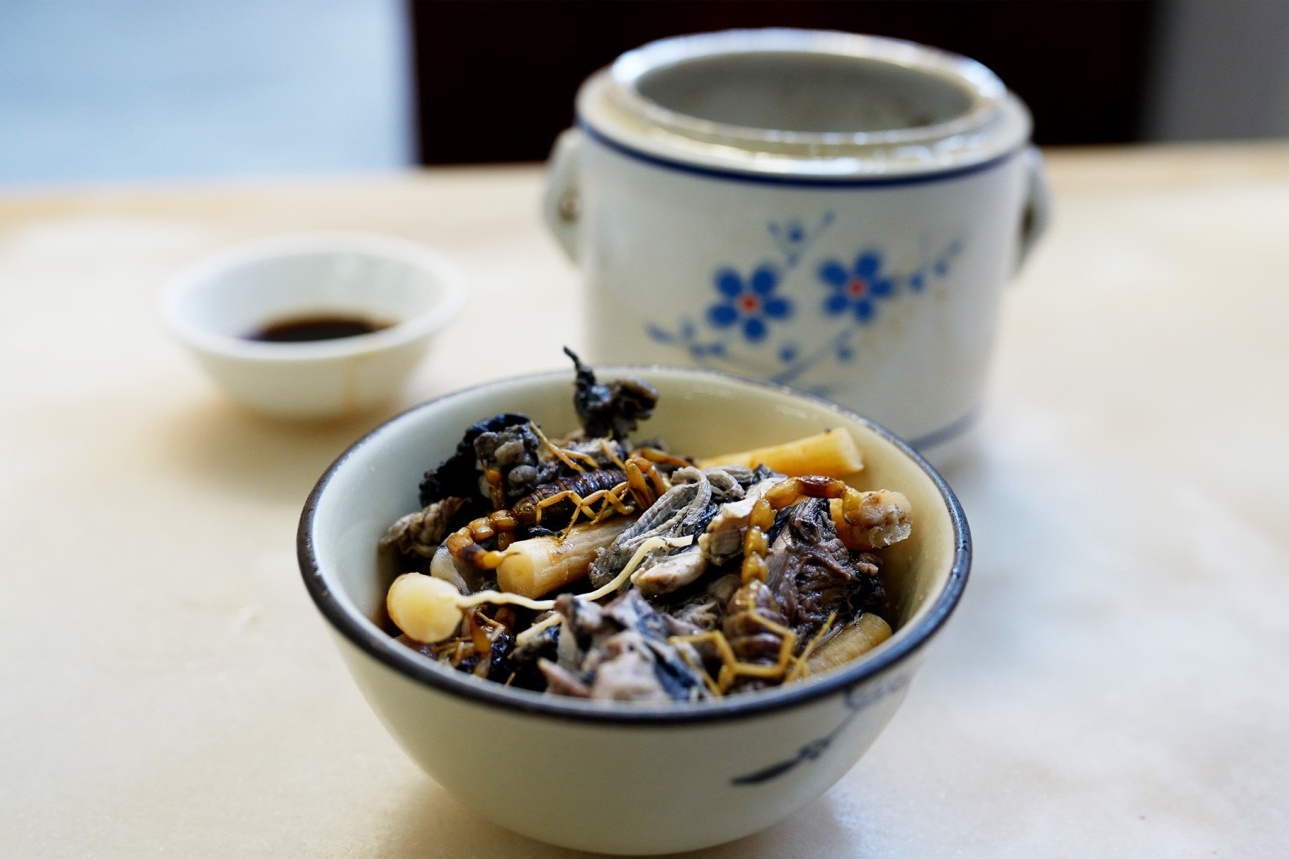
At a Glance
- Location: 顺德区大良甲子路 (Jiazi Road, Daliang, Shunde)
- Avg. Cost: ¥50 per person
- Must-Try Dishes: Codonopsis Silkie Chicken and Scorpion Stew (党参乌鸡炖蝎子).
- Pro Tip: Be brave and try the scorpion! It’s a unique local delicacy. Remember to enjoy the solid ingredients (`汤渣`) with the provided soy sauce after finishing the broth.
Desserts & Sweets
A culinary journey through Shunde isn’t complete without indulging in its famous desserts. Many of these sweet treats revolve around one prized local ingredient: rich, creamy water buffalo milk. But the world of Shunde sweets goes far beyond that.
17. Big Tree Desserts (大树头甜品店)
An open-air dessert stall set under a large, shady tree, serving classic sweet soups and treats for decades.
For over two decades, Big Tree Desserts has been a beloved local secret in Beijiao town. True to its name, the shop operates from a humble storefront shaded by a large, old tree. It’s the quintessential “sweeping monk” (`扫地僧`) of the food world—unassuming in appearance but possessing extraordinary skill. While tourists flock to more famous spots, locals come here for authentic, nostalgic, and incredibly affordable desserts. This is not a trendy dessert shop; it’s a taste of Shunde’s unadorned, everyday sweetness.
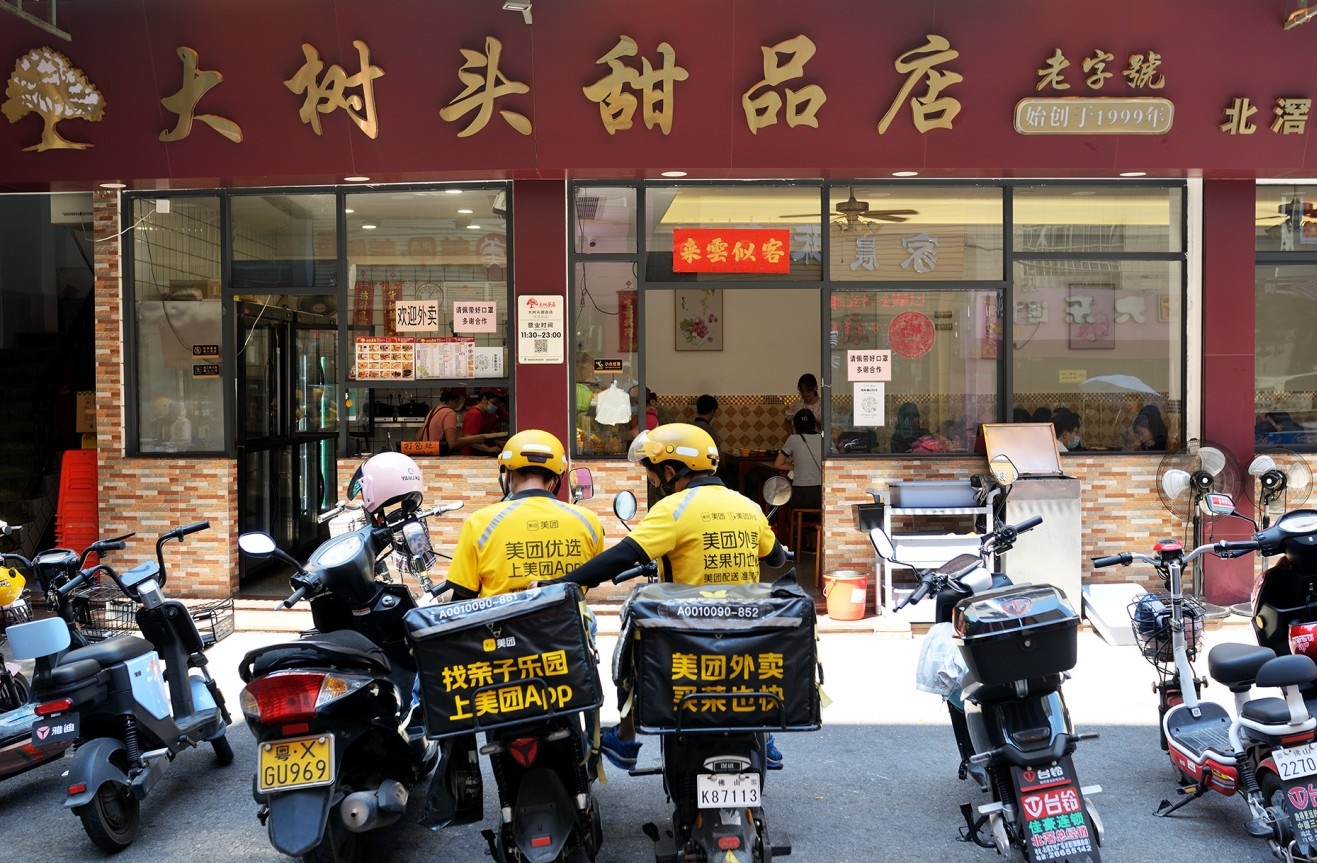
The Undisputed Champion: Sugarcane & Water Chestnut Drink (蔗葛马蹄水)
While the menu is extensive, one item is non-negotiable: the Sugarcane, Arrowroot, and Water Chestnut Drink. It’s the drink you’ll find on every single table. For a mere 6 RMB, you get a huge, steaming bowl filled with a generous piece of arrowroot (`葛根`) and whole water chestnuts (`马蹄`). The broth, simmered with sugarcane, is beautifully clear and possesses a profound, natural sweetness that is both comforting and incredibly refreshing. It’s the perfect remedy for the Guangdong heat, a drink that soothes and hydrates.
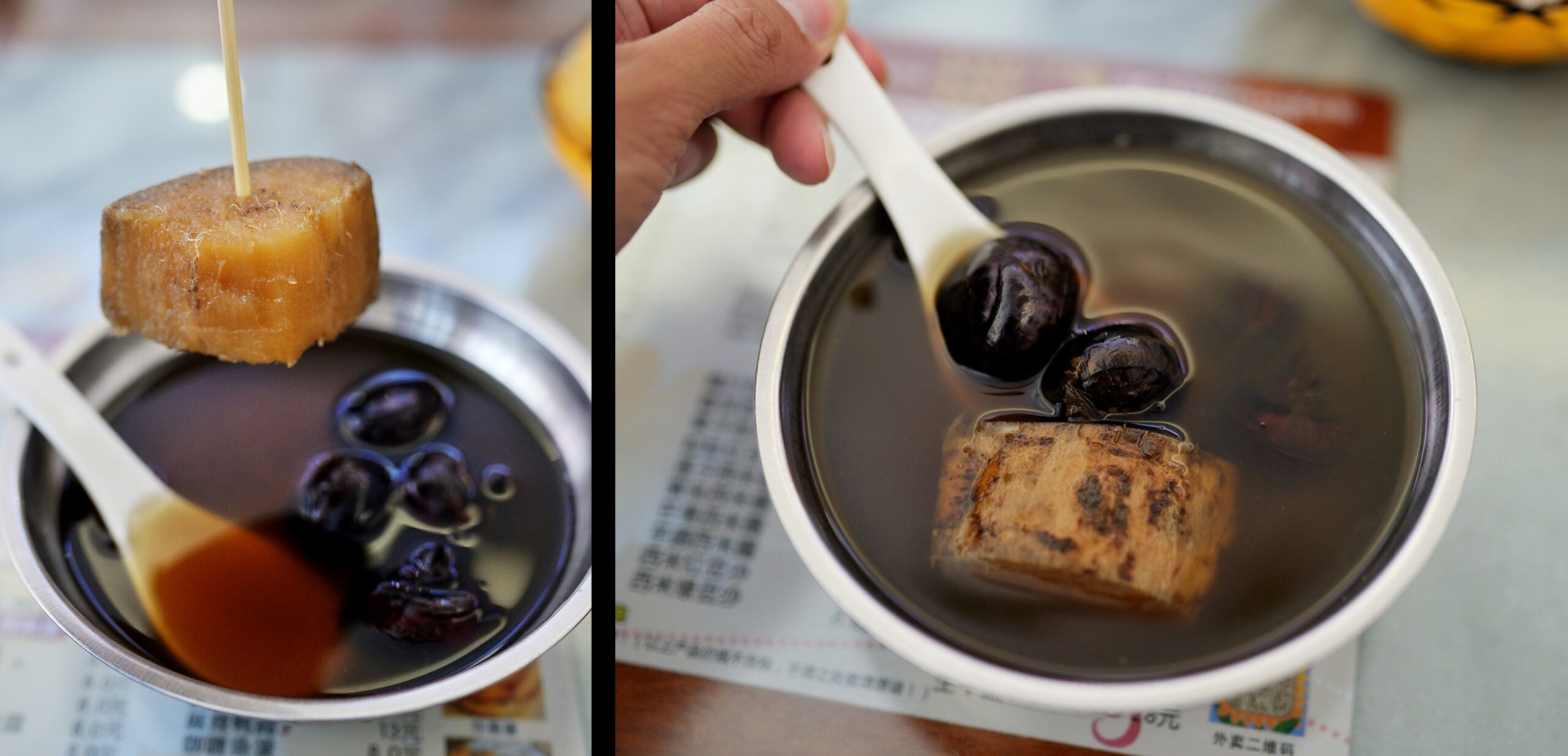
The Perfect Snack: Fried Sweet Potato (炸番薯)
Another crowd favorite is the fried sweet potato. These aren’t just simple fries. They are coated in a light, crispy batter and fried to a perfect golden-brown. The magic is in the contrast: the exterior is delightfully crunchy, while the sweet potato inside is soft, fluffy, and intensely sweet (`软糯香甜`). Despite being fried, they are surprisingly non-greasy, making them an addictive snack that pairs perfectly with their refreshing drinks.
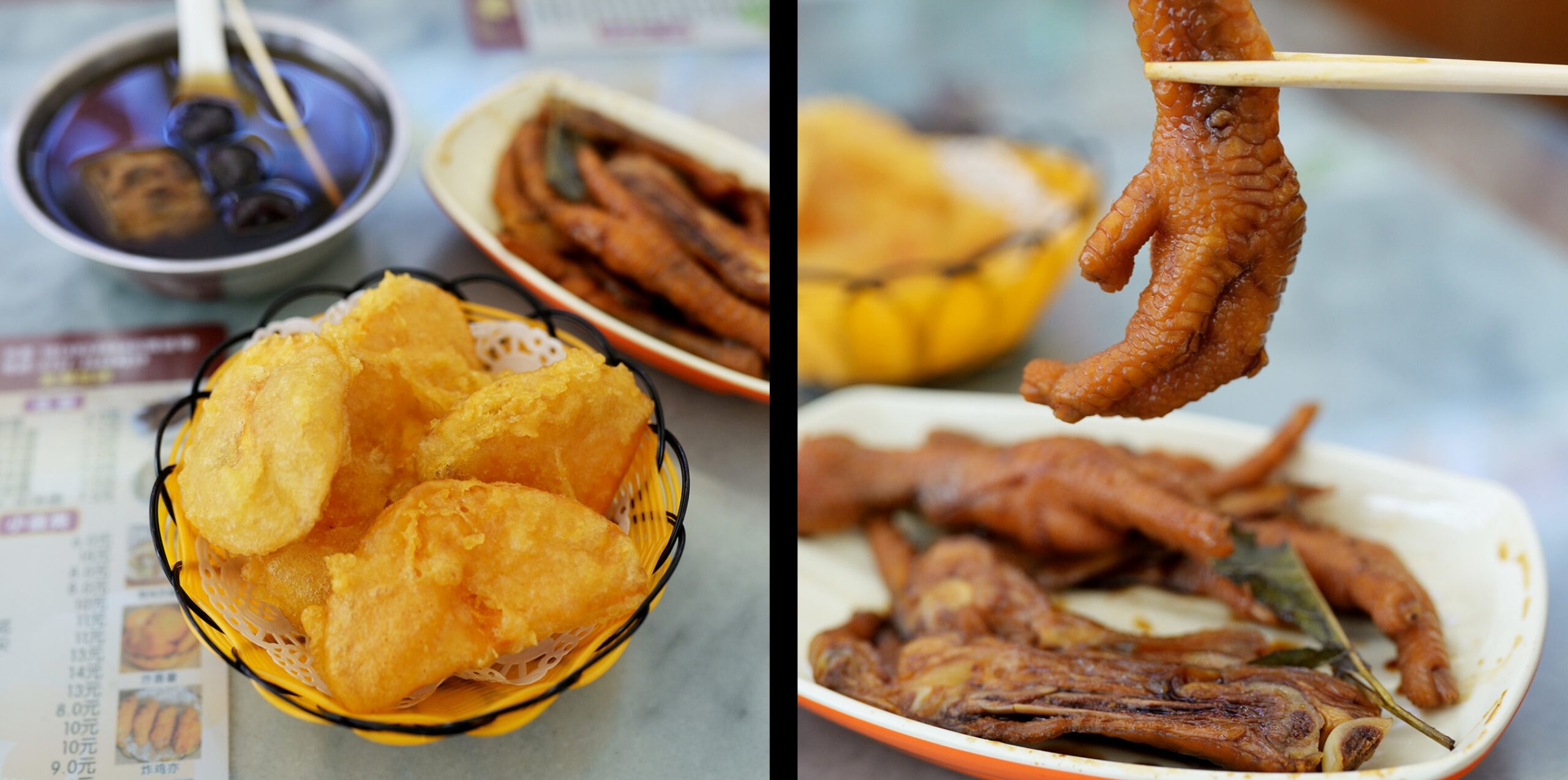
At a Glance
- Address: 顺德区北滘镇上僚村东兴路 (Dongxing Road, Shangliao Village, Beijiao, Shunde)
- Avg. Cost: ¥15 per person
- Must-Try Dishes: Sugarcane & Water Chestnut Drink (蔗葛马蹄水), Fried Sweet Potato (炸番薯).
18. Jinbang Old Neighbor (金榜老街坊)
Another master of buffalo milk desserts, located on the historic Jinbang street. A great alternative to the more crowded spots.
To talk about Shunde cuisine is to talk about Double-Skin Milk (`双皮奶`), and its heartland is Jinbang Village (金榜村). This area was once the center of Shunde’s water buffalo industry, and today, its “Buffalo Milk Street” (`牛乳街`) is still lined with milk shops, filling the air with a sweet fragrance. Jinbang Old Neighbor, while only a few years old, has already shot to fame, earning a spot on the “must-eat” lists twice. Its success is a testament to its mastery of this classic dessert.
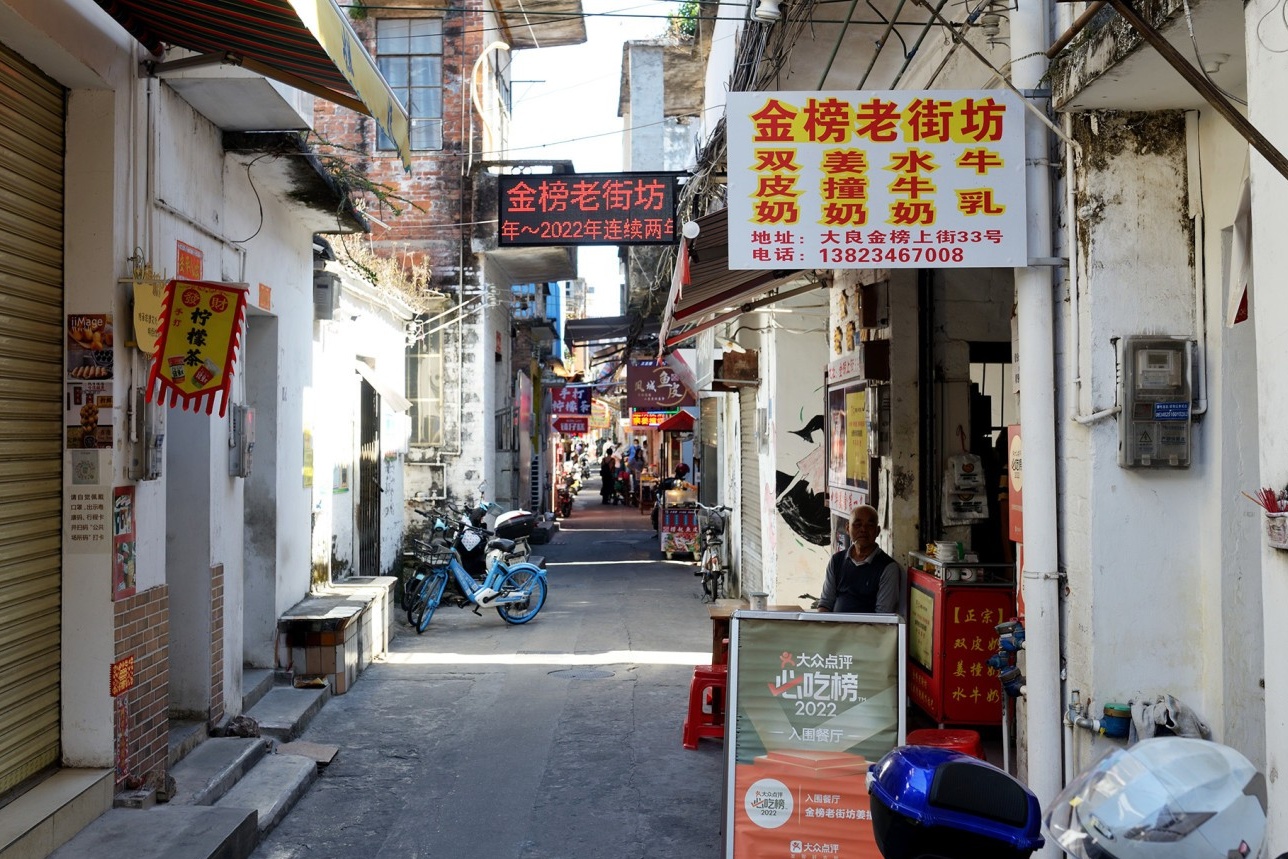
The Art of Water Buffalo Milk Desserts
The secret to authentic Shunde milk desserts is water buffalo milk, whose high fat content (up to 8%) yields a much richer and more fragrant flavor than regular cow’s milk.
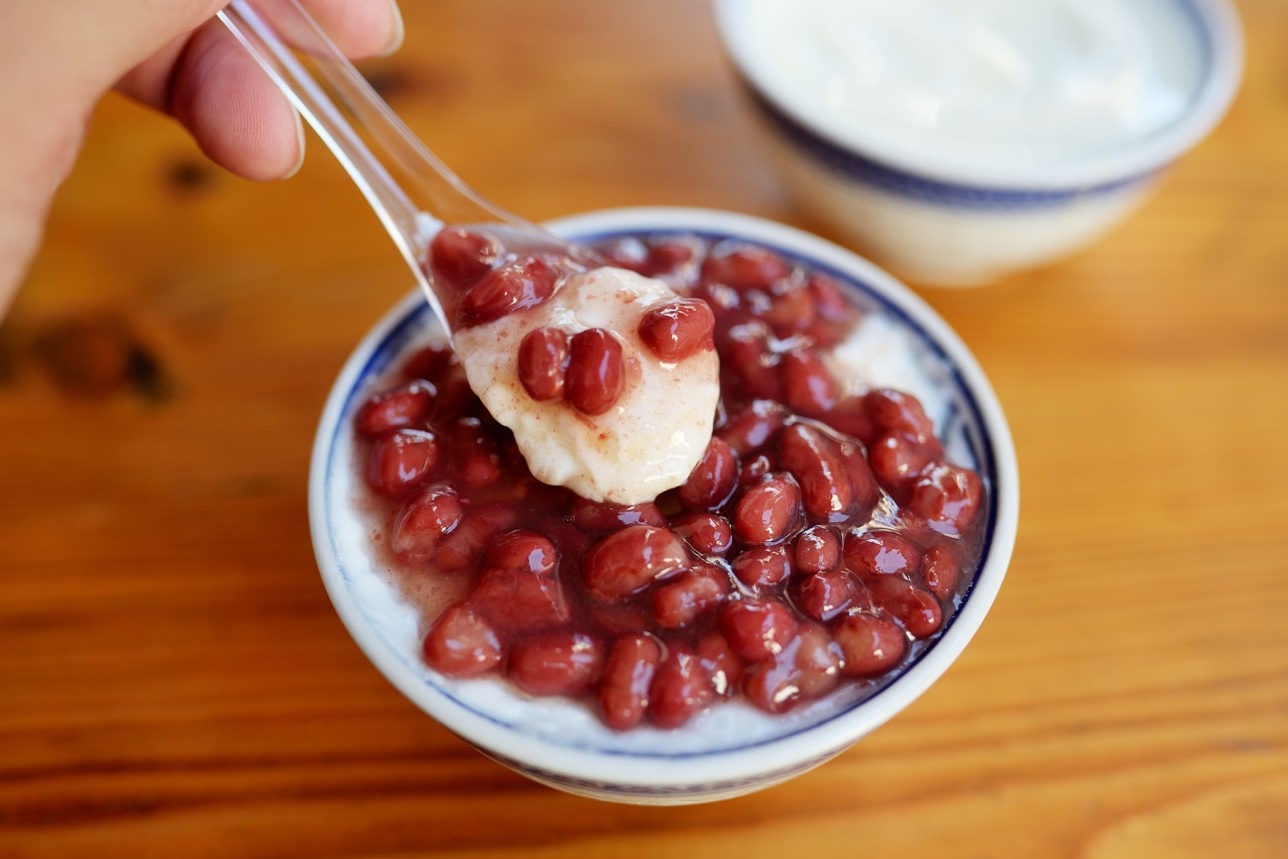
Red Bean Double-Skin Milk (红豆双皮奶)
This shop’s rendition is a masterclass. The milk skin is thick with a wonderful texture (`奶皮比较厚实,很有质感`). The pudding itself is perfectly sweetened, allowing the full-bodied milk flavor to dominate. Topped with sweet red beans, the combination is simply impeccable.
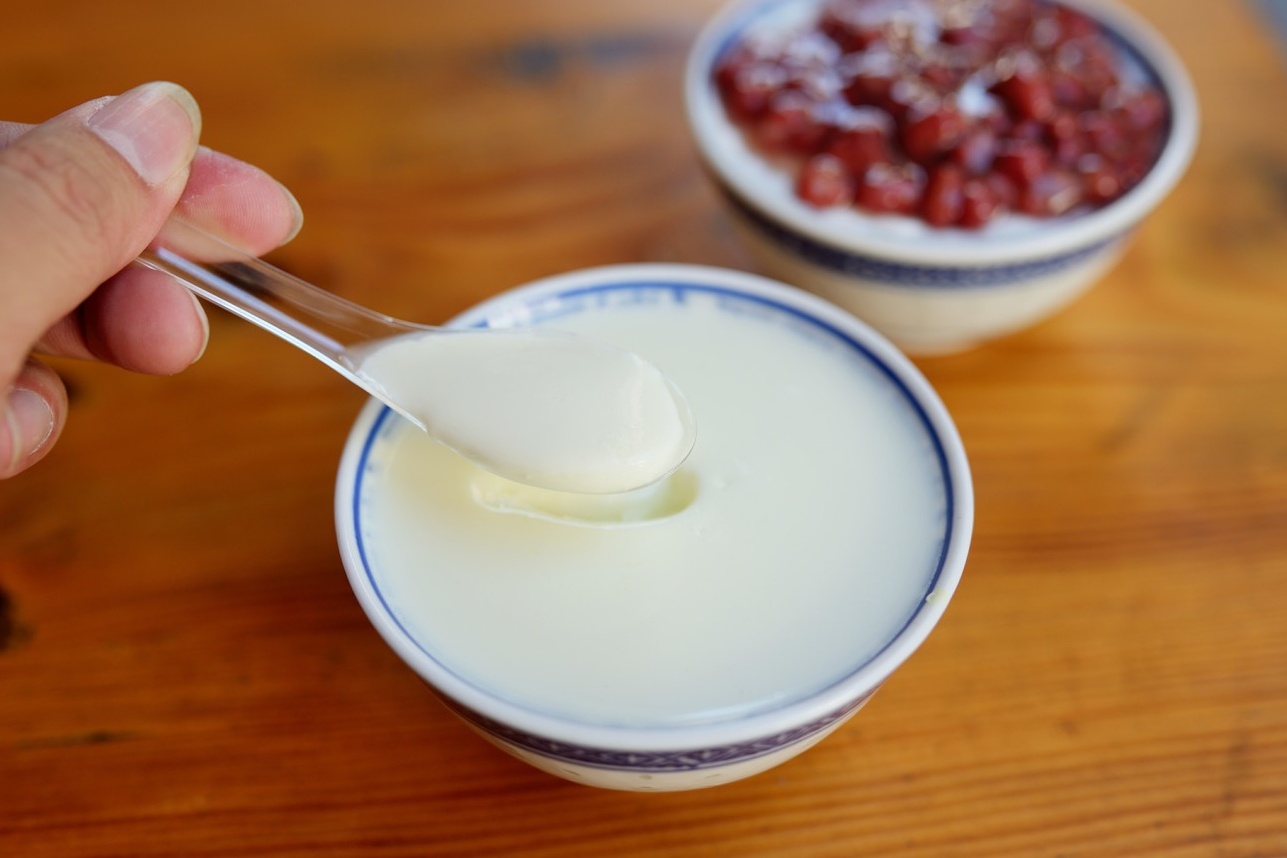
Ginger Milk Curd (姜撞奶)
This dessert is a spectacle of food chemistry, where hot milk and ginger juice collide to form a delicate, semi-solid curd. It’s smoother and slightly less sweet than Double-Skin Milk. The mingling of milk and ginger is irresistible. Pro-tip: if you order both, eat this one first!
At a Glance
- Location: 顺德区大良金榜上街19号 (No. 19, Jinbang Shangjie, Daliang, Shunde)
- Avg. Cost: ¥15 per person
- Must-Try Dishes: Red Bean Double-Skin Milk (红豆双皮奶), Ginger Milk Curd (姜撞奶).
- Pro Tip: Buffalo Milk Street is a must-visit for any food lover. While here, you can also find traditional shops selling savory Buffalo Milk Slices (`牛乳片`).
19. Granny Zhou’s Buffalo Milk (周大娘牛乳)
A taste of pure artisanship. This is not a dessert shop, but a workshop selling the raw, foundational ingredient of Shunde’s dairy fame: buffalo milk sheets.
Another celebrated name in Shunde’s dairy scene is Granny Zhou’s Buffalo Milk. Its main branch, located in the old Jiuzhai Village near Shunfeng Mountain Park, offers a truly special atmosphere. Housed in a large, antique-style building with a beautiful courtyard (`古香古色,有个大大的院子`), it’s an incredibly comfortable and picturesque spot to savor some of the region’s finest sweet treats.
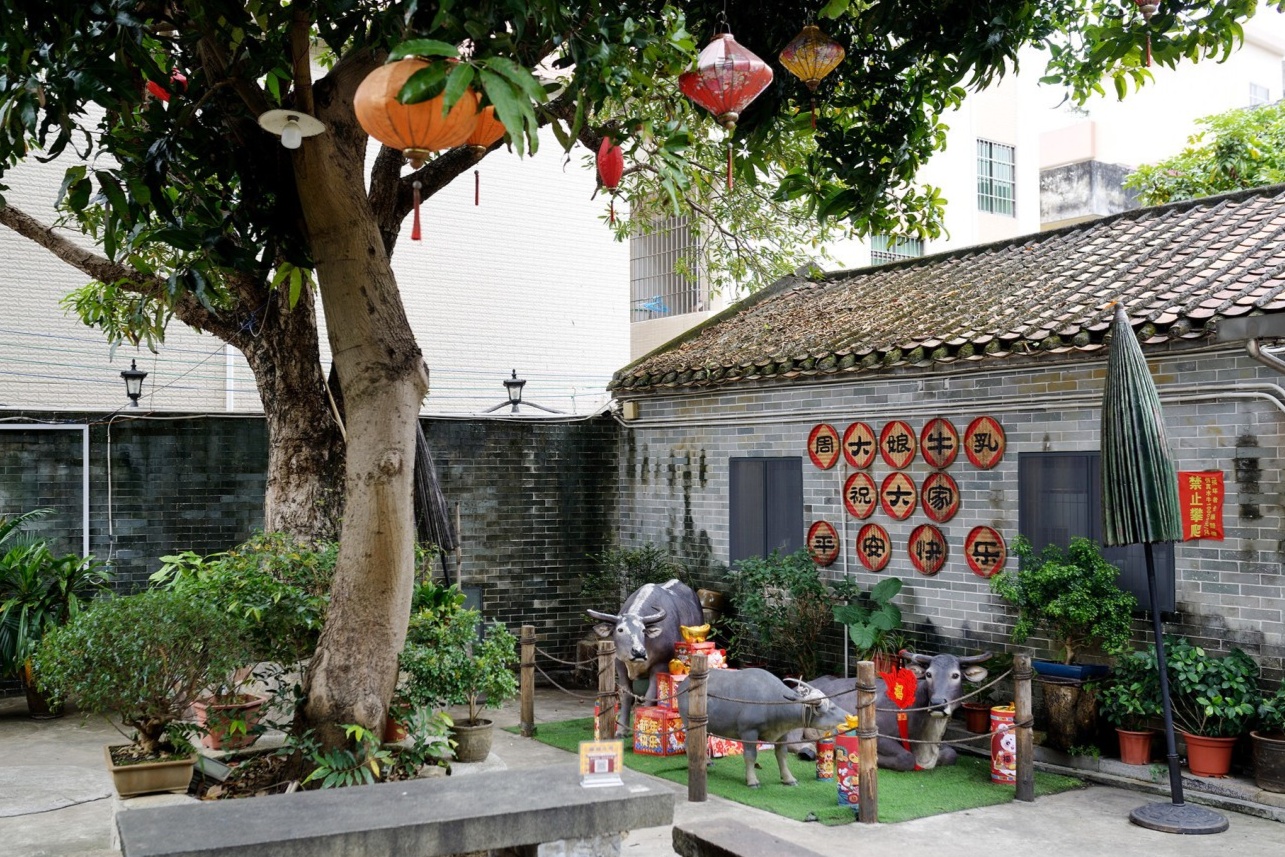
A Trio of Signature Delights
While their Double-Skin Milk is excellent, Granny Zhou’s boasts other unique star items that are absolute must-tries.

Phoenix Milk (凤凰奶)
A signature dish you can’t miss. This dessert, made from egg and milk, is a thick, luscious custard where the fragrance of egg and the richness of milk merge into one perfect whole (`蛋香和奶香浑然一体`). It’s absolutely delicious.
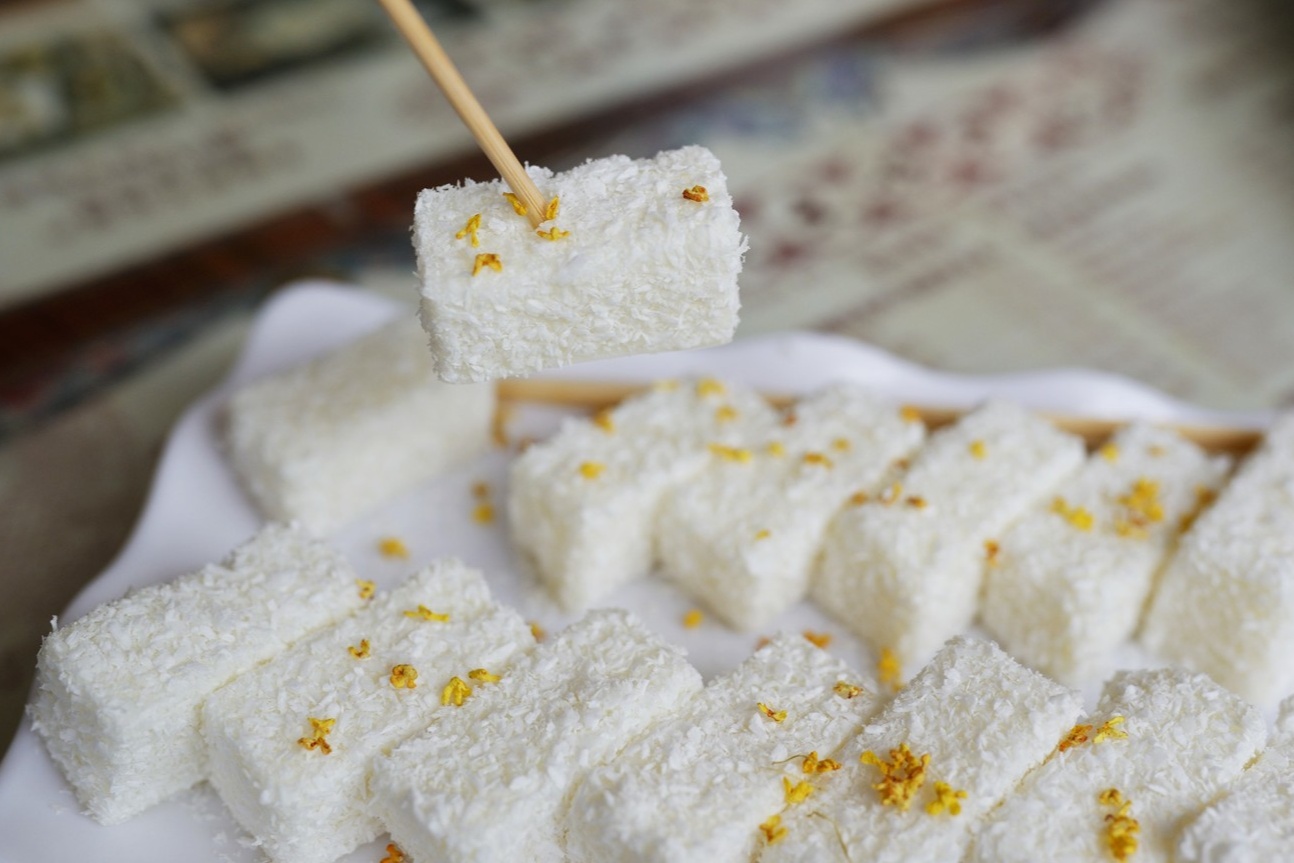
Osmanthus Coconut Milk Jelly (桂花椰蓉牛奶冻)
A star item on the menu. This milk jelly is elevated with the addition of fragrant osmanthus flowers and shredded coconut. The result is a wonderfully refreshing and sweet (`特别清甜`) treat that is well worth ordering.
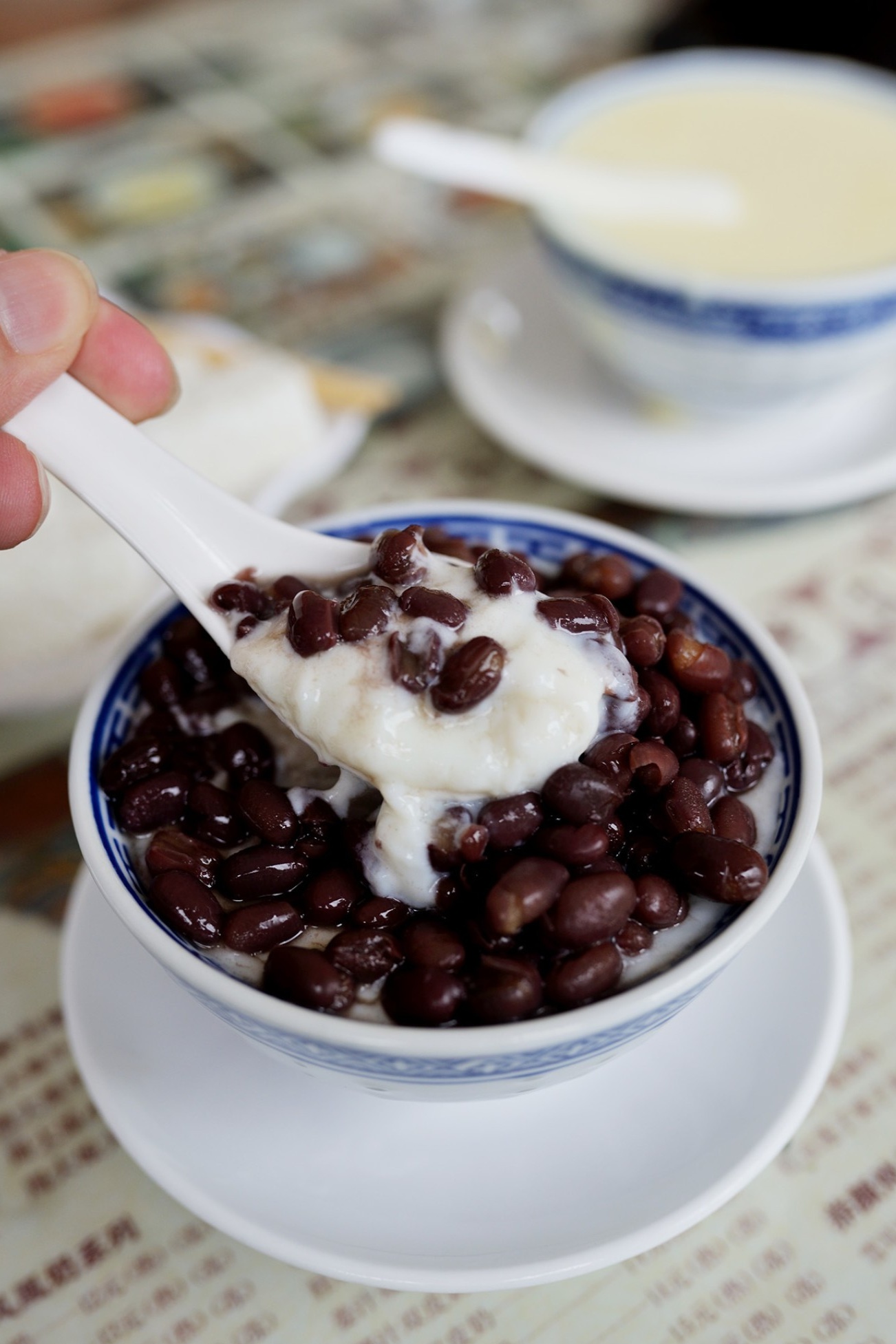
Red Bean Double-Skin Milk (红豆双皮奶)
Their version is noted for its exceptional milk quality, creating a texture that is both delicate and substantial (`口感细腻而厚实`). It’s slightly sweeter than some others, but pleasantly so, making for a very comforting dessert.
At a Glance
- Location: 顺德区旧寨村(近顺峰山公园)(Jiuzhai Village, near Shunfeng Mountain Park, Shunde)
- Avg. Cost: ¥20 per person
- Must-Try Dishes: Phoenix Milk (凤凰奶), Osmanthus Coconut Milk Jelly (桂花椰蓉牛奶冻), Red Bean Double-Skin Milk (红豆双皮奶).
- Pro Tip: Make a point to visit the main branch for its unique, tranquil courtyard setting. It elevates the entire dessert experience.
20. Jinbang Milk Store (金榜牛奶店)
Another pillar of Jinbang Street, offering a classic, bustling dessert experience and fantastic bottled fresh milk to go.
Founded in 1984, Jinbang Milk Store is a place of legend, known for its uncompromising quality and its gloriously “willful” (`任性`) attitude. Don’t let the name fool you; it’s not on the famous Jinbang Street. It’s a hidden gem with no decor to speak of, a tiny menu of only four items, and a cash-only policy. They open late in the afternoon (around 2-3 PM) and close the moment they sell out. This isn’t just a dessert; it’s a pilgrimage for those seeking double-skin milk pudding in its most elemental, unadulterated form.
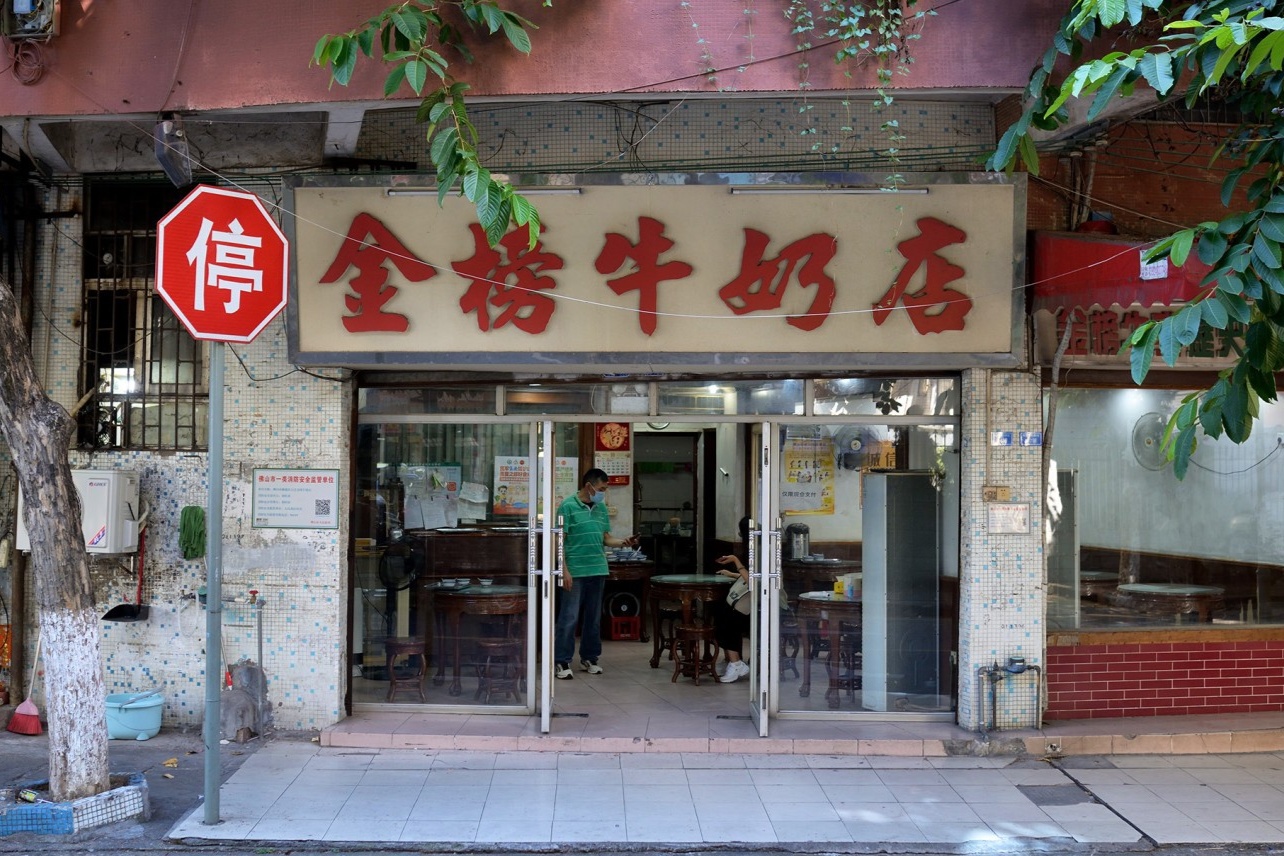
The Masterpiece: Double-Skin Milk Pudding (双皮奶)
This is what you come for. The double-skin milk pudding here is flawless. The top layer of milk skin is visibly wrinkled (`肉眼可见的奶皮褶皱`), a sign of a perfectly executed, high-fat buffalo milk base. Beneath this delicate, chewy skin lies a custard that is impossibly smooth, silky, and wobbly. The flavor is intensely milky, rich but not cloying, with a sweetness that complements rather than overpowers the star ingredient.
The cold version is the ultimate prize, but timing is everything. As the chatty owner will tell you, you can’t come too early (it hasn’t chilled yet) or too late (it’s already sold out). The hot version, however, is always a magnificent consolation, delivering a warm, comforting wave of pure milky goodness.
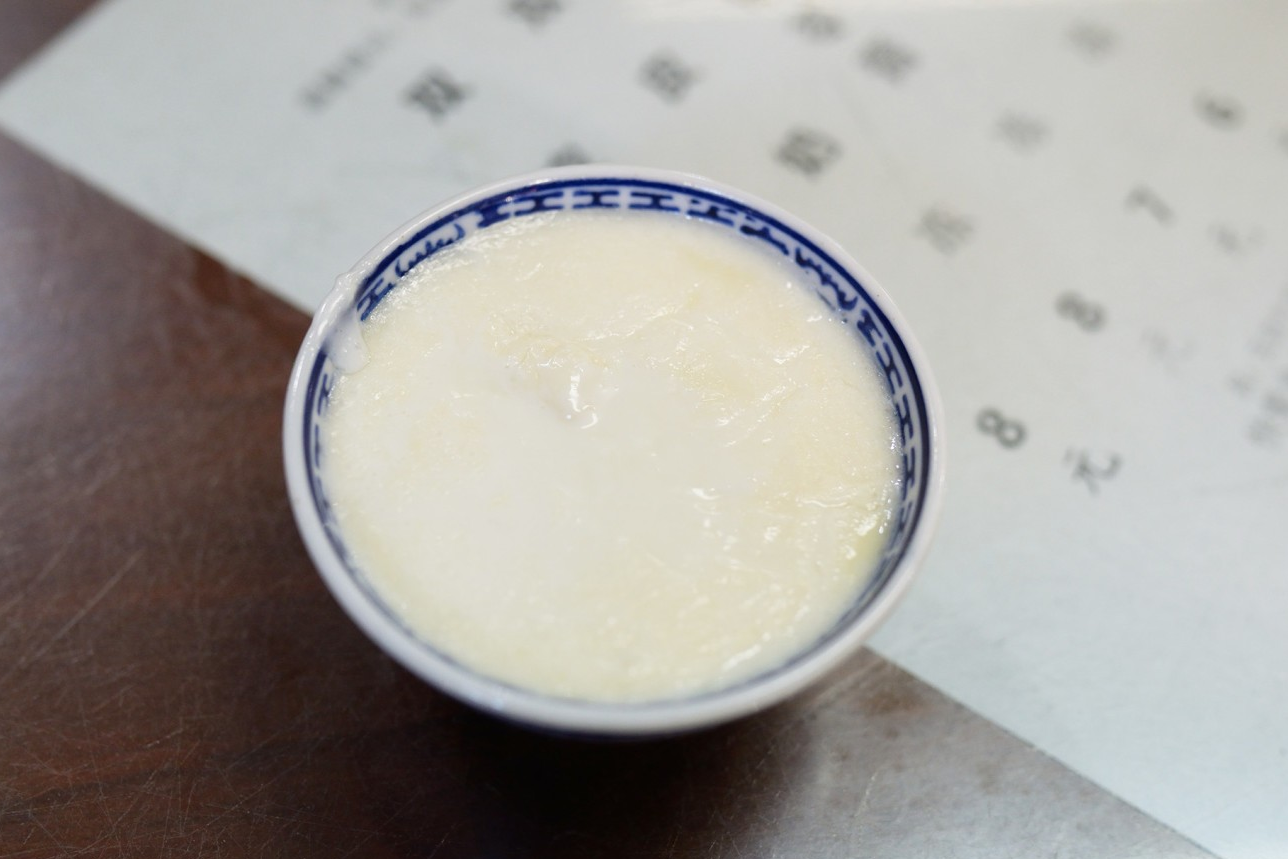
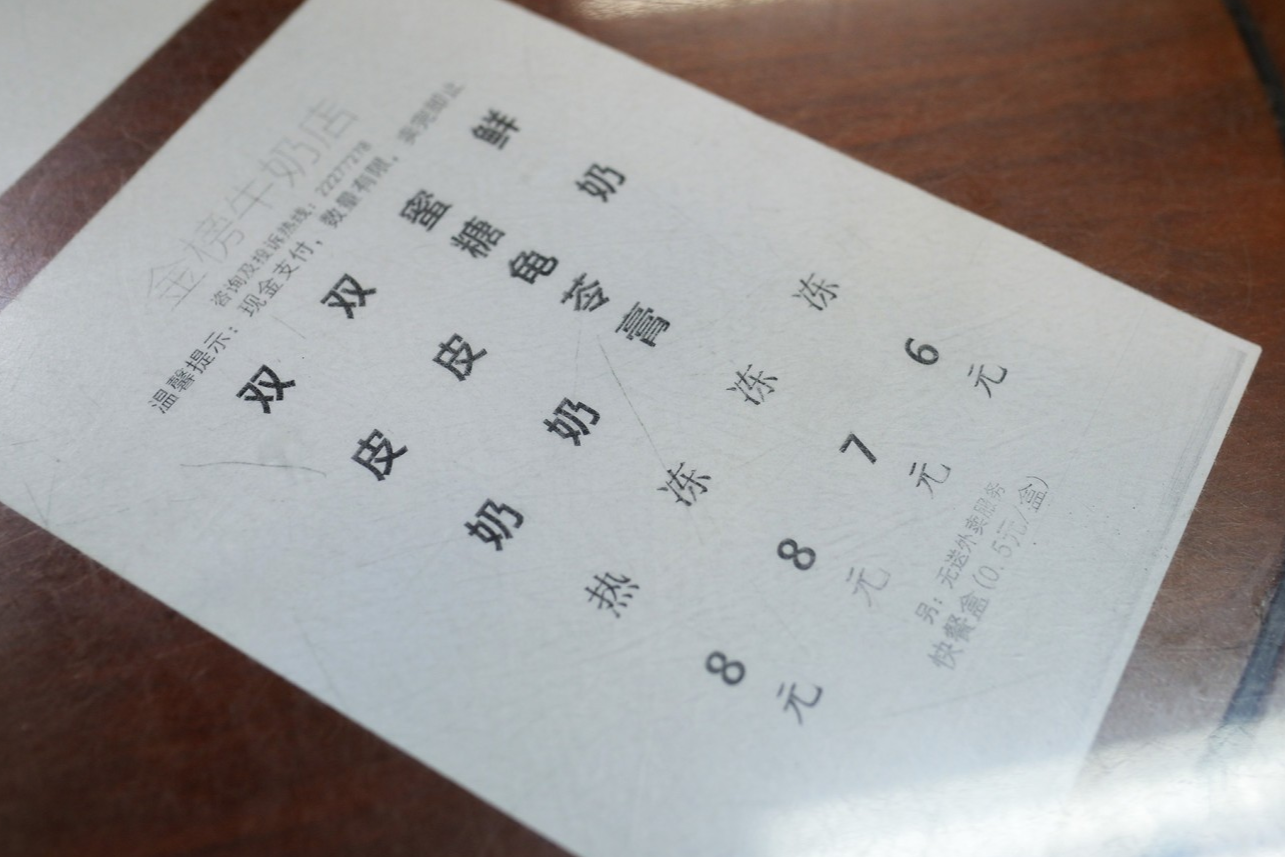
At a Glance
- Address: 顺德区大良甲子路锦绣新村18栋116铺 (Shop 116, Building 18, Jinxiu New Village, Jiazi Road, Daliang, Shunde)
- Avg. Cost: ¥8 per person
- Must-Try Dishes: Cold Double-Skin Milk (冻双皮奶), Hot Double-Skin Milk (热双皮奶).
- Note: Cash only. Opening hours are unpredictable.
21. Jinyuan Dessert Shop (金源甜品店)
A local favorite for traditional sweet soups that go beyond the milk-based classics.
Just a stone’s throw from the famous milk shops on Jinbang Street, Jinyuan feels like a dessert parlor straight out of old Shunde, a true institution for the locals. Having operated for nearly 30 years, its charm lies in its unpretentious atmosphere and budget-friendly prices (`环境和价位都很亲民`). It’s a beloved spot where neighborhood residents and students gather for a comforting bowl of high-quality, affordable Cantonese dessert (`物美价廉的广式甜品`).
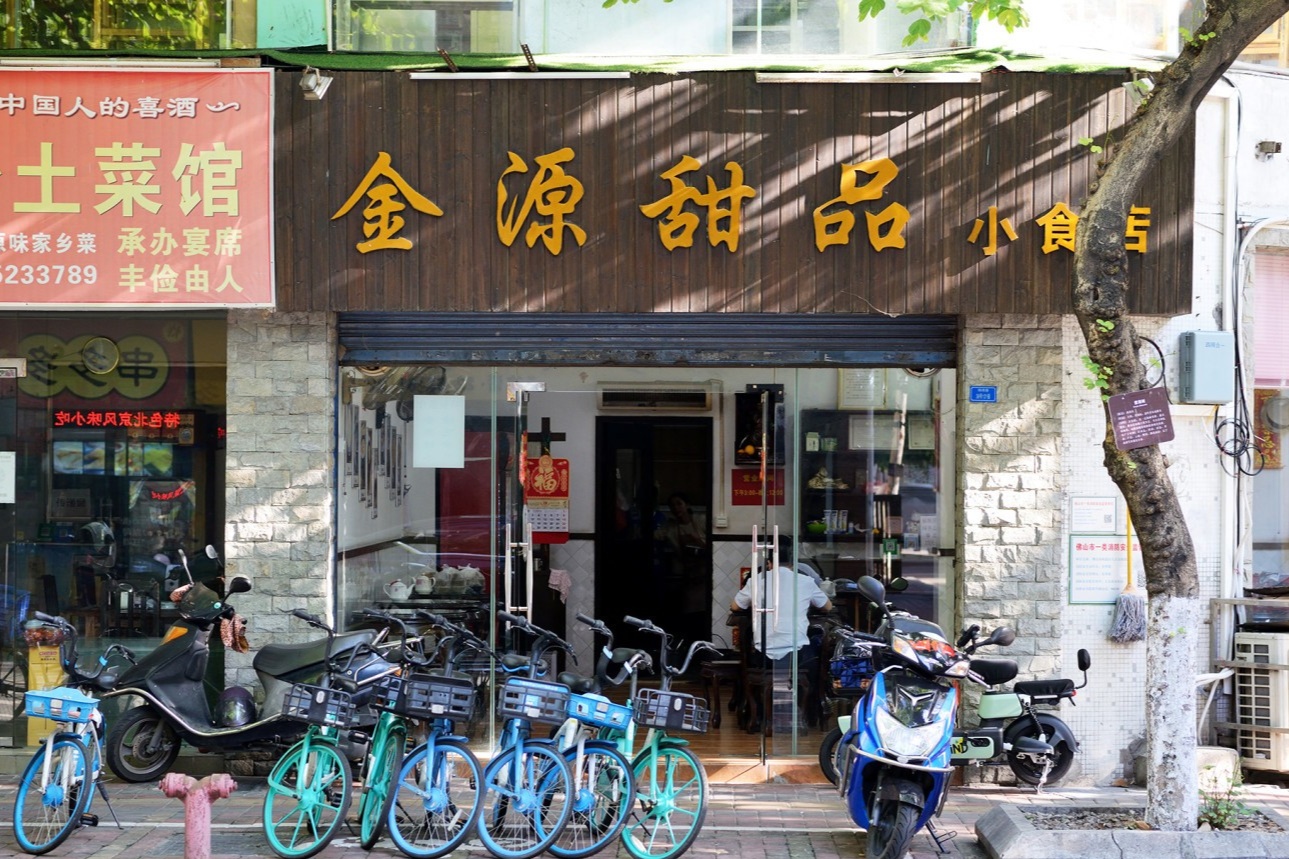
The Signature Swirl: An Edible Ink Wash Painting
While the shop offers a wide variety of desserts, including a well-regarded Double-Skin Milk, its undisputed champion is the Sesame and Almond Paste Swirl.
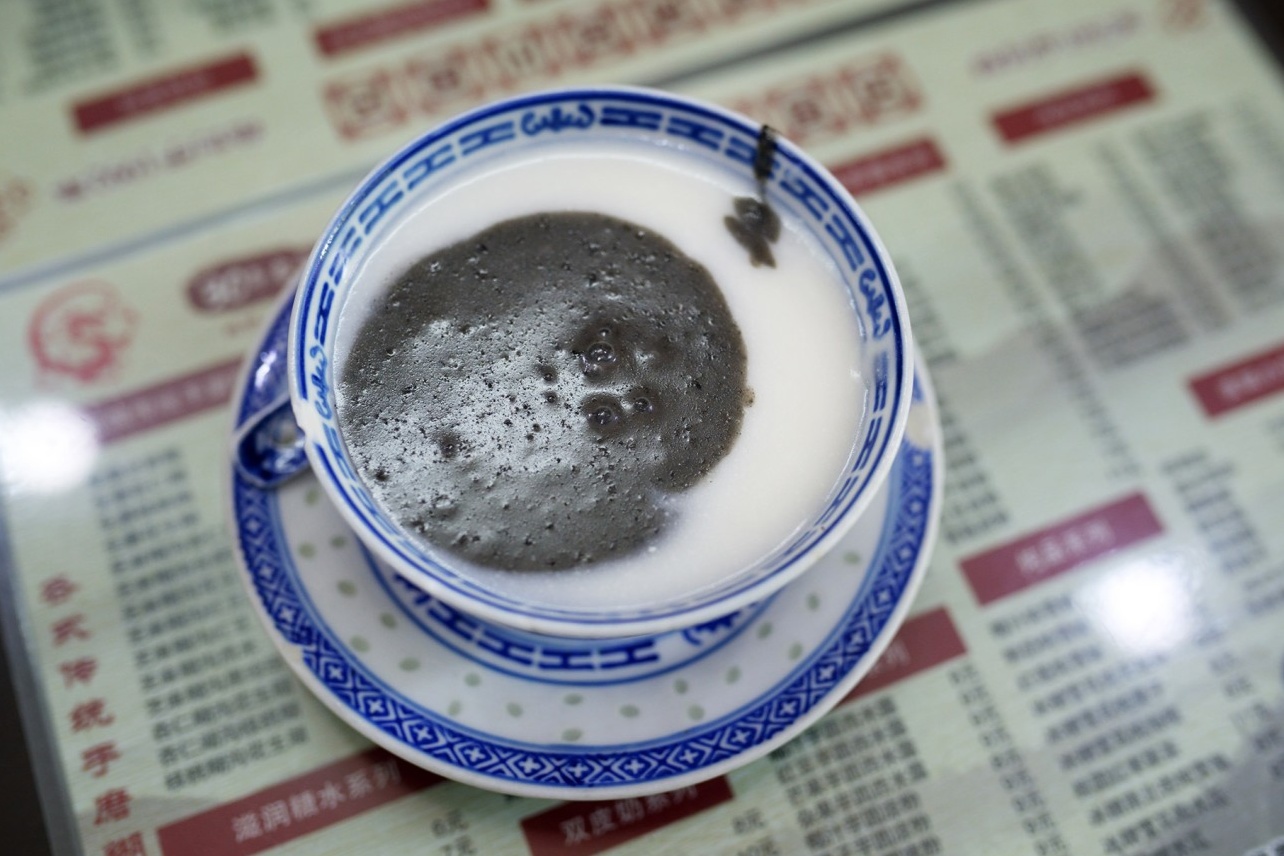
The Perfect Pairing
The shop’s most famous creation is a bowl combining rich, black sesame paste with fragrant, white almond paste (`芝麻糊沟杏仁糊`). Served unmixed, it presents a beautiful contrast, ready to be transformed by your spoon.
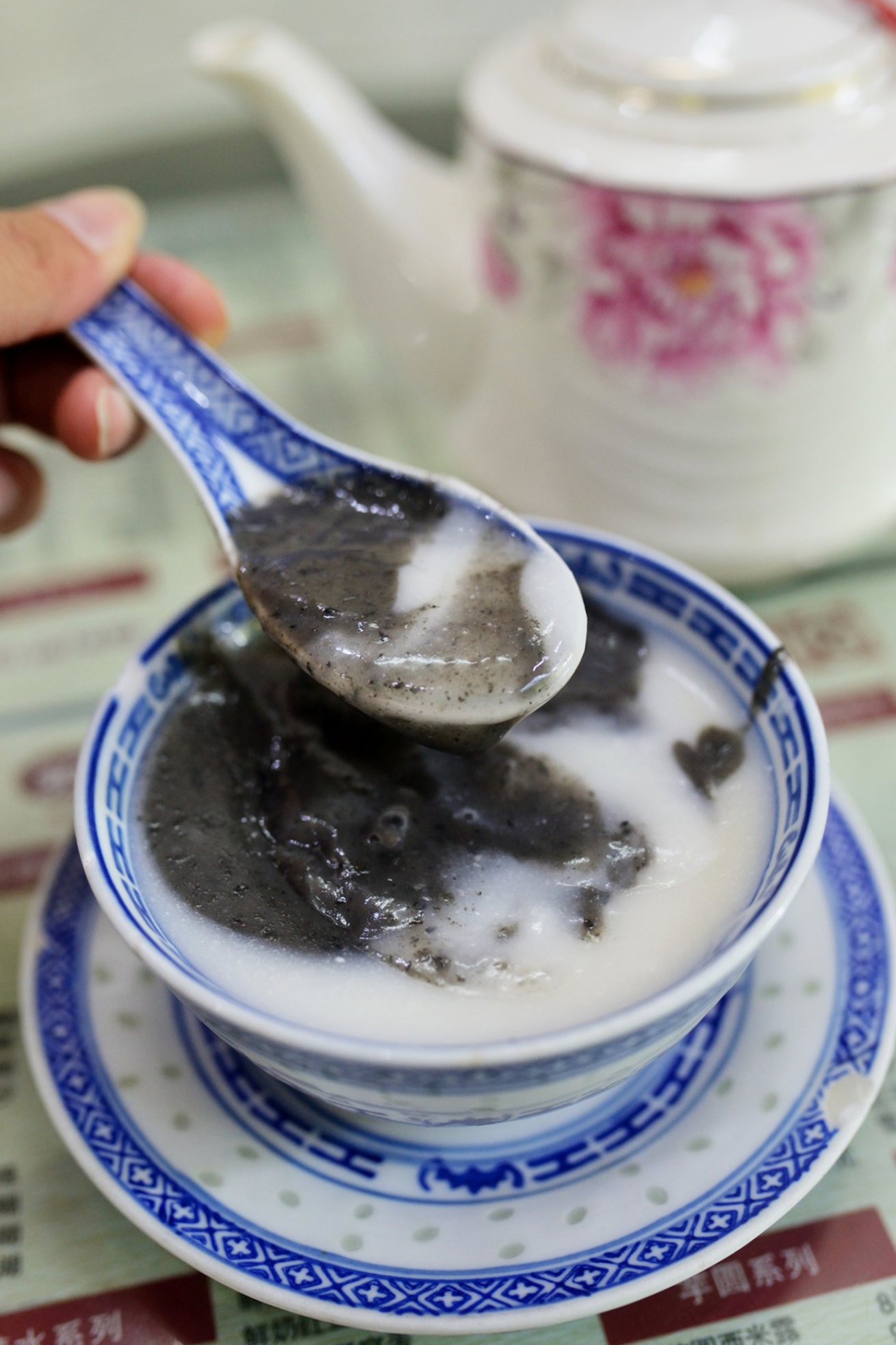
A Taste of Gentle Bliss
As you stir them together, the pastes create a stunning pattern reminiscent of a traditional ink wash painting. The taste is divine: incredibly smooth, perfectly balanced in sweetness, and with a captivating aroma from the blend of sesame and almond that, as the locals say, “plunges your taste buds into a gentle embrace” (`让舌尖瞬间坠入温柔乡`).
At a Glance
- Location: 顺德区大良锦绣路62号 (No. 62, Jinxiu Road, Daliang, Shunde)
- Avg. Cost: ¥8 per person
- Must-Try Dish: Sesame & Almond Paste Swirl (芝麻糊沟杏仁糊).
- Pro Tip: While the milk shops across the street get the tourist hype, this is where you experience an authentic local dessert house at an unbeatable price.
22. Yin Ji Private Desserts (银记私房甜品)
A hidden gem offering creative, homemade-style desserts with a modern touch.
If you ask a local in the Ronggui district where to find the absolute best desserts, nine times out of ten, they’ll point you to Yin Ji. Tucked away in a small alley, this hidden gem operates out of a self-built house with an open kitchen, giving it a charming, family-workshop (`家庭作坊`) feel. Their ultimate trump card is the quality of their ingredients: the milk is supplied exclusively from their very own dairy farm, guaranteeing unparalleled freshness and flavor.

The Signature: Milk Egg Custard (牛奶炖蛋)
Interestingly, Yin Ji doesn’t serve the famous Double-Skin Milk. Instead, they offer their signature Milk Egg Custard, a dessert so similar in taste and texture that it’s a masterful equivalent, differing only by having a single, delicate skin. The flavor is rich and fragrant with milk and egg, yet it’s perfectly balanced and not cloyingly sweet (`浓郁又不会齁甜`). This is a local favorite and often sells out, so be sure to arrive early to avoid disappointment.
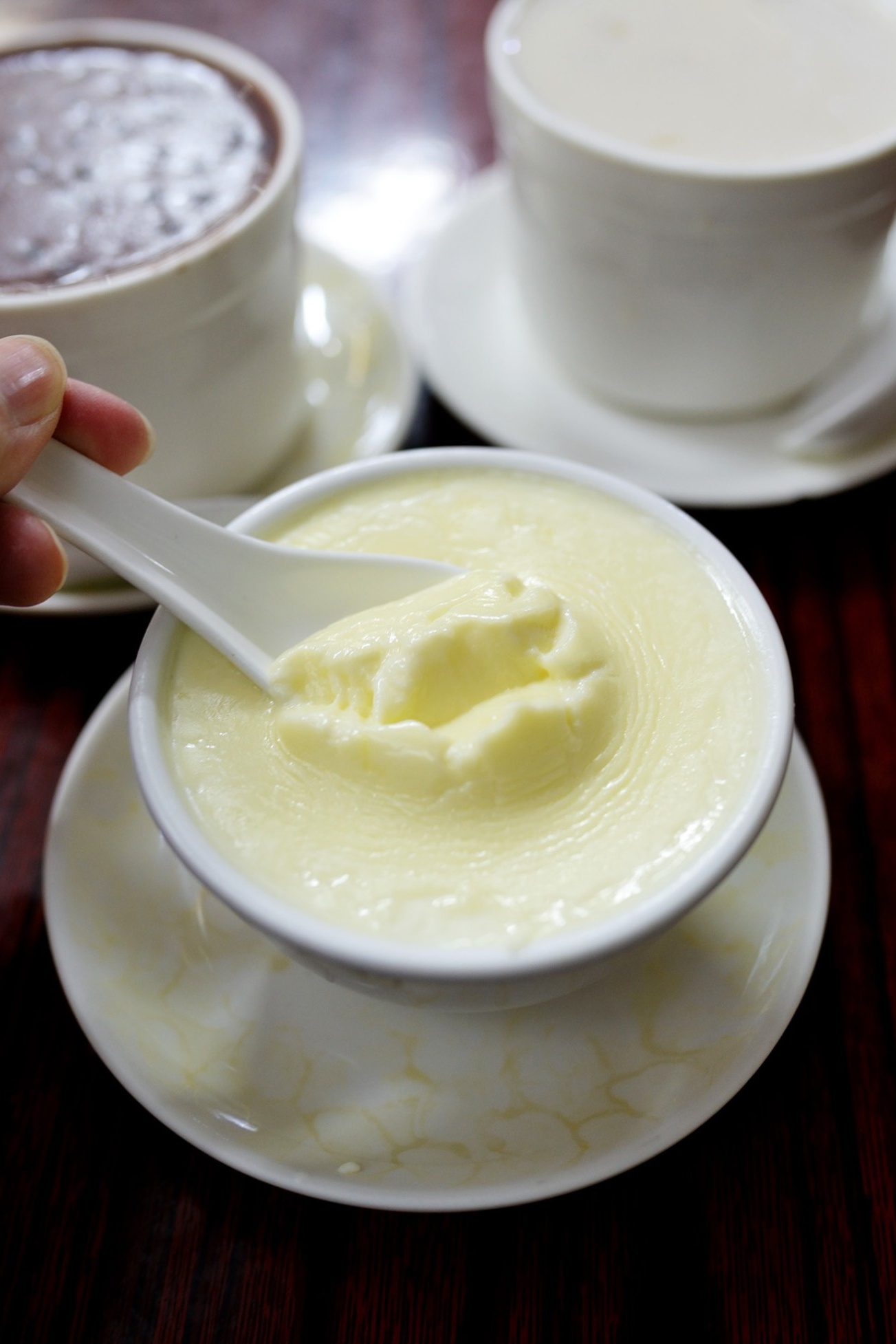
Other Must-Try Desserts
Yin Ji’s menu features other delightful creations. The Fresh Milk & Coconut with Peach Gum (鲜奶椰汁桃胶) is a fragrant blend where coconut milk elevates the fresh milk’s aroma. The peach gum is stewed until perfectly soft and glutinous (`软糯`), creating a dessert that is both thick and refreshingly light. Another excellent choice is the Red Bean, Coconut & Sago in Milk (红豆椰汁牛奶西米露). It features soft, fine red beans and large, chewy sago pearls in a smooth, perfectly sweetened milk base that is incredibly satisfying without being heavy.
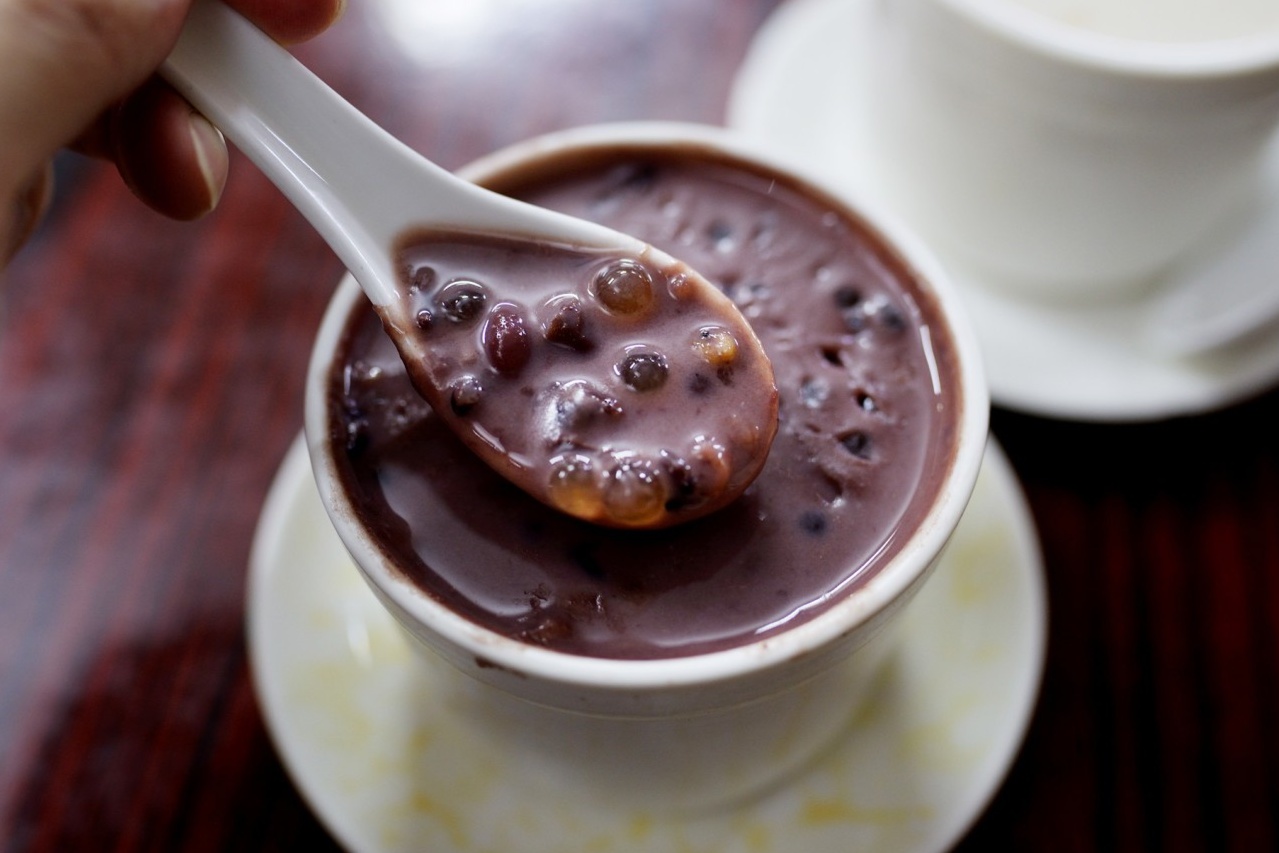
At a Glance
- Location: 顺德区容桂乐莘路33号 (33 Le Xin Road, Ronggui, Shunde)
- Avg. Cost: ¥20 per person
- Must-Try Dishes: Milk Egg Custard (牛奶炖蛋), Fresh Milk & Coconut with Peach Gum (鲜奶椰汁桃胶), Red Bean Coconut Milk Sago (红豆椰汁牛奶西米露).
- Pro Tip: This is a true local haunt. Don’t be deterred by the hidden location. Go early for the best selection, especially if you want to try the Milk Egg Custard.
Part III: A Journey Through History
顺德 | 访古
Exploring the Heritage Trail
Beyond its incredible food, Shunde is steeped in history. Its past as a prosperous center of trade and scholarship has left behind a legacy of stunning architecture and tranquil gardens. Taking time to explore these cultural sights provides a perfect balance to the culinary adventure.
🏮 Want to go deeper into history?
Shunde is more than just food. If you are fascinated by the architecture of Qinghui Garden or the water towns, read our dedicated deep dive: Explore Shunde: Beyond the Cuisine in the Land of Cantonese Chefs.
Qinghui Garden (清晖园)
One of the Four Great Gardens of Guangdong, Qinghui Garden is the most significant historical landmark in Shunde. It is a breathtaking masterpiece of Lingnan garden artistry, a tranquil world where architecture, water, and nature dance in perfect harmony.
In a journey dedicated to the art of the palate, Qinghui Garden offers a necessary and sublime counterpoint: a feast for the soul. This is not merely a stop on a map; it is the cultural heart of Shunde. Acknowledged as the undisputed head of the “Four Great Gardens of Lingnan” (`岭南四大园林之首`), Qinghui Garden is a living, breathing museum of classical Chinese landscape architecture. Its location in the bustling center of Daliang makes it an accessible sanctuary, a place where the noise of the city fades away, replaced by the whisper of bamboo leaves and the gentle murmur of water. To truly know Shunde, one must walk its winding paths and understand the stories etched into its very walls.
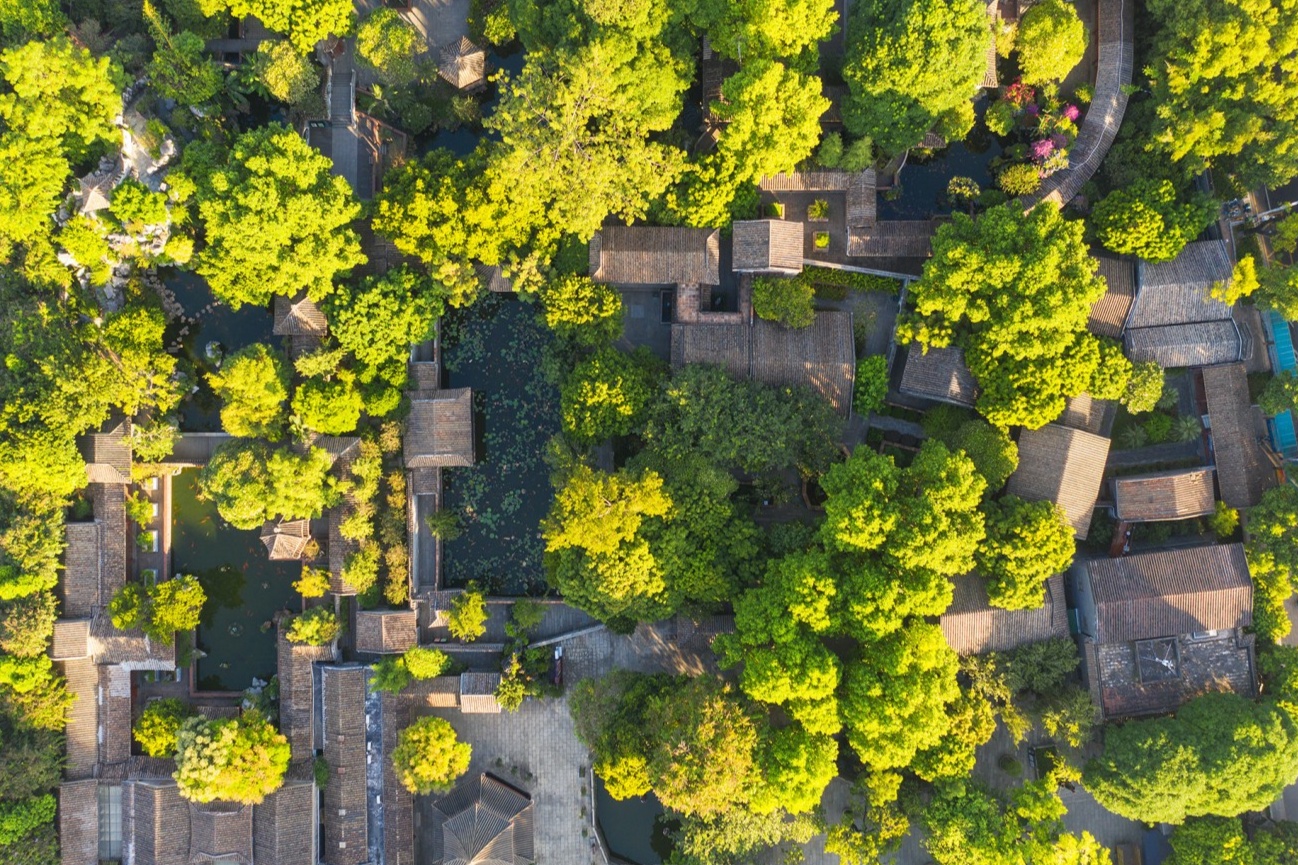
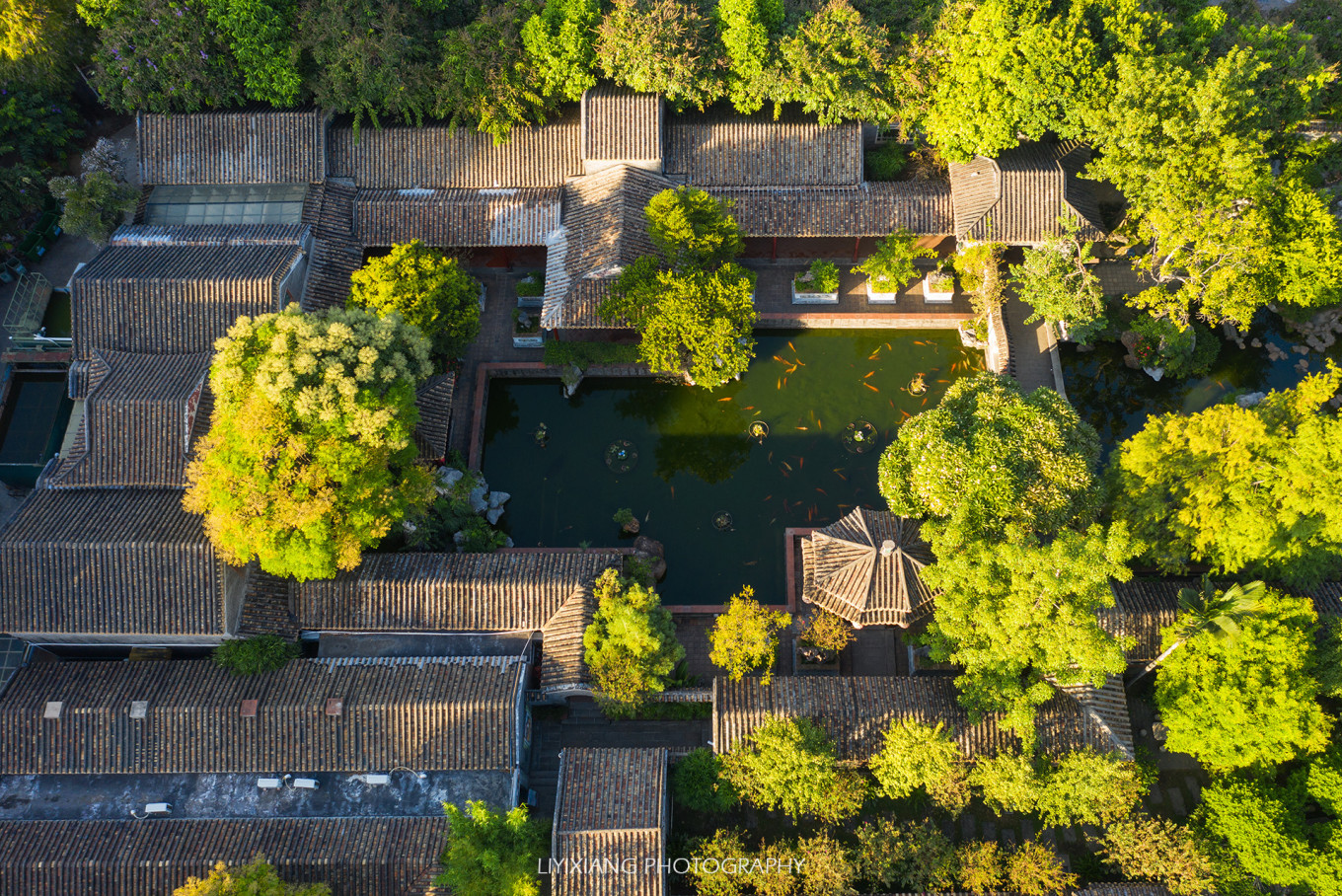
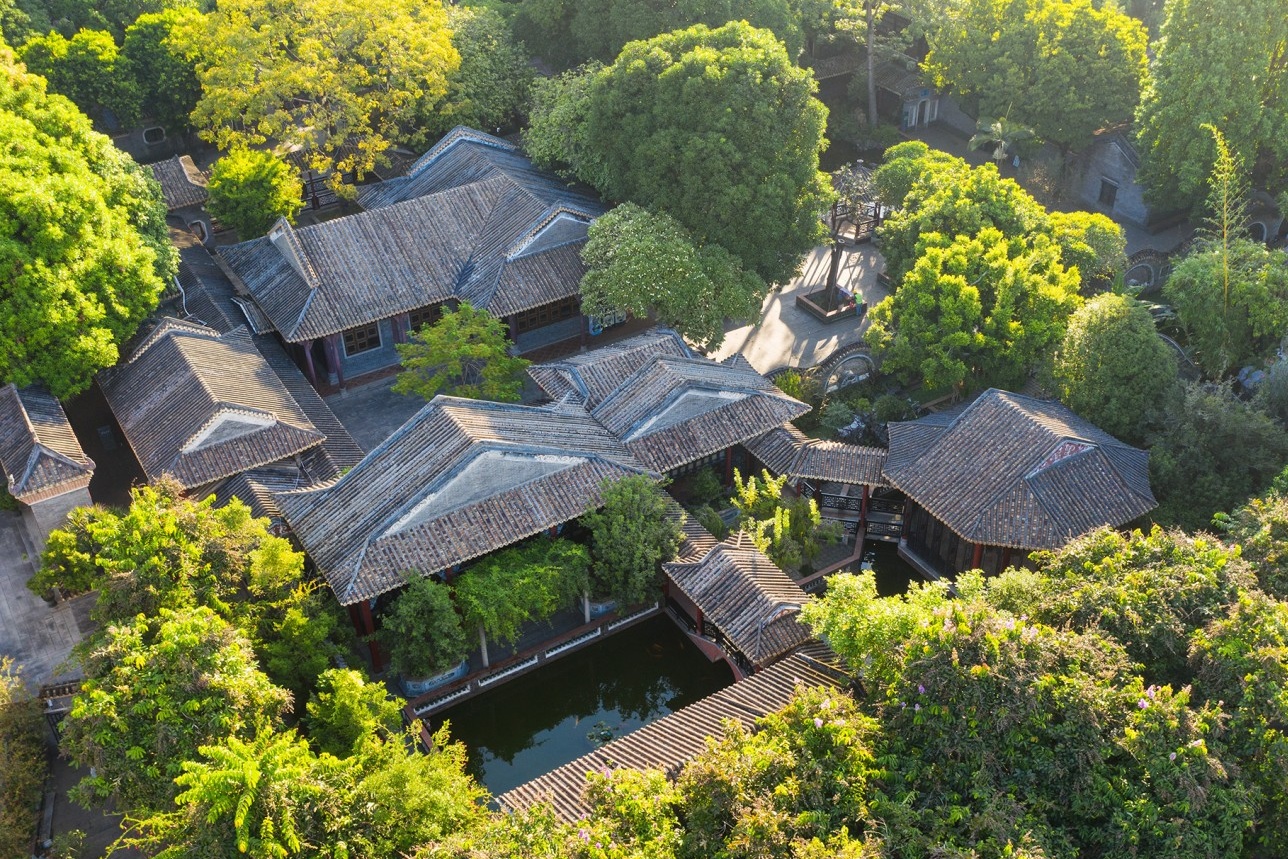
A Garden’s Epic: Three Centuries of Transformation
The story of Qinghui Garden is a compelling drama of rise, fall, and magnificent rebirth, spanning over three centuries.
The Ming Dynasty Origins: The garden’s tale begins in the late Ming Dynasty as the private estate of Huang Shijun, a brilliant scholar who achieved the title of `Zhuangyuan` (状元) – the highest possible honor in the formidable imperial examinations. It was a residence befitting his status, but as fortunes are wont to do, the Huang family’s influence waned over time, and their once-glorious garden slowly succumbed to neglect, becoming a forgotten, overgrown ruin.
The Qing Dynasty Renaissance: Its second act began during the prosperous Qianlong era of the Qing Dynasty. The abandoned land was acquired by Long Yingshi, another accomplished scholar. He and his descendants, over several generations, embarked on an ambitious project of revival and creation. They didn’t just restore the garden; they reimagined it, meticulously crafting the exquisite landscape we see today. It was they who gave it the name “Qinghui” (`清晖`), a name steeped in poetic meaning. It is drawn from the classic poem “Song of the Parting Son” by Meng Jiao, which contains the line: “Who says that the heart of a tiny blade of grass can repay the radiance of three spring months?” (`谁言寸草心,报得三春晖`). “Qinghui,” meaning “pure, gentle radiance,” thus became a profound symbol of filial piety—a child’s eternal gratitude for a parent’s love, as warm and nurturing as the spring sun. The garden itself is a tribute carved in wood, stone, and water.
Modern Preservation: The garden faced its own mortality once more during the turbulent years of the war, as the Long family sought refuge overseas, leaving their beloved creation to face the elements alone. After 1949, recognizing its immense cultural value, the new government undertook the crucial task of a full-scale restoration, saving this national treasure from ruin and opening its gates for the public to cherish.
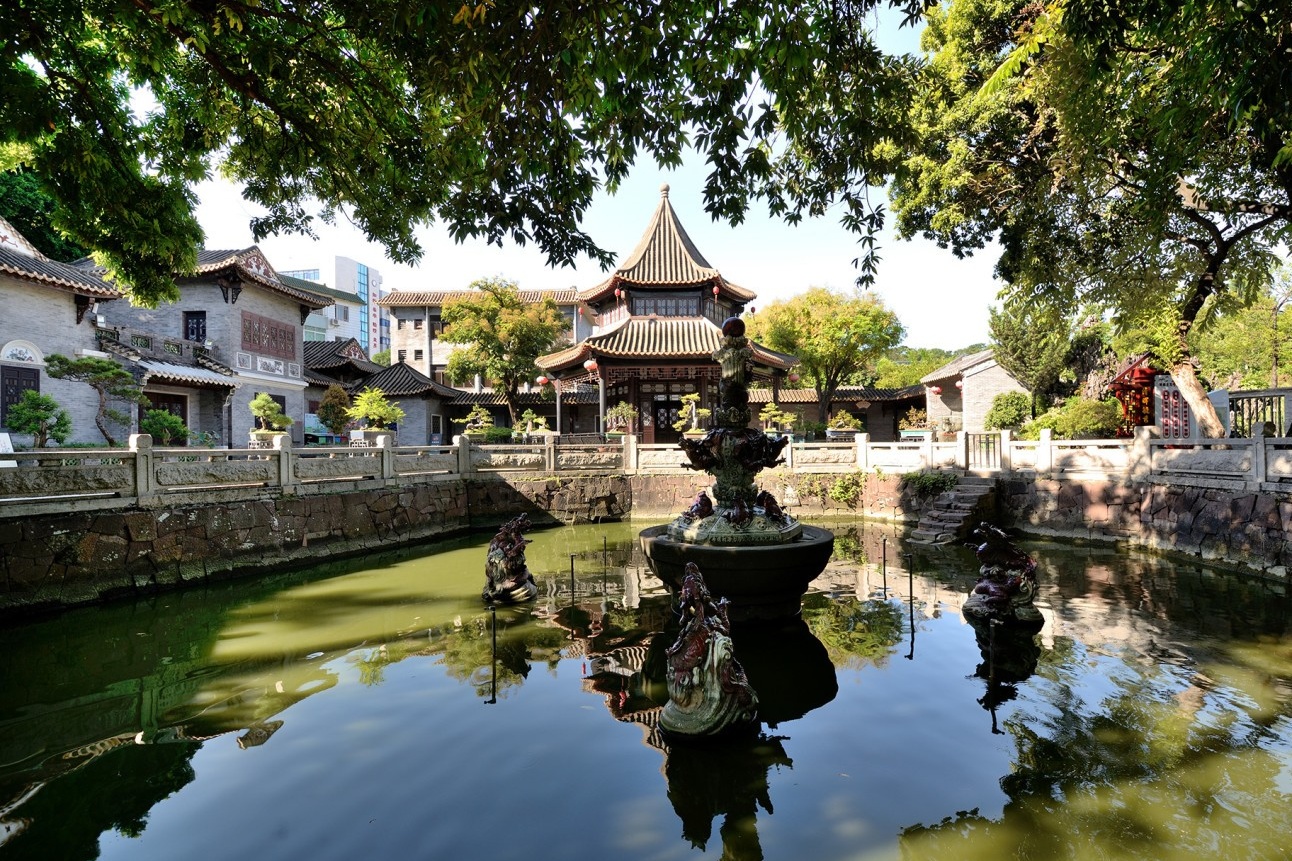
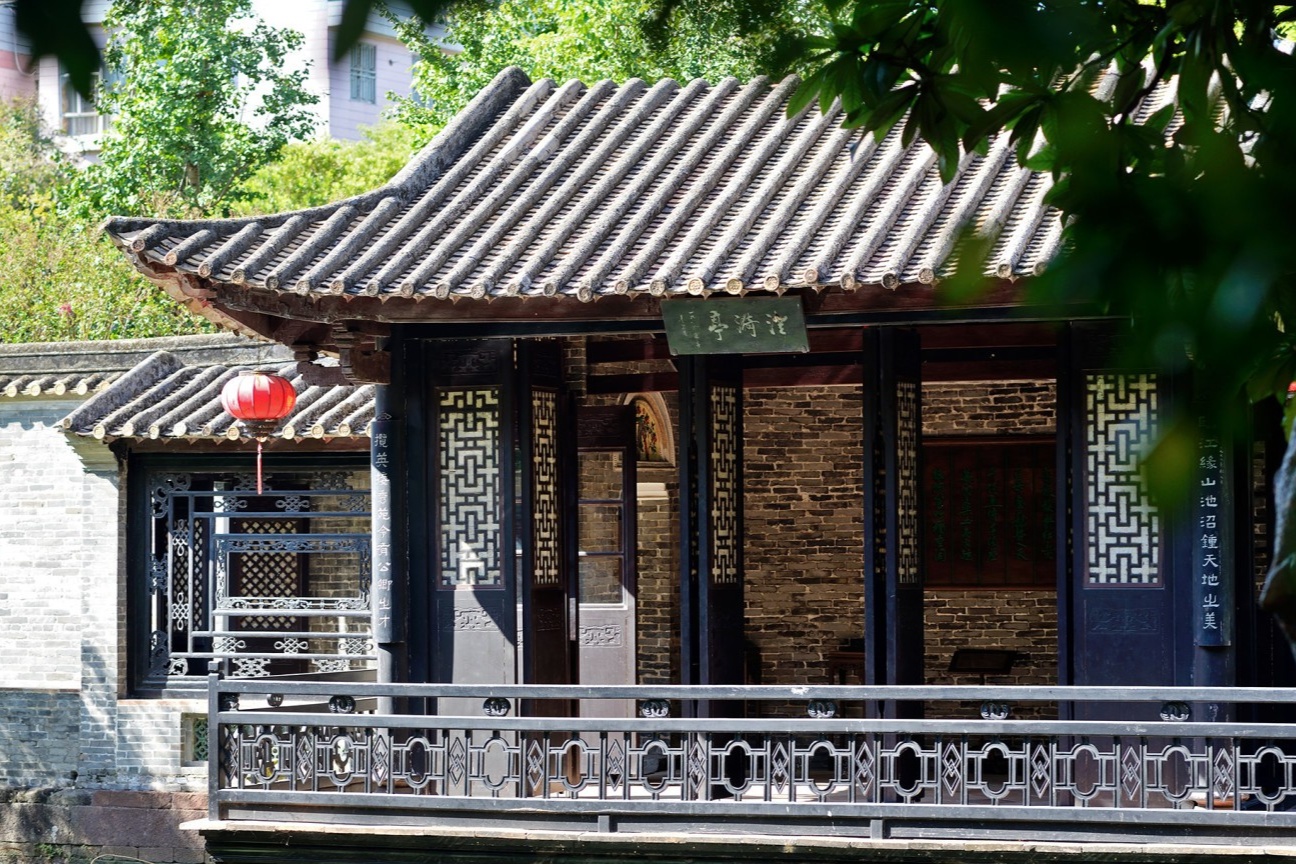
The Art of Lingnan Design: A Masterclass in Detail
Qinghui Garden is the quintessential textbook of Lingnan garden design, characterized by its intimate scale, intricate details, and ingenious adaptation to the subtropical climate. The design philosophy is about creating a universe in a nutshell.
Water as the Soul: Water is the lifeblood of the garden. Ponds, streams, and waterfalls are woven throughout the landscape. They serve not only to cool the humid summer air but also as a canvas. The still water of the main pond acts as a “sky-well,” reflecting the elegant pavilions, the azure sky, and the passing clouds, effectively doubling the scenery and creating a breathtaking illusion of space. The vibrant orange and gold koi fish that glide through the water add a dynamic splash of color and life.
A Symphony of Materials: The craftsmanship is astounding. Look closely at the building facades and you’ll find exquisite carvings in wood, brick, and stone, depicting folklore, historical scenes, and auspicious symbols. A signature feature is the extensive use of colored glass, particularly the iconic blue `manchuang` (满窗) windows. These panels don’t just let in light; they filter it, bathing the interiors in a cool, ethereal glow and painting the floors with shifting patterns of color throughout the day.
Architecture as Scenery: The pavilions, halls, and covered walkways (`廊`) are not just buildings; they are strategically placed viewing platforms. Each structure is designed to offer a unique, perfectly composed view of another part of the garden. Winding corridors lead you on a journey of discovery, where every turn reveals a new vista, a “living painting” meticulously framed by an ornate window or a circular moon gate. This technique, known as “borrowed scenery” (`借景`), makes the compact garden feel boundless and full of surprises.
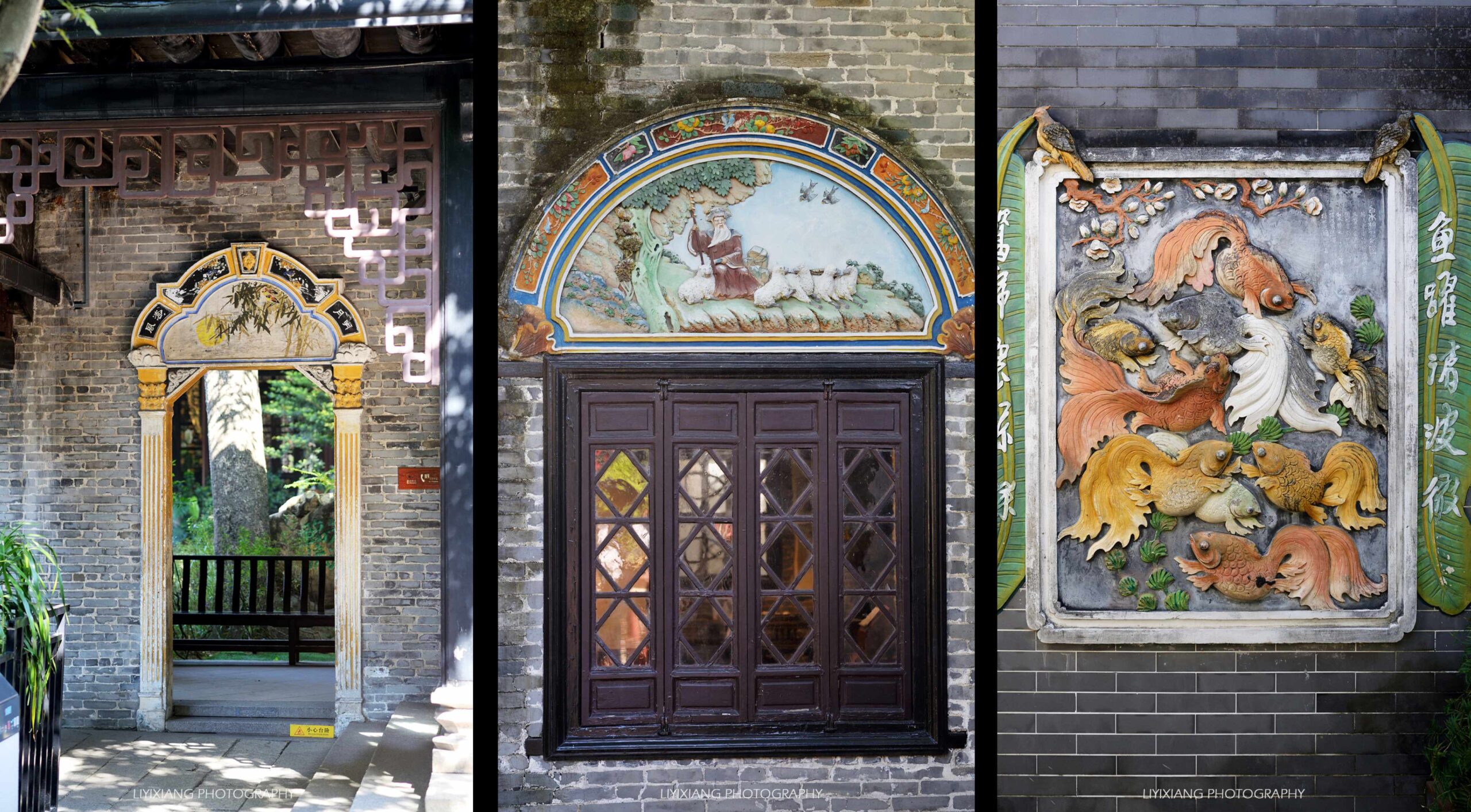
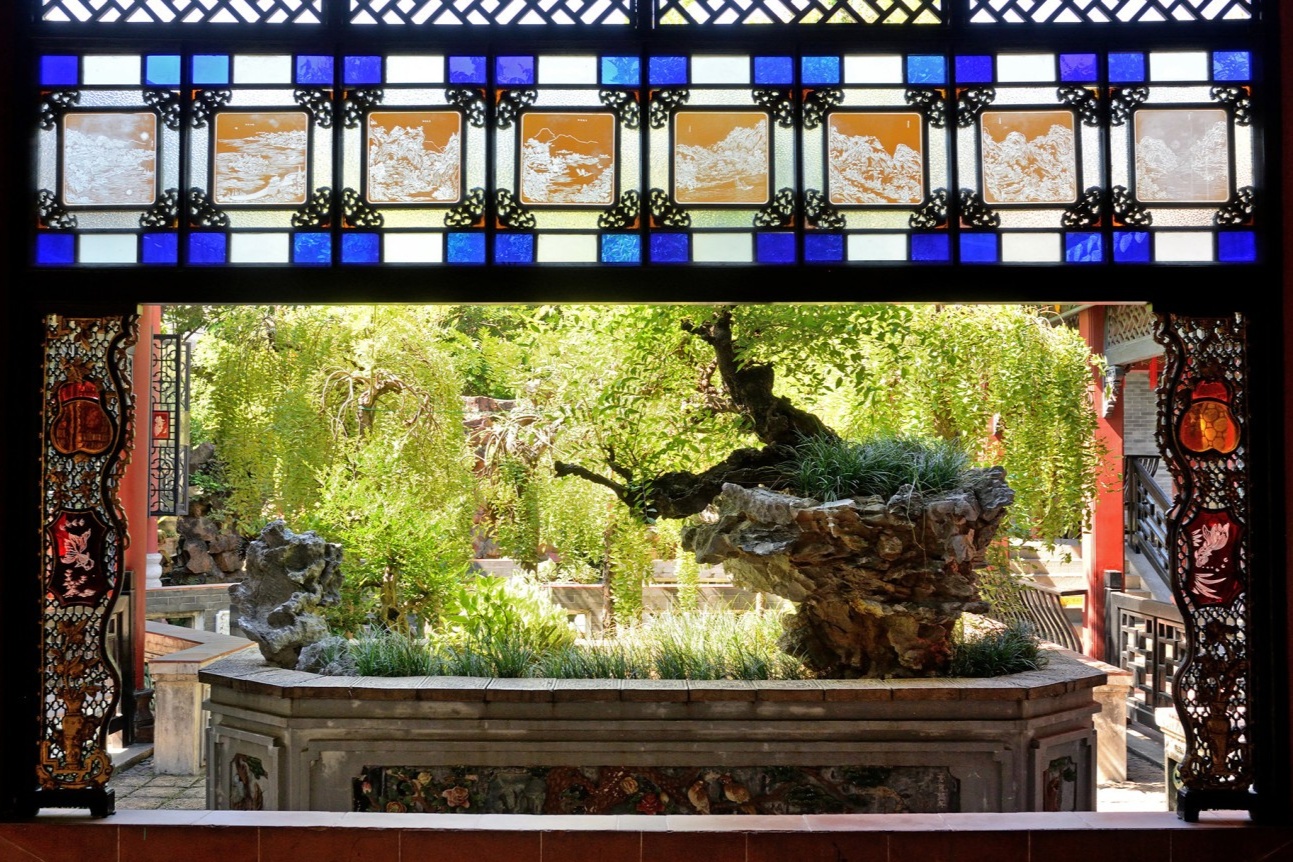
At a Glance
- Address: 顺德区大良清晖路23号 (No. 23, Qinghui Road, Daliang, Shunde)
- Ticket Price: ¥15. During holidays and peak seasons, it is strongly advised to book tickets online in advance via the official WeChat account to avoid disappointment.
- Guided Tours: An invaluable way to appreciate the garden’s nuances. Free guided tours are offered six times a day, each lasting about 30 minutes. They start at 9:30 AM and run on the half-hour (10:30, 11:30, 13:30, 14:30, 15:30). The 12:30 PM slot is excluded.
- Recommended Time: To truly absorb the atmosphere and explore its hidden corners, allocate a minimum of 2-3 hours for your visit. Rushing through Qinghui Garden is to miss its very essence.
Xishan Temple (西山庙)
A vibrant and living treasury of Lingnan architectural art, this temple is a must-see for its magnificent and fantastically detailed roof ridge sculptures—truly a masterclass in the form.
While Qinghui Garden represents the pinnacle of scholarly elegance, Xishan Temple stands as a powerful testament to Shunde’s vibrant folk culture and religious devotion. Though perhaps less famous than its garden neighbor, this temple is an essential visit for anyone wishing to understand the soul of the city. Officially named the Guan Di Temple (`关帝庙`), it is popularly known as Xishan Temple because it rests at the foot of Fengshan Hill (`凤山`), also called Xishan (`西山`). More than just a place of worship, it is a living museum, a treasure trove (`宝库`) showcasing the “three great carvings” of Lingnan architecture: magnificent pottery sculptures (`陶塑`), intricate brick carvings (`砖雕`), and detailed plaster reliefs (`灰塑`).
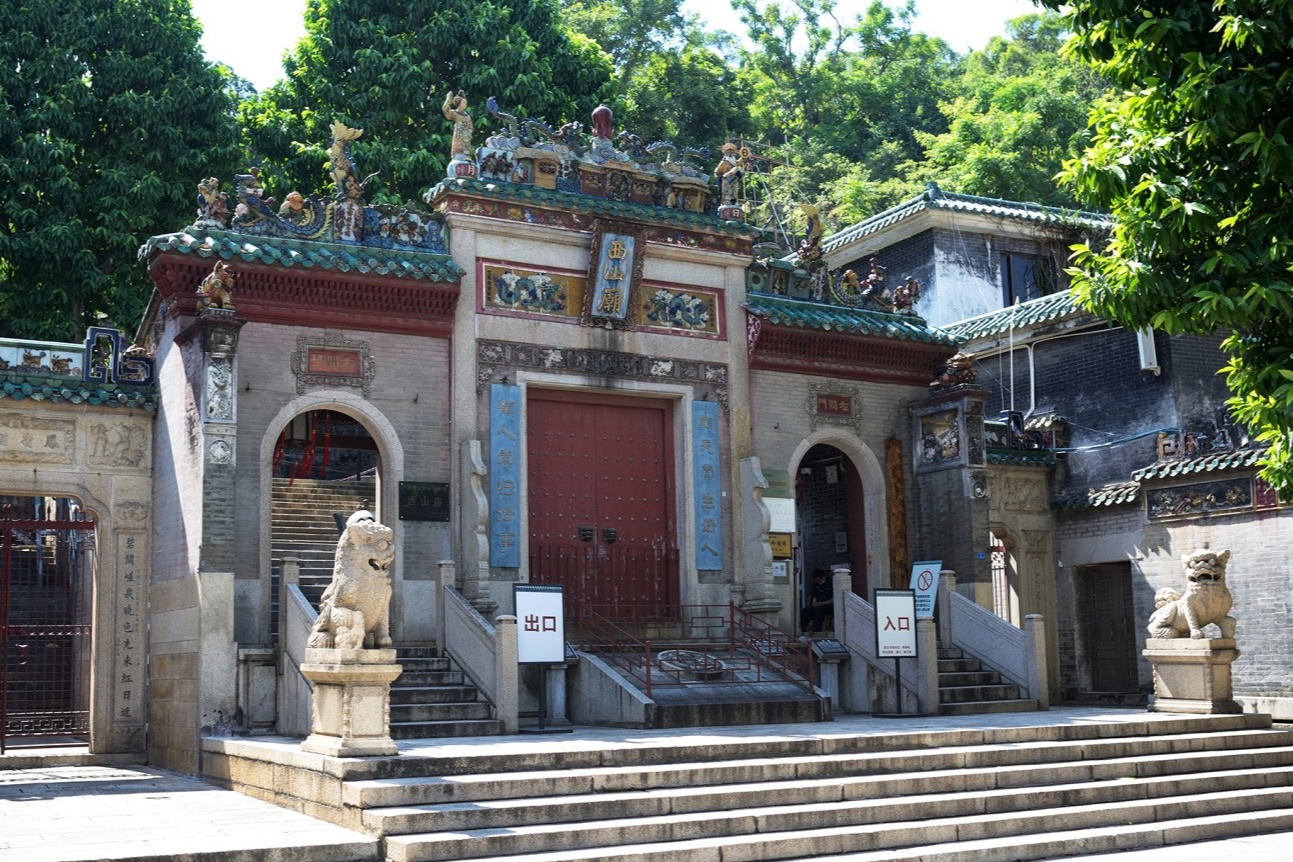
The Legend of the Unearthed Blade
The temple’s origin is rooted in a fascinating local legend dating back to the Ming Dynasty. The story goes that during the initial construction of Shunde’s county walls, workers unearthed a massive, ancient broadsword right at Xishan. A Feng Shui master was summoned, who declared that the blade’s presence was inauspicious for the western part of the city (`不利于西`). He advised against building a city gate on that spot. Instead, he recommended constructing a temple dedicated to Guan Di (Guan Yu), the revered God of War, himself famous for wielding a mighty broadsword. The temple would serve to harness and pacify the blade’s powerful energy, transforming it into a protective force for the city.
And so, in the 20th year of the Jiajing Emperor’s reign (1541), the temple was built. The very sword that was dug from the earth was enshrined within, becoming a sacred relic and the temple’s raison d’être.
An Open-Air Museum of Lingnan Sculpture
Approaching Xishan Temple is an overwhelming visual experience. Your eyes are immediately drawn upwards to the roof, which is alive with a riot of color and form. This is the famous Shiwan ceramic ridge (`石湾陶塑瓦脊`), a hallmark of high-end Lingnan temples.
The main ridge is a breathtaking tableau depicting classic Chinese mythology: twin dragons chasing a celestial pearl (`双龙戏珠`), the Sun and Moon Gods (`日神月神`), auspicious Ao fish, and vivid scenes from the epic *Romance of the Three Kingdoms*. While many of these figures are exquisite modern reproductions from the renowned Shiwan Meitao Factory, their craftsmanship is so superb they are a spectacle in their own right. Flanking the central, gold-lacquered wooden plaque of “Xishan Temple,” you can find authentic late-Qing Dynasty ceramic reliefs of “Two Dragons Contesting a Pearl” (`二龙争珠`), precious survivors that connect us directly to the temple’s past. Below these, three panels of masterfully executed brick carvings further testify to the incredible level of artistry involved.
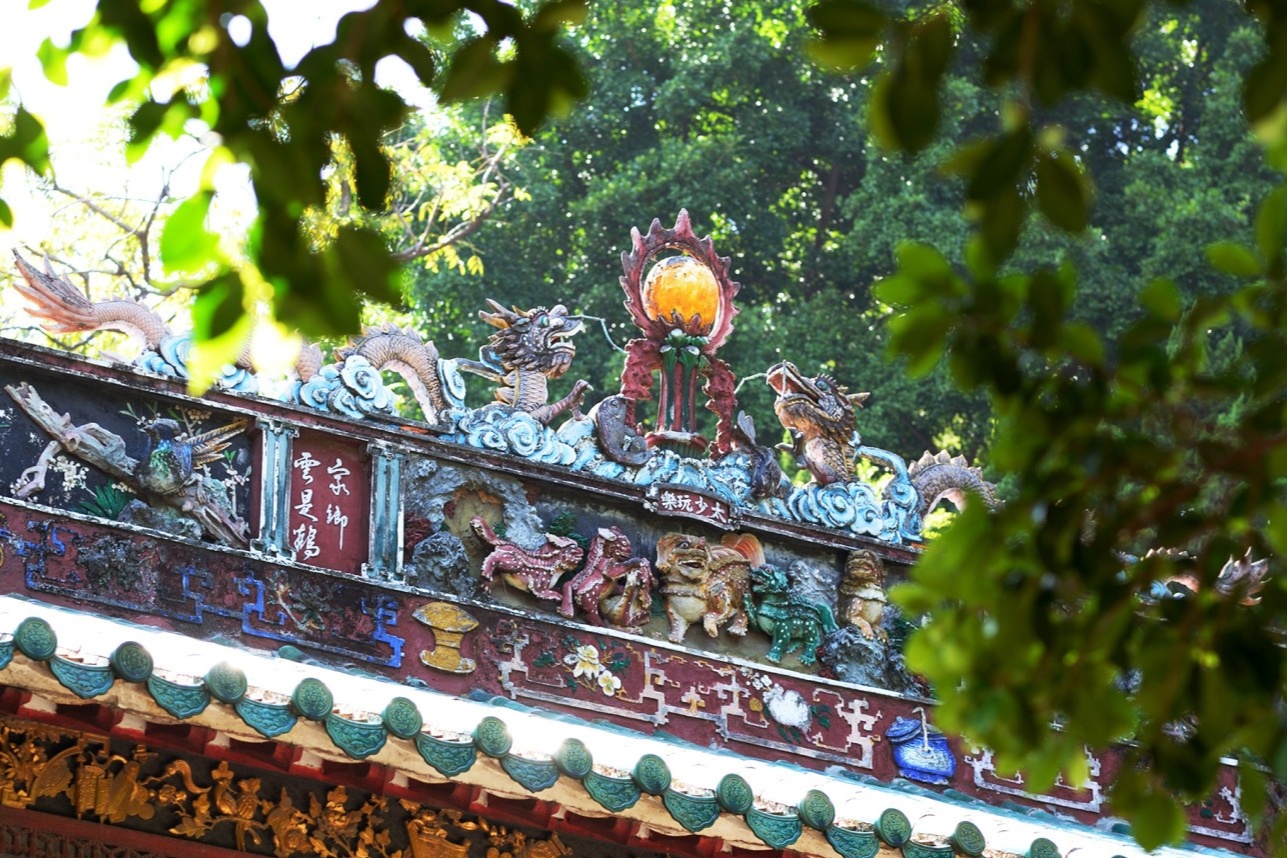
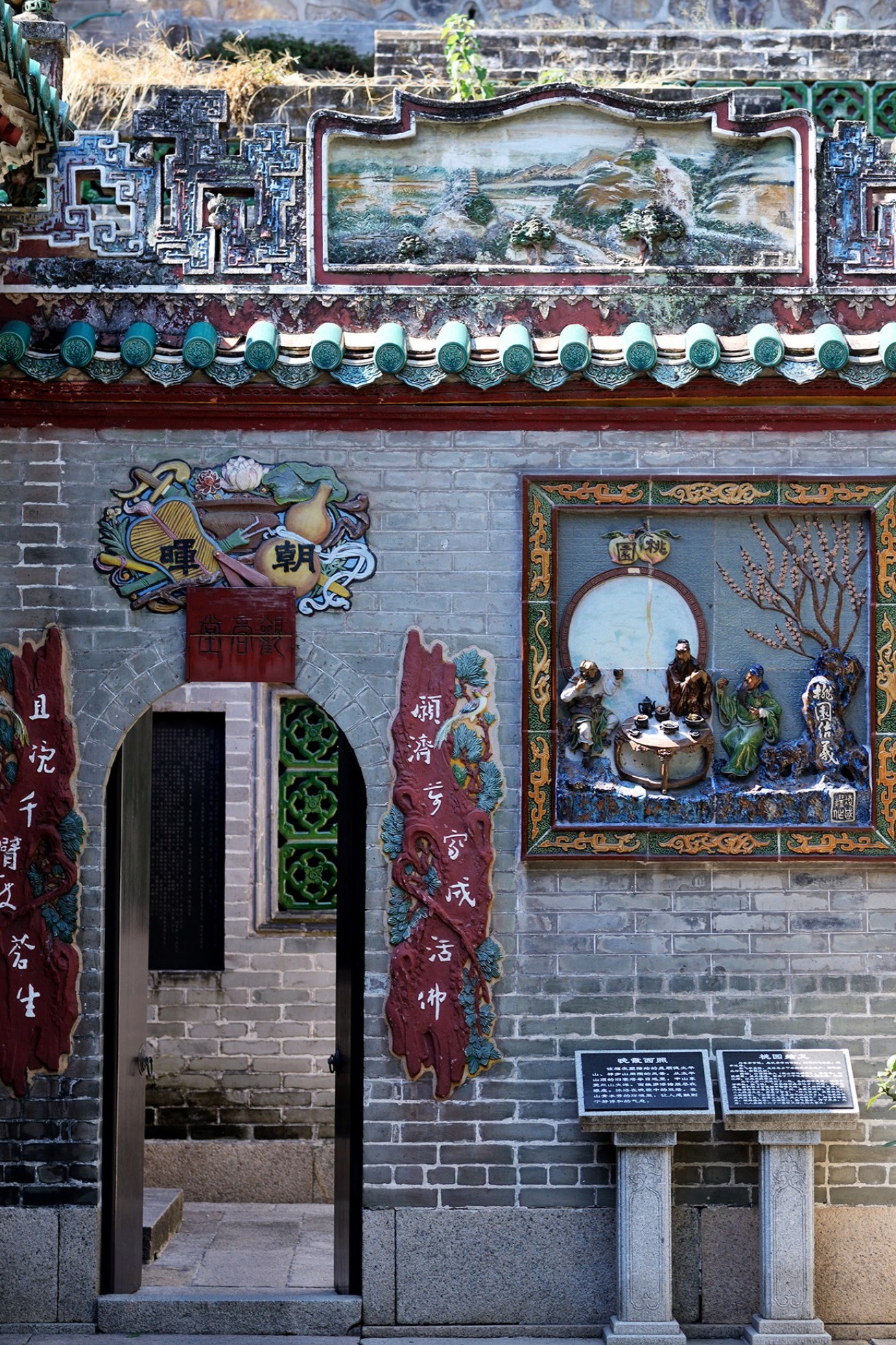
Don’t miss the pair of stone lions guarding the entrance. Their carving style is remarkable, with lines that are simultaneously rounded and powerful (`线条圆润刚劲`), giving them an air that is both majestic and surprisingly endearing.
Inside the Hallowed Halls
The temple’s interior continues the journey through history. The main hall is dedicated to a Qing Dynasty bronze statue of Guan Yu, radiating an aura of solemn dignity. To the sides, you’ll find the Guanyin Hall and the Arhat Hall. Standing guard in front of the main hall are two colossal iron cannons, both cast during the Daoguang era of the Qing Dynasty (circa 1820-1850). These are not mere decorations; they are formidable pieces of history, weighing an astonishing 4,000 and 8,000 jin (approximately 2,000 and 4,000 kg) respectively.
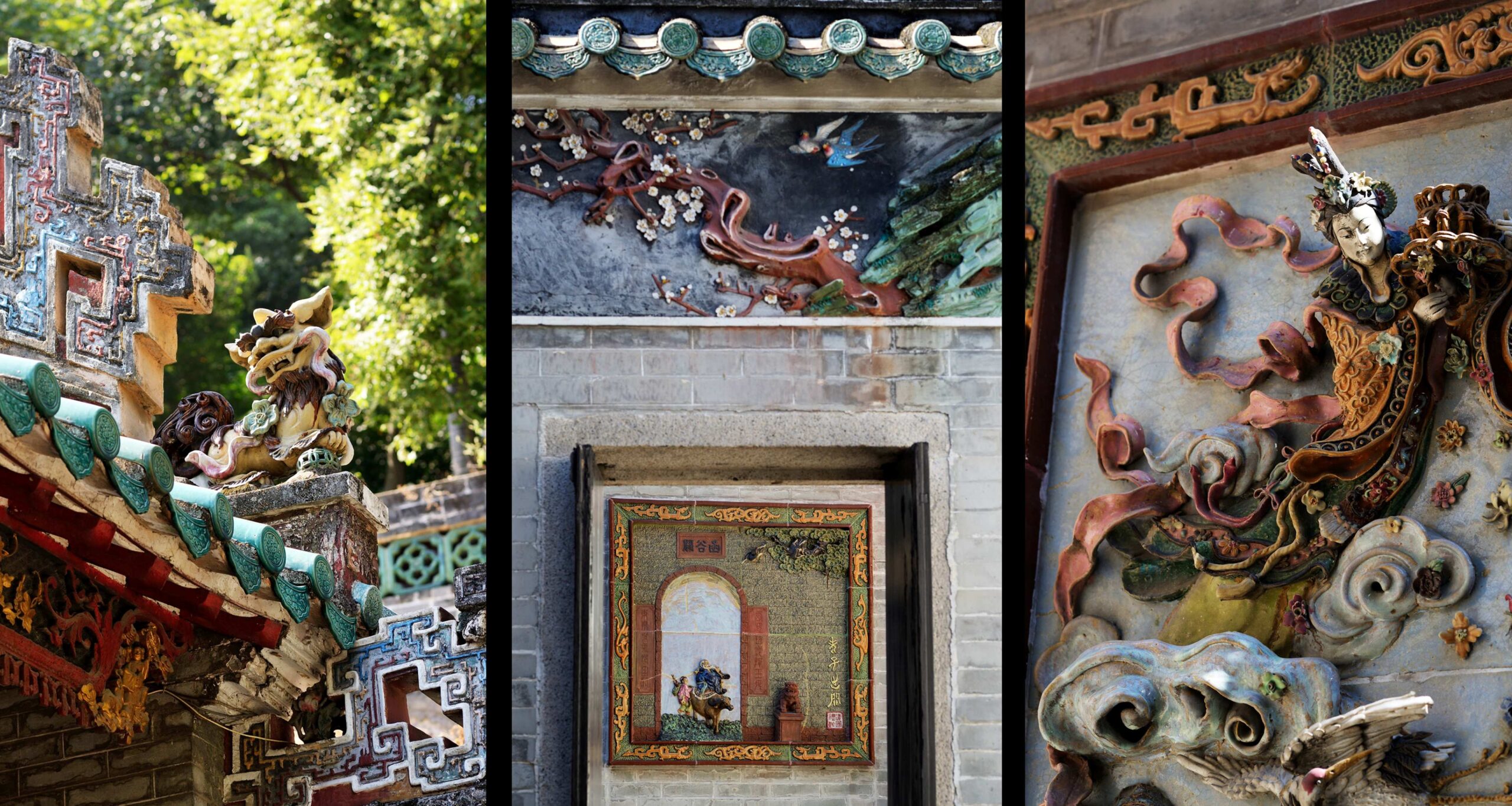
At a Glance
- Address: 顺德区大良凤山路 (Fengshan Road, Daliang, Shunde)
- Admission: Free. However, an advance reservation for a specific time slot is required. Please check official channels for booking procedures.
- Highlight: A must-see for anyone interested in traditional Chinese architecture, folk art, and the intricate crafts of pottery and carving.
- Recommended Time: Allow 45 minutes to 1.5 hours to fully appreciate the stunning details of the temple’s artwork and soak in its historical atmosphere.
Bijiang Golden House (碧江金楼)
A dazzling display of concentrated wealth and artistry, this “Golden House” was part of a dowry, featuring some of the most exquisite and lavish gilded woodcarvings in the entire region.
Tucked away in Bijiang Village, a little further from the bustling city center, lies an underrated and truly breathtaking gem: the Bijiang Golden House. While it may require a short journey, the reward is an unforgettable encounter with some of the most lavish craftsmanship in the region. Originally built during the Jiaqing to Daoguang eras of the Qing Dynasty, this structure began its life as the private library (`藏书楼`) of the powerful Su family’s estate, known as the “Zhifang Di” (`职方第`). Its name, the Golden House, is no exaggeration; it comes from the dazzling fact that nearly all of its intricate interior wood carvings are meticulously covered in shimmering gold foil (`金箔`), creating an effect of pure, unadulterated splendor.
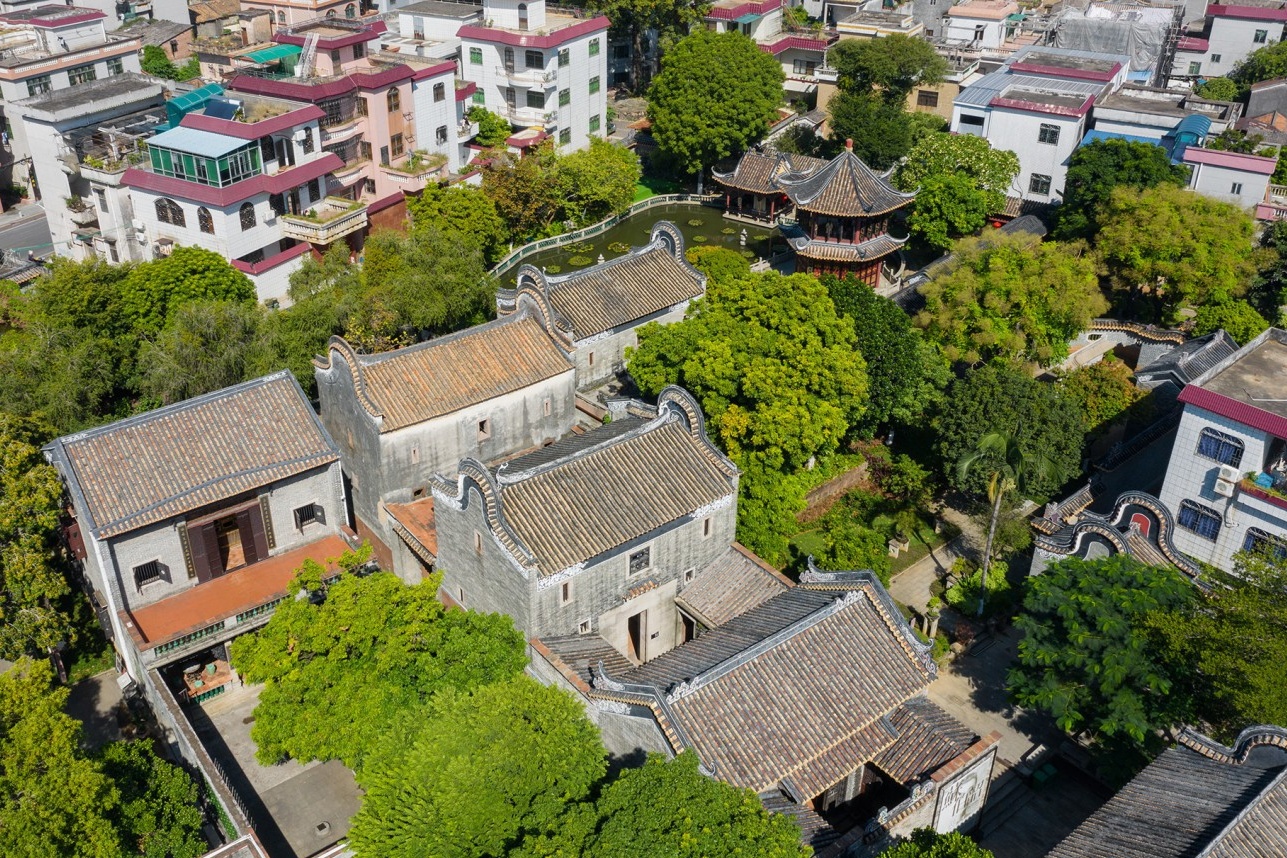
From Scholar’s Library to a Legendary Bridal Chamber
The story of the Golden House is as rich as its decor. The larger estate, “Zhifang Di,” is named after the official title held by its builder, Su Piwen (`苏丕文`), who served as a senior official in the Ministry of War (`兵部职方司员外郎`). The entrance plaque proudly announces this prestigious family history.
However, the library’s transformation into the “Golden House” is tied to a famous tale of love and status. Legend has it that the house was repurposed as a magnificent bridal chamber for a very special bride: Dai Peiqiong (`戴佩琼`). She was not only the daughter of the high-ranking Qing official Dai Hongci (`戴鸿慈`) but also the goddaughter of the formidable Empress Dowager Cixi. When she married into the Su family, they converted their treasured library into this gilded cage of beauty for her. This gave rise to a local version of the famous Chinese idiom “A golden house for a beloved lady” (`金屋藏娇`), forever linking the building with this romantic chapter of its history.
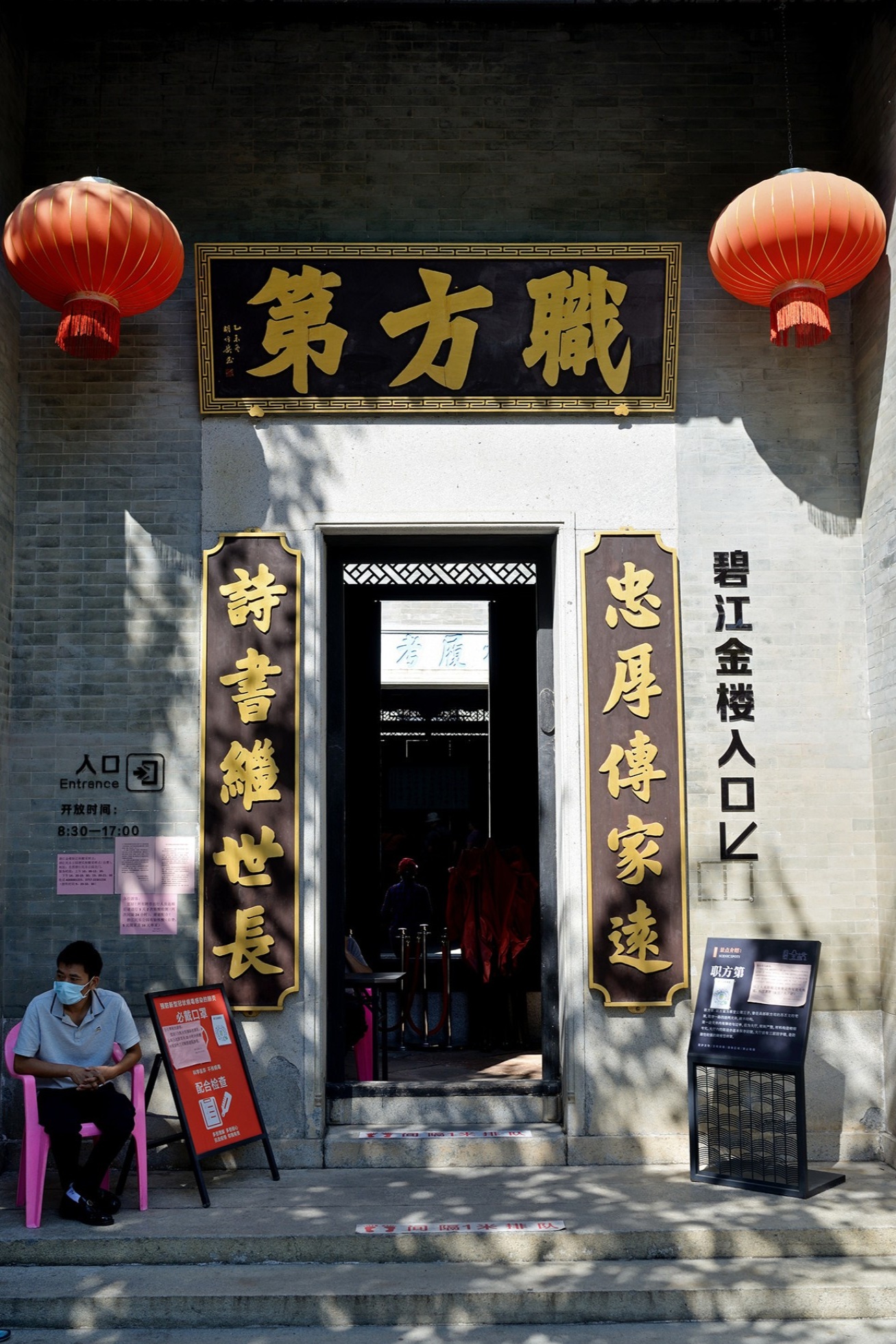
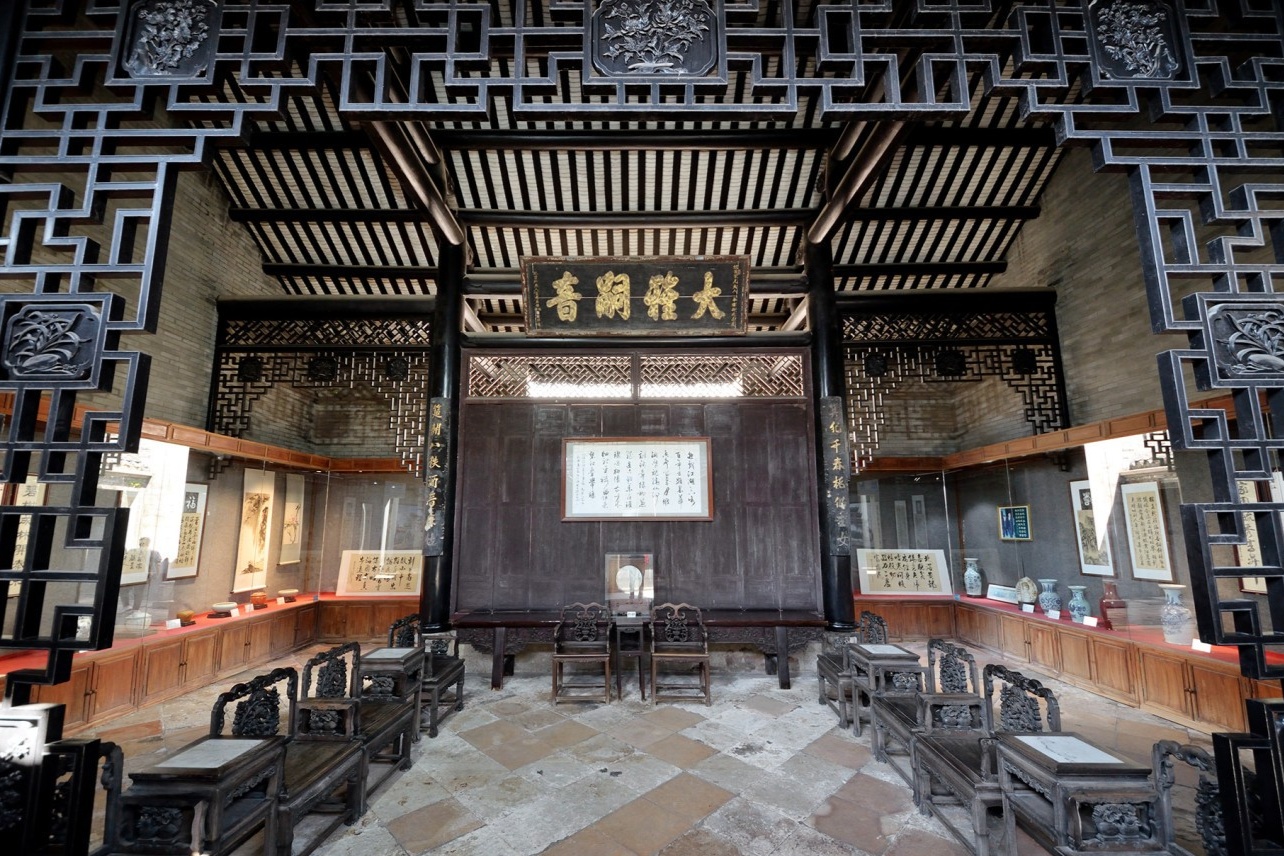
A Two-Story Masterpiece of Gilded Carvings
Prepare to be mesmerized as you step inside. The first floor offers a stunning introduction, with complex and beautiful gold-lacquered wood carvings adorning the space. To the right is a recreation of Dai Peiqiong’s bedroom, featuring a spectacular canopy bed (`跋步床`) that is itself a masterpiece of carving and opulence.
But as the saying goes, this is merely “a brick thrown to attract the jade” (`引玉之砖`). The true artistic climax awaits on the second floor. As you ascend the stairs, you enter a world of almost unimaginable luxury. The design is said to be inspired by the lavish “Zidong Ting” (`紫洞艇`) pleasure boats that once graced the Pearl River. The wooden panels are arranged in three exquisite tiers: a lower level of floral skirt boards (`雕花裙板`), a middle section of antique-style glass panels (`博古玻璃`), and an upper section of breathtakingly intricate carved brackets (`木雕铺作`).
Every inch is covered in openwork carvings of auspicious symbols—birds, flowers, mythical beasts—all gleaming with gold foil. Look for specific motifs: a pine tree and a crane symbolizing longevity (`松鹤延年`), two Qilin with a book for scholarly success (`麟吐玉书`), and three goats heralding prosperity (`三羊开泰`).
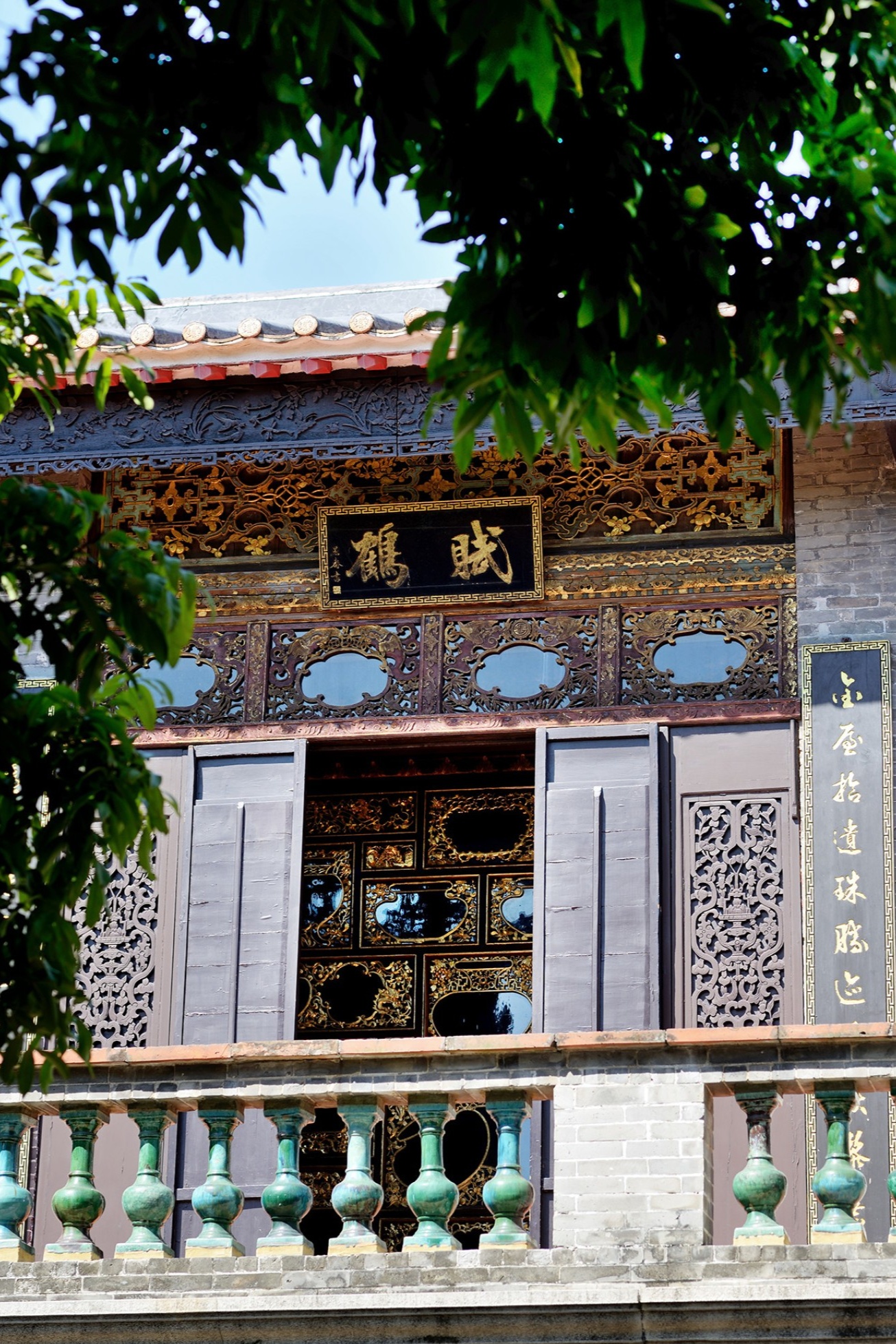
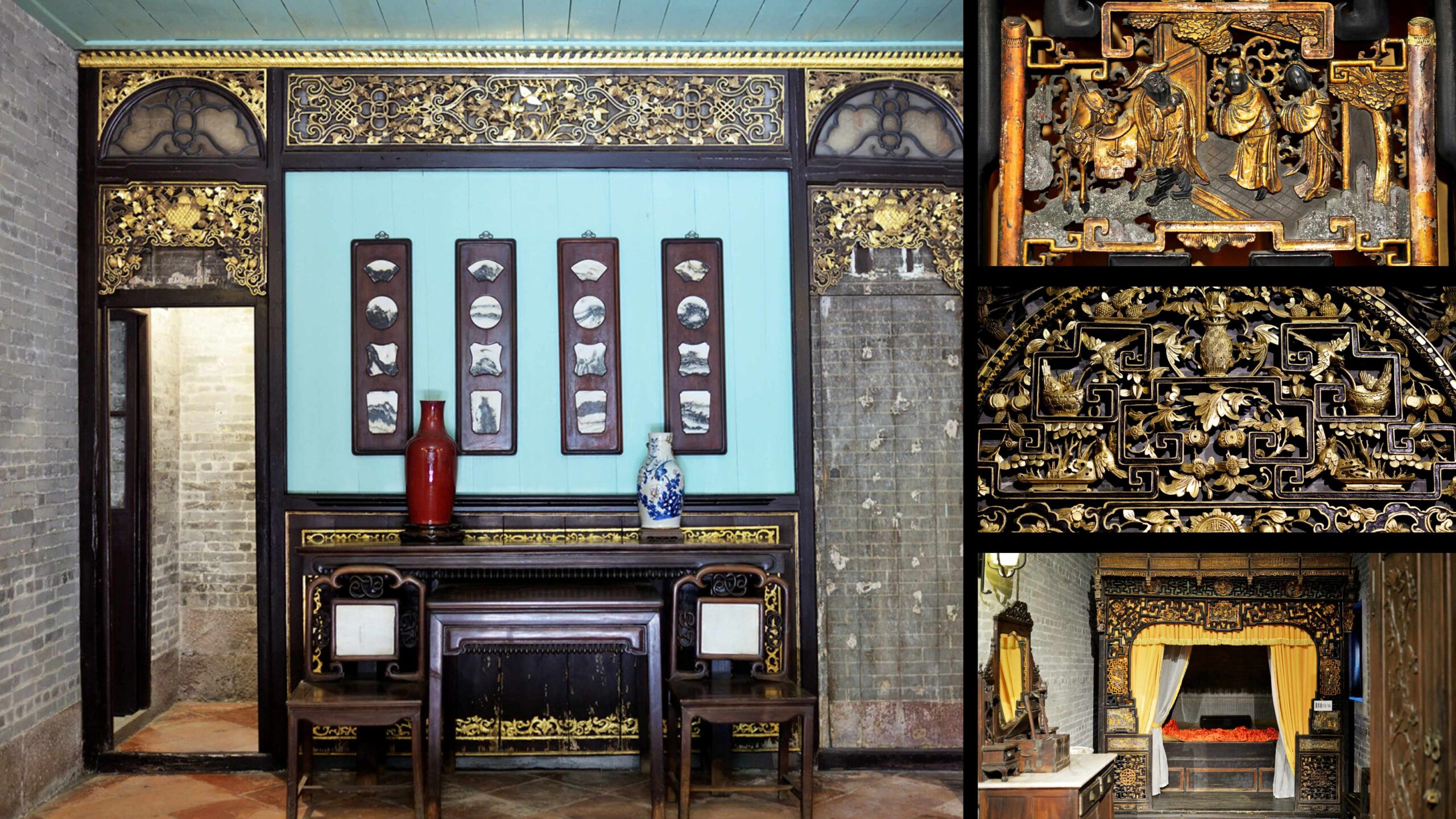
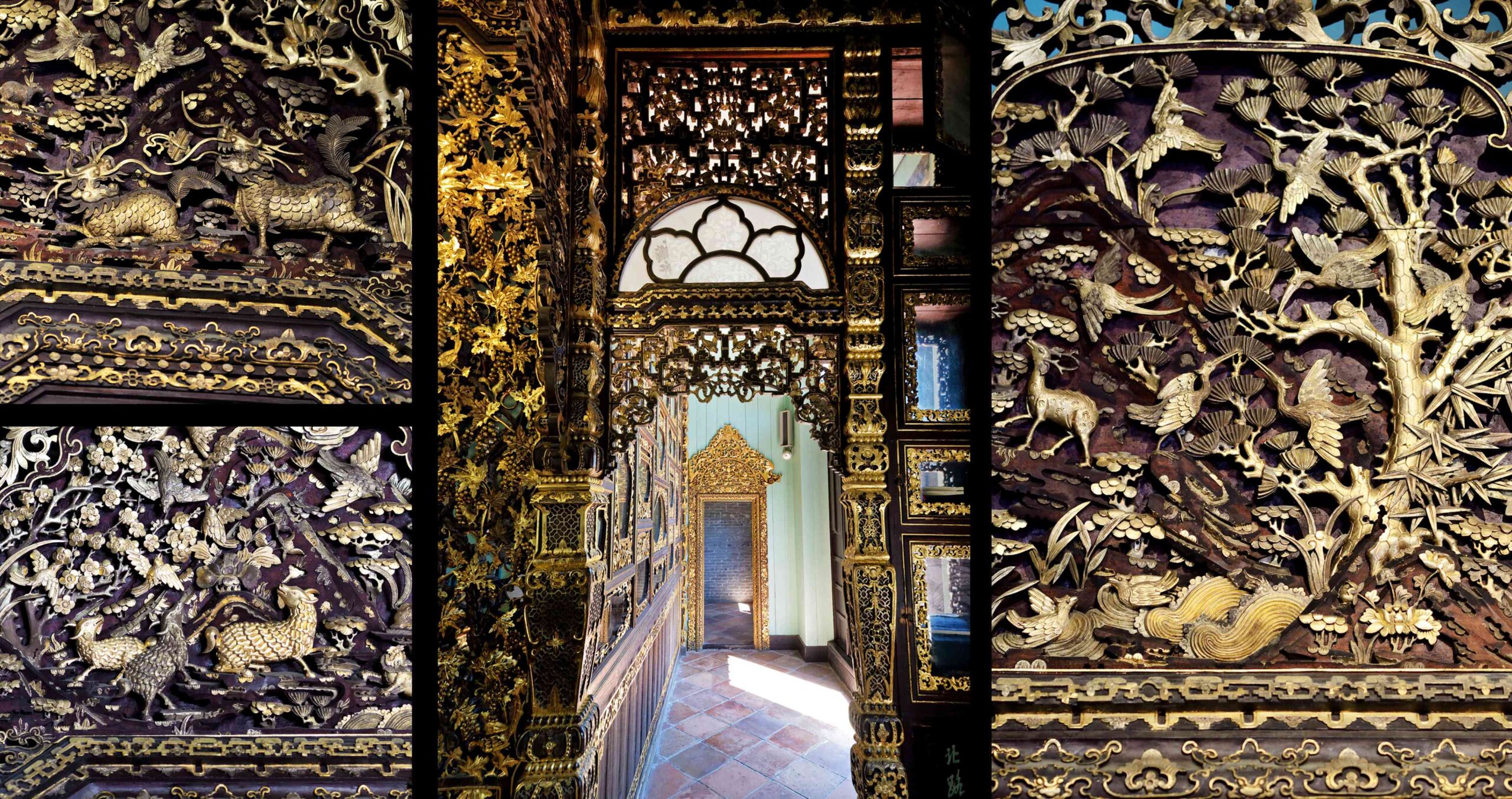
More Than Gold: A Legacy in Ink
Beyond the visual splendor of the gold, the Golden House is also a repository of priceless calligraphy. Hanging above a rosewood Luohan bed on the second floor is an original work by the bride’s father himself, Dai Hongci. The surrounding rooms and corridors feature carved reproductions of works by some of the most famous calligraphers of the Qing Dynasty, including Liu Yong (`刘墉`), a Grand Secretary and one of the most celebrated scholars of his time. These “frozen” brushstrokes in wood connect the house’s opulence to the highest echelons of Chinese literary art.
At a Glance
- Address: 顺德区北滘镇泰宁西路6号 (No. 6, Taining West Road, Beijiao Town, Shunde)
- Ticket Price: ¥15.
- The Complex: Remember that the Golden House is part of a larger complex that includes the Zhifang Di mansion, Bo Shao Medical Hall, and a tranquil rear garden, all of which are worth exploring.
- Recommended Time: Set aside at least 1.5-2 hours to fully immerse yourself in the details of the carvings, understand the history, and explore the entire estate.
Mingshi Garden (鸣石花园)
A charming and often overlooked garden that beautifully fuses traditional Chinese design with distinct European architectural elements, telling a fascinating story of a changing world.
Compared to the grand and famous landmarks of Shunde, Mingshi Garden is a true hidden treasure, a quiet retreat known mostly to locals and discerning travelers. Located in the historic Yang’e Village (`羊额村`) of Lunjiao, this garden is a captivating example of architectural fusion from the late Qing Dynasty. Though only a portion of the original estate survives, its charm is undeniable. It perfectly encapsulates the concept of “small but beautiful” (`小而美`), creating a stunning dialogue between a traditional Lingnan “Wok-handle House” (`镬耳屋`) and an elegant European Baroque-style building.
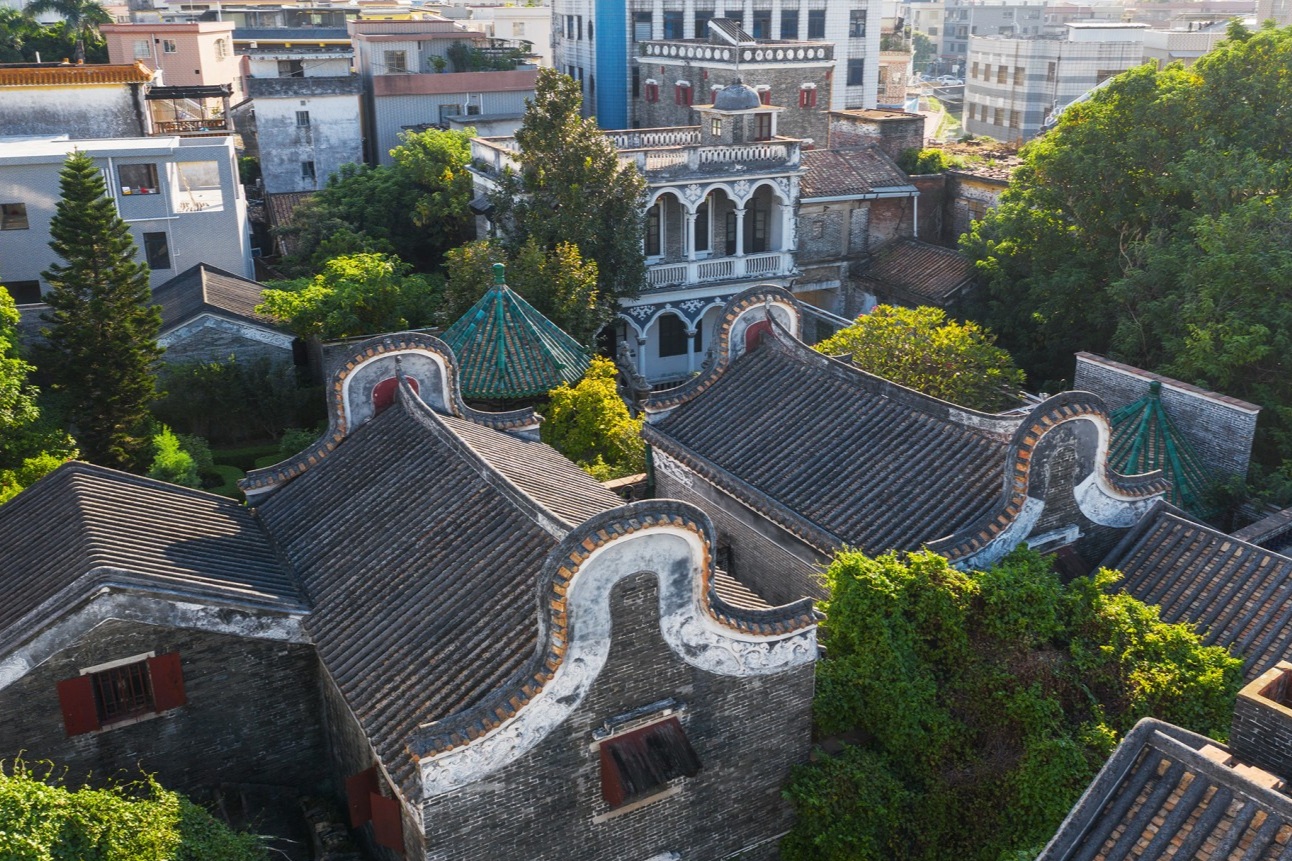
A Tale of Two Worlds: The Garden’s Origins
The garden bears the name of its original owner, He Mingshi (`何鸣石`). In the early 20th century, during the Guangxu Emperor’s reign, He Mingshi, having prospered, decided to expand his ancestral home. He commissioned a designer from Nanyang (Southeast Asia) to add a fashionable Western-style wing to his traditional residence, resulting in this unique architectural hybrid.
The garden’s story took a poignant turn in the mid-20th century. Before 1949, most of the He family had emigrated to Malaysia. The last remaining resident, the family’s “fourth wife” (`四姨太`), passed away in 1970. With no one left to care for it, the garden fell into neglect. Eventually, the He family’s descendants entrusted the property to the government. After a careful restoration that preserved its unique character, Mingshi Garden was opened to the public, allowing its quiet beauty to be appreciated once more.
An Architectural Dialogue
A visit to Mingshi Garden is a walk through two different cultures. You first enter the Chinese section, which served as the family’s living quarters. Here, you’ll find all the hallmarks of classic Lingnan architecture. Look for the iconic `wok-handle gables` (`镬耳山墙`), whose curved silhouettes resemble the handles of a Chinese wok and were a symbol of a family’s scholarly or official status. You’ll also see the ingenious `tanglong` (`趟栊`), a sliding, lattice-like wooden gate that provided security while allowing for air circulation—a clever adaptation to the humid southern climate.
Juxtaposed with this is the stunning Baroque building. Its facade features elegant columns, gracefully arched doorways, and ornate decorative mouldings, transporting you instantly to a different continent. The seamless yet distinct combination of these two styles in such an intimate space is what makes Mingshi Garden a truly special and photogenic destination.
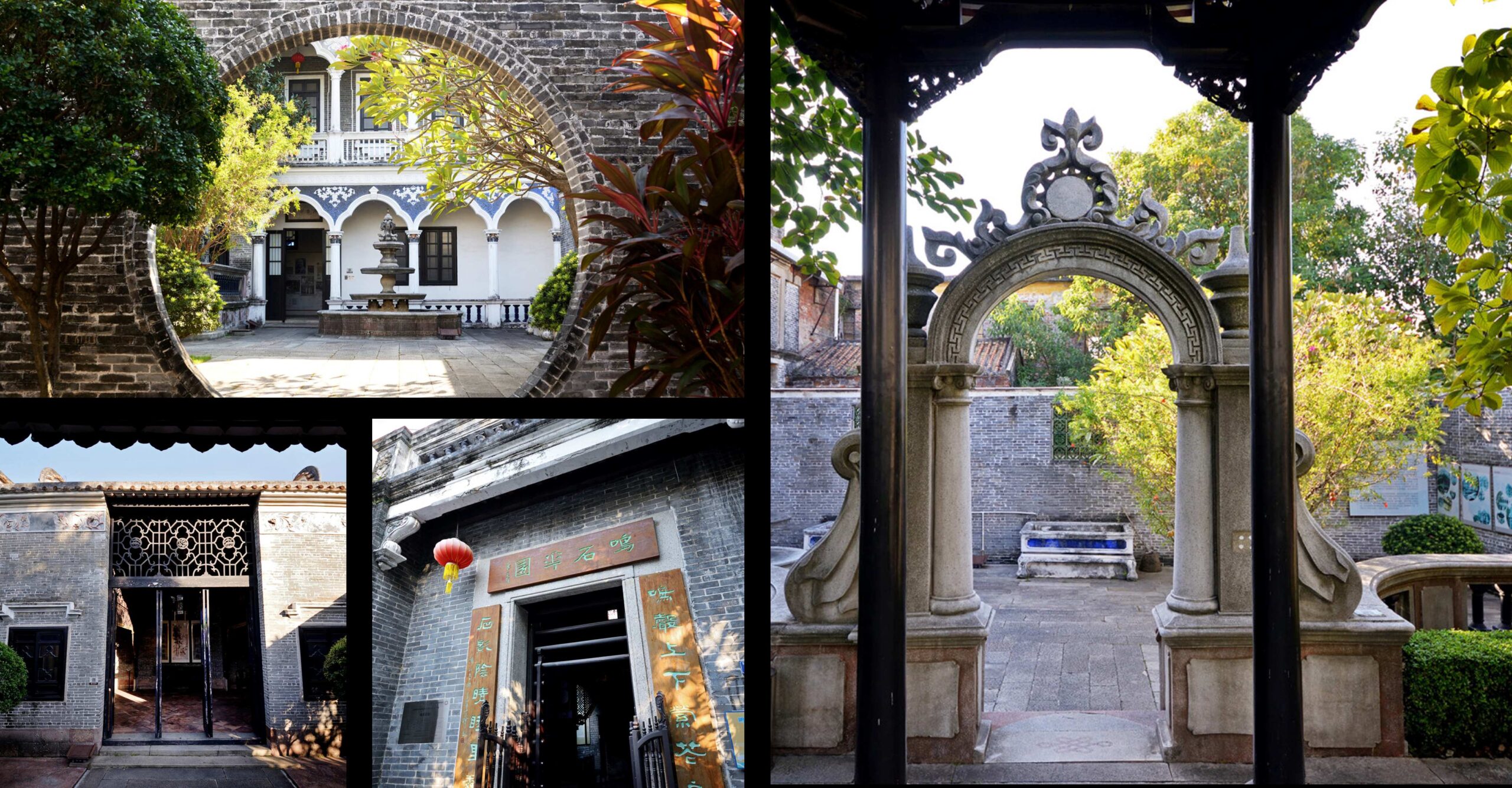
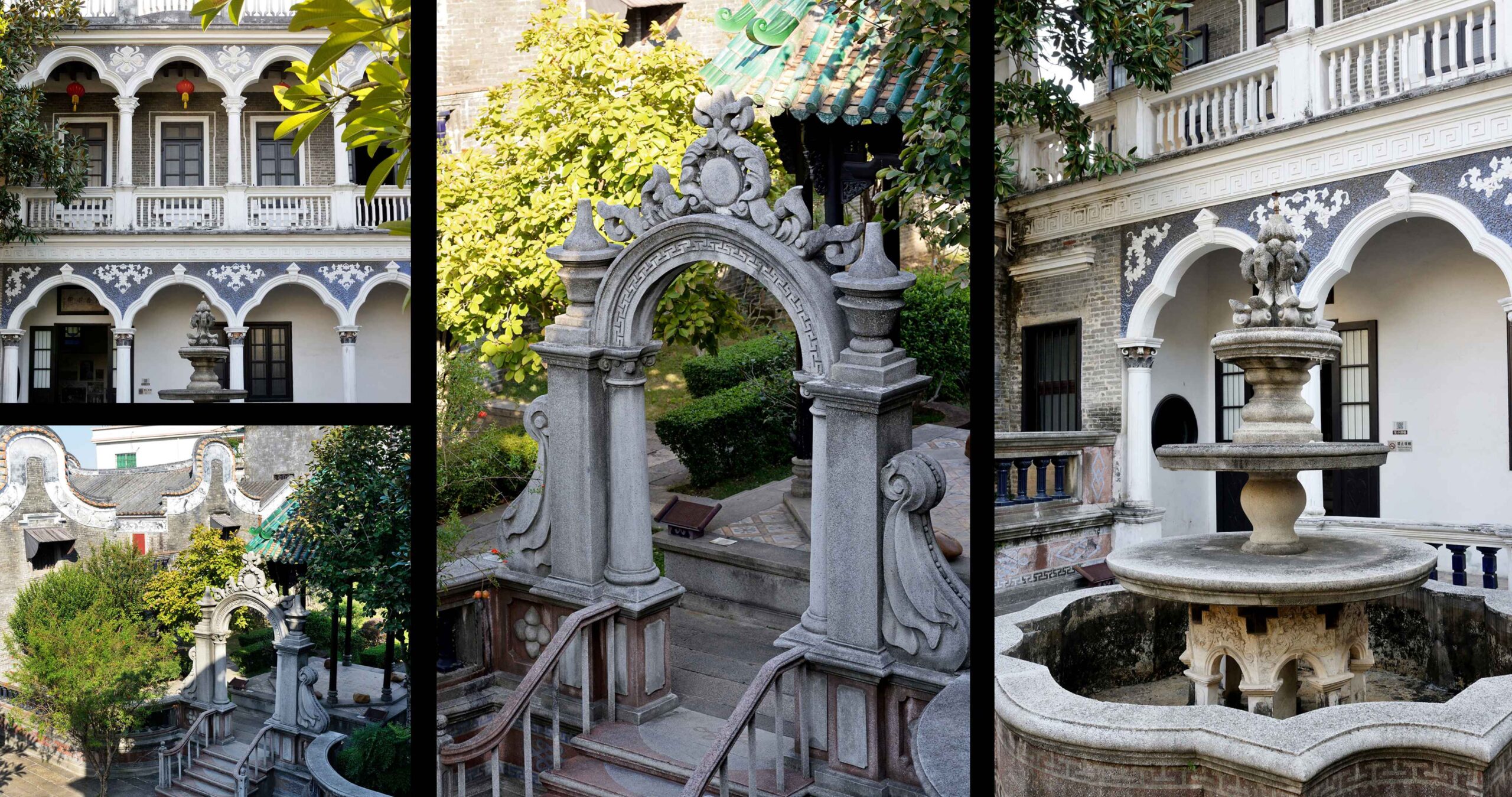
At a Glance
- Address: 顺德区伦教羊额村 (Yang’e Village, Lunjiao, Shunde)
- Admission: Free.
- Important Note: The garden closes for a lunch break, typically from 11:30 AM to 2:00 PM. Be sure to time your visit to avoid arriving during this period.
- Highlight: A perfect example of early 20th-century architectural fusion, ideal for photography and for those seeking a quiet, unique cultural spot off the beaten path.
- Recommended Time: 30 to 60 minutes is sufficient to explore this compact and beautiful garden.
Section 9: Your Travel Plan
Now that you’re acquainted with the treasures of Shunde, let’s put it all together. Here is some practical advice to help you craft the perfect journey.
Getting Around Shunde (顺德内部交通)
Shunde’s attractions are spread across different districts, so planning your transportation is key. Here are your main options:
- Ride-Hailing (网约车): Services like DiDi (滴滴出行) are the most convenient way to travel between specific points. They are widely available, reasonably priced, and save you the trouble of navigating bus routes. This is the highly recommended option for tourists.
💡 Pro Tip: To use DiDi and Maps in China, you need reliable mobile data that bypasses the firewall. I highly recommend using an eSIM from Airalo. It’s cheap, easy to install, and keeps you connected instantly. - Public Buses (公交车): The most economical option. Shunde has an extensive bus network that can get you almost anywhere, but it requires more planning and potentially longer travel times. It’s a great way to experience local life if you’re not in a hurry.
- Metro (地铁): The Guangfo Line (广佛线) connects Guangzhou to Foshan and passes through the northern part of Shunde. It’s useful for getting to areas like Bijiang Golden House (near Beijiao Station), but it doesn’t cover the central Daliang area directly.
Coming from Guangzhou or Shenzhen? The most efficient way is the High-Speed Train. Read our Complete Guide to Riding China’s High-Speed Rail to navigate the stations like a pro.
Accommodation Recommendations (住宿建议)
For the vast majority of travelers, staying in Daliang District (大良) is the best choice.
Daliang is the administrative and cultural heart of Shunde. By staying here, you’ll be within walking distance or a short taxi ride from major attractions like Qinghui Garden, Xishan Temple, Huagai Road Pedestrian Street, and OCT Harbour PLUS. More importantly, it’s a hub for countless famous restaurants, putting you at the epicenter of the culinary action.
🏨 Where to Stay in Shunde?
Staying in Daliang District is the most convenient option. Check the best rates and availability for foreigner-friendly hotels here:
👉 Check Hotel Prices in ShundeTrusted by millions for travel in China via Trip.com
- Luxury & Upper-Mid Range: You’ll find international brands like Marriott and Sheraton, offering premium comfort and services.
- Mid-Range & Boutique: There are numerous comfortable and stylish hotels, including chains like Atour and Vienna Hotel, which offer excellent value. Many are located around the Qinghui Garden area.
- Budget-Friendly: A wide selection of clean and reliable budget hotel chains are also available throughout Daliang.
Suggested Itinerary
To make your culinary journey smoother, we’ve designed a three-day “Food & Culture Highlights” tour. This itinerary focuses on the two main culinary hubs, Daliang and Ronggui, logically arranging dining and sightseeing to help you fully experience the charm of Shunde within a limited time.
Day 1: Classic Daliang Culture & Cuisine
-
Morning:
Start in the cultural heart of Shunde. Head to Qinghui Garden, one of the four great classical gardens of Lingnan. Spend 2-3 hours strolling through its exquisite layout and tranquil atmosphere. Remember to book tickets in advance.
-
Lunch:
After visiting Qinghui Garden, take a short walk to Shunde Renjia Restaurant. Enjoy an authentic Shunde feast here. Must-try dishes include Daliang Fried Milk and Shunde Pan-fried Fish Cakes.
-
Afternoon:
After lunch, wander down Huagai Road Pedestrian Street to find street snacks like Ximei Wu Xiang Niu Za (Five-Spice Beef Offal), paired with a cup of sweet sugarcane juice. Then, explore Jinbang Street to taste the crispy-on-the-outside, tender-on-the-inside Fried Milk at Jinbang Laojiefang, and have a bowl of the purest Double-Layer Milk Pudding at the legendary Jinbang Milk Store (be mindful of its unpredictable opening hours).
-
Dinner:
For dinner, choose the highly-acclaimed Yanghuili·Specialty Shunde Cuisine to experience refined Shunde dishes that blend tradition with innovation, such as the signature Roasted Goose and Herbal Pork Ribs.
-
Late Night:
End a perfect day with a warm bowl of congee. Go to Xiongmei Sheng Gun Zhou (Brother & Sister’s Congee) and order their signature pork liver and beef congee. Don’t forget to pair it with youtiao (fried dough sticks) to experience the local Shunde nightlife.
Day 2: A Deep Dive into Ronggui’s Cuisine
-
Morning Tea:
Experience the Cantonese morning tea culture at the grand Long’s Restaurant in Daliang. Savor classic dim sum like shrimp dumplings and siu mai in a lively atmosphere to fuel up for the day trip to Ronggui.
-
Lunch:
Drive to Ronggui and visit Longqiao Private Kitchen, hidden within a park. Their Four Seasons ‘Lao’ Chicken and Pan-fried Cuttlefish Cake with Crab Roe will offer a delightful culinary surprise.
-
Afternoon:
In the afternoon, take a leisurely stroll around areas like Ronggui’s Fisherman’s Wharf to experience a waterside town atmosphere different from Daliang’s, and save room for the evening’s feast.
-
Dinner:
Tonight’s main event is at Song Ji Restaurant in Ronggui. Experience the essence of “clear soup hot pot” and witness how the freshest pork offal blossoms into ultimate deliciousness in the boiling water. This is a can’t-miss pilgrimage for any food lover in Shunde. It’s recommended to go early to queue.
-
Late Night:
If you still have energy after dinner, consider returning to Daliang and heading to Guoying Stewed Soup Shop. Have a serving of Silkie Chicken Soup stewed in a whole coconut. End the day’s food exploration with a warm, nourishing soup to soothe your body and soul.
Day 3: Creative Dim Sum & Rustic Sights
-
Morning Tea:
Enjoy a creative morning tea at Fengcheng Restaurant. Their Green Peppercorn & Lily Dumplings and “Imperial Concubine” Lychee Balls are a feast for both the eyes and the palate.
-
Lunch:
Experience a feast for both sight and taste at Dadi Farmstead. Watch the spectacular “Flaming Drunken Goose” performance and witness the perfect fusion of rice wine and goose meat amidst blazing flames.
-
Afternoon:
Drive to Beijiao Town to visit Bijian Golden House and admire its magnificent and masterfully crafted interior wood carvings. If time permits, you can also visit the nearby Dashutou Dessert Shop for a refreshing bowl of Sugarcane, Kudzu Root & Water Chestnut Sweet Soup and try their fried sweet potatoes.
-
Dinner / Farewell Meal:
Put a perfect end to your Shunde journey. Head to the elegant Tianranju Restaurant for a farewell dinner amidst garden scenery. Savor authentic flavors like Steamed Dace with Salt and Oil or Salt-baked Prawns as you reminisce about the culinary memories of the past few days.
Part V: Final Reflections
Section 10: Conclusion (结语)
Shunde is not a place you simply visit; it’s an experience you savor. It’s a dual journey that delights the palate and nourishes the soul, a place where the sizzle of the wok is as profound as the silence of an ancient garden.
From the first, silky spoonful of Double-Layer Milk Custard to the last, lingering look at a carved temple roof, Shunde weaves a spell. It’s a city that reveals its character through its flavors—each dish a story, each recipe a legacy. Here, food is not just sustenance; it is culture, it is art, it is the language of life itself.
But beyond the celebrated cuisine lies a deep well of history. You’ll find it in the tranquil ponds of Qinghui Garden, reflecting centuries of scholarly contemplation. You’ll see it in the golden glow of a dowry house, a testament to immense love and artistry. And you’ll feel it in the vibrant, living temples, where faith and folk art burn as brightly as the incense.
Whether you come as a dedicated foodie on a pilgrimage or a curious traveler seeking authentic culture, you will leave with more than just memories. You’ll leave with a full stomach, a full heart, and a deeper appreciation for a city that has perfected the art of living well. Shunde is waiting to share its feast with you.
🍽️ Where to Eat Next? Complete Your Guangdong Food Map
Shunde is the peak, but the journey doesn’t end here. Explore the other legends of Cantonese cuisine:
Your unforgettable journey awaits!
Enjoyed this article? Consider buying me a coffee to support more content like this!
💖 0 people have clicked to support this article.

